Acquisitions & Art Consultancy



APRIL 2019– MARCH 2021
Contemporary Art Society
59 Central Street, London EC1V 3AF
Tel: +44 (0)20 7017 8400
Email: info@contemporaryartsociety.org
Website: contemporaryartsociety.org
Follow us on social media
/thecontemporaryartsociety
contemporaryartsociety
@ContempArtSoc
Every effort has been made to contact all copyright holders. If proper acknowledgement has not been made, please contact the Contemporary Art Society. All rights reserved. No part of this publication may be reproduced, stored in a retrieval system or transmitted in any form or by any means, electronical, mechanical or otherwise, without first seeking the written permission of the copyright holders and of the Contemporary Art Society. Images cannot be reproduced without prior permission from the Contemporary Art Society.
Date of publication: June 2021
Edited by Marcus Crofton, Caroline Douglas, Jordan Kaplan, Fabienne Nicholas, Christine Takengny, Uma Karavadra and Jessica Lowe-Mbirimi
Designed by Hyperkit
Cover image: Alexandra Bircken, The Doctor, 2020. Steelbase, mannequin, fabric, wadding, thread, metal, prosthesis, wood and boat model.
183 x 62 x 60 cm
© Courtesy of the artist and Herald St, London
In recent years we have published our Acquisitions book to coincide with our annual dinner. Usually falling in late June or early July, this has become an important milestone in our calendar, and we have enjoyed memorable summer evenings at great venues such as Dulwich Picture Gallery and the Foundling Museum. Our annual dinner is the moment when we come together with our patrons, artists, trustees and museum colleagues to celebrate all that has been achieved in the preceding year. In 2020 we were to have assembled at the National Gallery. This pandemic put a swift end to that plan and made us all the more aware how vital a part of our role it is to convene this unique and special group of people. As it was, our last gathering, just a couple of days before the country went into the first lockdown, was the unforgettable evening spent with Grayson Perry in his studio, hosted by the inimitable Chris Kneale.
As we write this it is still not certain that we will be able to meet the more modest ambition of a cocktail party in early July – such is the progress of the pandemic. Nonetheless, we are proud to publish the record of two years’ acquisitions for museums in this book. Across the two financial years, 2019–20 and 2020–21, the total value of the works placed with museums approached £2.6M.
The 2020 Rapid Response Fund campaign exceeded all our expectations in the way it elicited such an overwhelming response from the general public, as well as the generosity of our longstanding supporters. The artists who so brilliantly responded with designs for the facemasks – Linder Sterling, Eddie Peake, Yinka Shonibare and David Shrigley – were part of a moment that will go down in history. We are indebted to all the members of the Collections Fund who, without hesitation, agreed to redeploy their contributions to the Rapid Response Fund. Béatrice Lupton continues to be the mainstay of this fund, and her encouragement through the designing of the Rapid Response Fund was absolutely critical to its success. Through the summer of 2020 we were able to make substantial acquisitions of art and craft for our Museum Members, recognising how the purchases could be much-needed income for the artists, as well as an encouragement to museums battling with successive lockdowns and confronting the consequences of income decimated by protracted periods of closure. Works with a value of more than £300,000 were donated through the Rapid Response Fund and represent the Society’s creditable response to the crisis.
The year 2020 was also marked by the Black Lives Matter protests that took place across the world. Within the visual arts community here, they served to accelerate the moves towards greater representation and diversity within programmes and collections that we had been supporting for several years. In 2019–20 more than 50% of our total investment in art and craft was spent on purchasing work by artists of colour. In 2020–21 this rose to over 56%. In the pages of this publication, you will see wonderful works by Sonia Boyce, Claudette Johnson and Keith Piper, as well as works by a younger generation of artists including Rachel Jones, Jade Montserrat and Samson Kambalu.
The 2019–20 financial year was notable for some wonderful gifts, including the five-vitrine installation offered to Nottingham Castle Museum by Edmund de Waal on the occasion of his memorable Artists’ Table event, hosted by Jill Hackel in November 2019. Special mention must also be made of the works on paper by the South African artist Lisa Brice that were donated to The Whitworth in Manchester, thanks to the generosity of Holly Peterson and Stephen Friedman Gallery. The bequest of ceramics from the collection of the late Patricia Barnes saw over 100 pieces enter the collections of the Centre for Ceramic Art at York Art Gallery, MIMA in Middlesbrough and the burgeoning ceramic collections at The Hepworth Wakefield. An American, who divided her time between Chicago and London, Patricia was an important patron to a pioneering group of ceramicists around the Royal College of Art through the 1970s, 80s and 90s. Groups of works by Alison Britton, Jacqueline Poncelet, Carol McNicholl and Angus Suttie, among others will now represent this moment of radical practice within these three UK collections.
Alongside this, we were delighted to be able to work with Thalia Allington-Wood, daughter of the late sculptor Edward Allington, to place an important group of sculptures and drawings in three collections. Allington came to prominence in the UK and internationally during the late 1970s and 1980s and was highly influential in his practice and later, as a teacher. This bequest ensures that his contribution to the history of sculpture in this country is safeguarded within specialist sculpture collections.
Collaboration with Art Night in the summer of 2019 lead to the acquisition of five drawings by Oscar Murillo for Bristol Museum & Art Gallery thanks to the support of our trustee Emma Goltz and her husband, Fred. In the same year, the Search Foundation, through Bertrand Coste, contributed the critical last part of the funding to enable the National Museum of Wales and The Towner, Eastbourne to co-acquire John Akomfrah’s magisterial film essay Vertigo Sea (2015).
Valeria Napoleone’s VNXXCAS project continues to be one of the most popular schemes that we run, and as it enters its sixth year we have built up an impressive track record. Thus this publication records two major acquisitions through the project: firstly a key and early film work by the American artist Mary Kelly, who lived in London in the 1970s and whose importance within the history of conceptual art in this country cannot be overstated. Her contribution to feminist discourse within the visual arts continues to be a touchstone. Antepartum (1973) is iconic in the true sense of the word, as well as mesmerisingly beautiful. We are grateful to the artist herself for generously making this acquisition possible for Royal Pavilion and Museums Trust, Brighton and Hove, the only collection in the UK to hold the work.
Alexandra Bircken’s The Doctor (2020) was purchased from her most recent exhibition at Herald Street Gallery for The Hunterian at the University of Glasgow. The human-scale figure with Christmas-tree prosthetic leg and beak, or boat-like
head mutely asserts its mysterious presence and will bring a destabilising quality to the rationalist, Enlightenment collections of the museum.
In the Autumn of 2019, the members of the Collections Fund at Frieze were able to acquire a group of 11 works by the celebrated South African artist and activist Zanele Muholi, whose acclaimed solo exhibition has recently reopened at Tate Modern. These moving and powerful portraits of individuals from the LGBTQ+ community in South Africa will form a part of the re-opening displays at Nottingham Castle Museum.
Although we had to pause the scheme in 2020–21, in 2019–20 we acquired three significant works for The Hepworth Wakefield through the Special Partnership with the Henry Moore Foundation supported by Cathy Wills. These were sculptures by Steve Claydon, Michael Dean and Magali Reus. All three will be part of the new collection displays at the gallery in 2022.
In the 2020–21 financial year, the single most outstanding acquisition has been of Mona Hatoum’s Electrified (variable III) (2021). A five-metre column of domestic implements with an electric current running through them hanging from the ceiling, the sculpture produces sensations of recognition and threat at the same time. Hatoum is one of the most important artists working in Britain today and we are proud to be able to acquire her work for The Hepworth Wakefield, our fourth major purchase through the Great Works scheme, generously enabled by the Sfumato Foundation.
In 2019–20 28 museums received work through the Contemporary Art Society and in 2020–21 this number rose to 33. During the period we have been delighted to welcome the Doncaster Museum as a returning member museum, as well as Leicester Museum & Art Gallery after a brief period of absence. This takes the total number of museums to 71. We are proud to present this record of our achievements to you; as ever, they represent the collective efforts of very many people, only a fraction of whom we can mention by name here. We offer our heartfelt thanks to all those who have worked alongside us through the last two years to achieve these results, the effects of which will be felt for generations to come.
Marco Compagnoni, Chairman Caroline Douglas, Director
Notwithstanding many challenges this year, our recent activity has enabled the Contemporary Art Society to continue to champion the most exciting artists of the day, as it has done since its inception in 1910. Approaching our 111th anniversary, we want to ensure that our core mission – of donating the best new art and craft to museums around the UK – continues for another century and more. In 2019 we launched the CAS Future Fund, to support the future of our highly successful museum acquisitions programmes.
The CAS Future Fund will ensure:
The best artists of our time are discovered and nurtured. The Contemporary Art Society can continue its great track record of spotting talent ahead of the curve and accelerating artists’ careers by placing their work in public collections, thereby giving them the public endorsement they deserve at a critical moment.
The Contemporary Art Society can continue to donate work to important museums and galleries across the UK, many of which would not be able to collect any contemporary art without its support.
You can be part of the CAS Future Fund by remembering the Contemporary Art Society in your Will. Every legacy gift we receive will be invested in the CAS Future Fund to support museum acquisitions of the future, making a vital difference to contemporary art and creating enduring support for new generations of artists and museum audiences.
You can also choose to support the CAS Future Fund during your lifetime, and the Contemporary Art Society would be delighted to discuss any fundraising ideas for this great cause.
For more information on the CAS Future Fund, or to request a brochure, please contact Dida Tait, Head of External Relations
dida@contemporaryartsociety.org 020 7017 8400
Aberdeen Art Gallery (p.82, p.144)
Amgueddfa Cymru – National Museum
Wales (p.84, p.86, p.146)
Ashmolean Museum of Art & Archaeology, Oxford (p.88)
Atkinson, Southport (p.182)
Birmingham Museums Trust (p.180, p.184)
Box, Plymouth (p.92, p.148)
Bristol Museum and Art Gallery (p.66, p.94, p.96, p.150)
Bury Art Museum (p.98)
Cartwright Hall Art Gallery, Bradford (p.100, p.152)
Collection and Usher Gallery, Lincoln (p.102)
Graves Gallery, Museums Sheffield (p.20, p.154, p.170)
Gallery of Modern Art (GoMA), Glasgow Museums (p.18, p.78)
Grundy Art Gallery, Blackpool (p.104)
Guildhall Art Gallery (p.186)
Harris, Preston (p.22, p.156)
Hepworth Wakefield (p.14, p.24, p.61, p.170, p.173)
Herbert Art Gallery & Museum, Coventry (p.26)
Huddersfield Art Gallery (p.106)
Hunterian, University of Glasgow (p.28, p.72)
Laing Art Gallery, Newcastle upon Tyne (p.30)
Leamington Spa Art Gallery and Museum (p.108)
Leeds Art Gallery (p.32)
Manchester Art Gallery (p.34, p.173)
McManus: Dundee’s Art Gallery & Museum (p.110)
Mead, University of Warwick Art Collection (p.112)
Middlesbrough Institute of Modern Art (MIMA) (p.36, p.158, p.171, p.173)
New Art Gallery Walsall (p.40)
Norwich Castle Museum (p.114)
Nottingham Castle Museum (p.56, p.116, p.160, p.174)
Pallant House Gallery, Chichester (p.42, p.118)
Potteries Museum & Art Gallery, Stoke-on-Trent (p.120)
Reading Museum (p.44)
Royal Albert Memorial Museum & Art Gallery, Exeter (p.46)
Royal Pavilion and Museums Trust, Brighton and Hove (p.48, p.68, p.122, p.162)
Rugby Art Gallery and Museum (p.124)
Southampton City Art Gallery (p.126, p.164)
South London Gallery (p.128)
Sunderland Museum & Winter Gardens (p.130)
Tate (p.132)
Towner, Eastbourne (p.86, p.134)
Tullie House Museum & Art Gallery, Carlisle (p.188)
Victoria Gallery & Museum, University of Liverpool (p.52)
Walker Art Gallery, National Museums Liverpool (p.54)
Whitworth, Manchester (p.136)
York Art Gallery (p.138, p.168)
LONDON
1
2
3
4
10
12
SOUTH
WEST MIDLANDS
22
23
24
25
26
27
EAST MIDLANDS
30
33
Audrey Burton Gallery, University of Leeds
42 York Art Gallery
NORTH EAST
43 Hatton Gallery, Newcastle University
44 Laing Art Gallery, Newcastle upon Tyne
45 Middlesbrough Institute of Modern Art (MIMA)
46 The Shipley Art Gallery, Gateshead
NORTH WEST
48 Abbot Hall Art Gallery, Kendal
49 The Atkinson Gallery, Southport
50 Blackburn Museum & Art Gallery
51 Bury Art Museum
52 Gallery Oldham
53 Grundy Art Gallery, Blackpool
54 Harris, Preston
55 Manchester Art Gallery
56 Peter Scott Gallery, Lancaster University
57 Touchstones Rochdale
58 Tullie House Museum and Art Gallery, Carlisle
59 University of Salford Art Collection
60 Victoria Gallery & Museum, University of Liverpool
61 Walker Art Gallery, National Museums Liverpool
62 The Whitworth, Manchester
63 Williamson Art Gallery & Museum, Birkenhead
SCOTLAND
64 Aberdeen Art Gallery & Museums
62 Gallery of Modern Art (GoMA), Glasgow Museums
66 National Museums Scotland, Edinburgh
67 The Hunterian, University of Glasgow
68 The McManus: Dundee’s Art Gallery & Museum
69 The Pier Arts Centre, Stromness
70 Scottish National Gallery of Modern Art, Edinburgh
WALES
70 Amgueddfa Cymru – National Museum Wales
71 Glynn Vivian Art Gallery, Swansea
‘I have often used magnetism or electricity to demonstrate that life forces animate even the most inert materials. In Electrified (variable III) a fluctuating electric current passes through the kitchen utensils and chairs strung together to complete the circuit to a light bulb, showing that there is something alive in each one.’
Mona Hatoum, artistMona Hatoum
Electrified (variable III)
2021
Kitchen utensils, furniture, electric wire, light bulb and variable transformer
538 x 250 x 300 cm
The Great Works scheme, generously supported by the Sfumato Foundation, aims to tackle the absence in UK museums of works by major British artists of the last 20 years. Electrified (variable III) has been created especially for The Hepworth Wakefield by Mona Hatoum, one of Britain’s most celebrated artists. Hatoum established a significant reputation during the 1980s and was included in seminal exhibitions exploring Black and Asian artists in post-war Britain. She works in a variety of media, from sculpture to large scale installations comprised of everyday objects and utensils to interrogate displacement and otherness. Hatoum’s work has narratives of diversity and inclusion at its core, which encourage audiences to consider their own place within the hierarchy of social and power relations.
Encompassing a whole room, Electrified (variable III) is a work of magnificent scale and presence. It is the largest of works in this series, extending over 6ft, and includes two chairs, a colander and a light bulb, among other objects. The fluctuation of the light in the bulb creates a sense of unease and disquiet. When viewed in person, Hatoum’s installations create many transformative juxtapositions, such as familiar to strange and homely to uncomfortable.
The Hepworth Wakefield has been addressing how traditional narratives of 20th-century contemporary British art reflect concerns of the present moment to uncover histories that speak to a diversity of experience. Hatoum was nominated for The Hepworth Prize for Sculpture in 2018. Her installation was voted
the ‘people’s choice’ by the audiences who found Hatoum’s way of using familiar objects to reflect upon complex, political ideas very powerful.
Mona Hatoum (b.1952, Beirut, Lebanon) has lived and worked in London since 1975. Recent solo shows include a major survey organised by Centre Pompidou, Paris (2015) that toured to Tate Modern, London and KIASMA, Helsinki (2016) and a large US survey initiated by the Menil Collection, Houston (2017) that travelled to the Pulitzer Arts Foundation, St Louis (2018). Hatoum has participated in Documenta 11 (2002) and 14 (2017), the 46th and 51st Venice Biennales, as well as Biennales in Turkey, Morocco, Moscow and Sydney, among others. She has a long list of international distinctions, which include being awarded the Joan Miró Prize (2011), the 10th Hiroshima Art Prize (2017), the Praemium Imperiale (2019), and the Julio González Prize (2020).
Presented by the Contemporary Art Society and the artist through Great Works, supported by the Sfumato Foundation, 2020/21, with additional support from White Cube
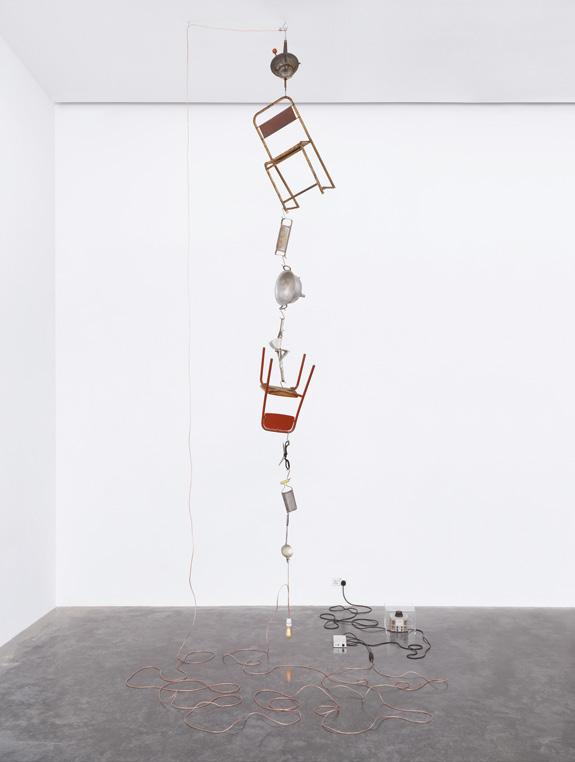
The CAS Rapid Response Fund in partnership with Frieze London was a response to the Covid-19 pandemic in spring and summer 2020, to support both artists and museums across the UK during the first national lockdown. Museums that are members of the Contemporary Art Society were invited to apply to buy art and craft that supports their civic role when they reopen once coronavirus-based restrictions ease.
The fund was designed to support as many different artists and local museums as possible, based on the understanding that our museums will play a vital role in our communities when we exit the crisis. The money raised through the CAS Rapid Response Fund purchased 107 artworks by British-based artists for 17 museums across the UK, ensuring that when museums reopen their doors, they are able to reach out to their communities through new acquisitions, playing a vital role in civic healing and mental wellbeing.
‘The Covid-19 lockdown of 2020 has had a profound impact on the city and people of Exeter and we wanted RAMM’s collections to reflect this remarkable time. Michelle Sank’s evocative images capture those weeks of empty streets, tranquillity and social isolation. They also illustrate the community spirit and human resilience that allowed people to survive such extraordinary circumstances. Acquiring the photographs and displaying them at RAMM will help us to reach out to new audiences and tell their personal stories of Exeter’s lockdown.’
Cllr Rachel Sutton, Deputy Leader & Portfolio Holder for Climate & Culture, Exeter City CouncilRabiya Choudhry
Dad
2018
Turquoise neon tubing encased in clear perspex
100 x 30 cm
Dream Baby Dream
2016
Acrylic on canvas
100 x 100 cm
Opposite, top
House of the Holy 2016
Acrylic on canvas
100 x 100 cm
Opposite, bottom
Rabiya Choudhry is a multidisciplinary visual artist who explores identity, visibility and migration. Her own experiences and cultural background are embedded in her work, from the vibrancy of the colour palettes to the fabrics employed. The name of Choudhry’s father, Mazhar, is celebrated in the neon called Dad. A message of the work is to question and create dialogue surrounding the social position and value of South Asian shopkeepers in the UK. Dad speaks to the visibility and invisibility of the names of South Asian workers who deserve recognition within their local communities. In addition, the neon recognises the essential role played by shopkeepers as key workers in the community both throughout the Covid-19 pandemic and prior to it.
The two acrylic paintings titled House of the Holy and Dream Baby Dream offer a glimpse into the artist’s perception of the impact of mental health during lockdown. House of the Holy depicts an isolated house in the form of a face. The windows are filled with tears,
while the teeth resemble Ku Klux Klan members, a reminder that hate speech can begin close to home. The disconnected telephone cable conveys the difficulties of letting go of negativity and keeping communication lines open. Dream Baby Dream reveals the internal workings of a head divided into small rooms, with people dreaming of a better future despite battling with depression. Each character escapes the reality they face through coping mechanisms from food to dancing.
Glasgow’s Asian community has had a long history with the city, through Empire, trade and migration. This acquisition acknowledges how these histories are expressed in a contemporary context and is inspired by Glaswegian humour, which can be comedic, dark and layered. Rabiya Choudhry’s works enable GoMA to engage with the wider community, particularly when trying to make sense of the complexities of life during a global pandemic.
Rabiya Choudhry (b.1982, Glasgow, Scotland) lives and works in Glasgow. Recent solo exhibitions include Transmission Gallery, Glasgow (2018) and Tramway, Glasgow (2017). She has produced commissions for ITV Creates (2019) and Edinburgh Festival (2018). Choudhry is currently working on a collaborative project for Glasgow International 2020, now to be held in 2021.
Presented by the Contemporary Art Society through the Rapid Response Fund, 2020
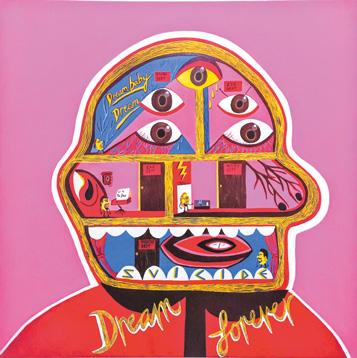
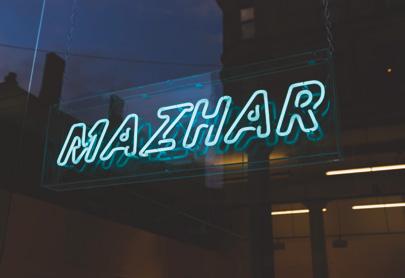
Phlegm
Pandemic Diary Series 1–67 and 1 unique print
2020
Pen and ink on paper
Each 10 x 7 cm
Phlegm is an anonymous multidisciplinary artist whose practice includes installation, drawing, engraving and illustration. He is best-known for the large-scale murals he has created in urban spaces across the world. Pandemic Diary is a small-scale pen-and-ink series that conveys the artist’s emotions and experiences during the first UK lockdown, from March to July 2020. These drawings document his personal experiences and observations during this unprecedented moment in British life. Phlegm describes the powerful and banal aspects of the ‘new normal’ life in lockdown, illustrating the rapidly changing world many found themselves living in. The drawings address everything from the fear surrounding isolation to the comedy around social distancing and the absurdity of irrational hoarding, as well as the respect and gratitude felt for key workers who continued working throughout.
For Graves Gallery, the clear and precise narrative and melancholic nature of Pandemic Diary connects with many works in the collection, such as historic prints by Holbein, Dürer, Callot and Hogarth. This is the first major series by Phlegm that the museum has sought to acquire, as Sheffield Museums continues to strengthen the collection of drawings. Phlegm spent 15 years living in Sheffield, where his work spans several buildings across the city. He states that ‘Pandemic Diary was an unplanned reaction to this sudden threat and change in our lives. As a body of work it was an immersive and cathartic way of processing a world in flux. To have this very personal collection kept
together and held in Sheffield couldn’t be more perfect. Sheffield is where I started out and found my voice as an artist and it will always feel like home.’
Phlegm (a pseudonym) lives in London, working internationally and across the United Kingdom. He has created murals in Australia, Belgium, Canada, Denmark, Germany, Iceland, Italy, Norway, Poland, Slovakia, Spain, Sri Lanka, Sweden, Switzerland, Tunisia and the USA. In 2020 he was commissioned to create Momart’s Christmas gift. In 2019 he created Mausoleum of the Giants, a large site-specific installation in a disused cutlery factory in Sheffield and also embarked on a project with the Royal Library of Belgium creating a print directly inspired by Pieter Breugel the Elder’s Luxuria
Presented by the Contemporary Art Society through the Rapid Response Fund, 2020
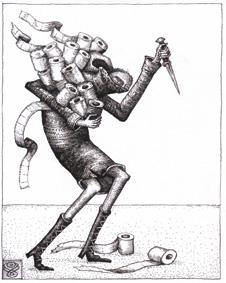



2020
Glazed stoneware
37 x 22 cm
Opposite, top
Let’s play hide-n-seek
2020
Acrylic on paper
56 x 76.5 cm
Opposite, bottom
Shawanda Corbett’s practice involves performance, painting and ceramics. As a woman with a disability, Corbett developed her own bespoke throwing technique using the wheel’s centrifugal force as the counterbalance. Corbett’s interdisciplinary practice addresses the question of what is a complete body, looking at the different cycles of a human’s life through ‘cyborg theory’, developed by the feminist science and technology scholar Donna Haraway in A Cyborg Manifesto (1985). Corbett also creates performances which combine music, dance, prose and poetry. Collaborating with choreographer Albert Corbett, she sets up a live inner dialogue with her surroundings.
A starting point for her ceramics and paintings are childhood memories of the neighbourhood where she grew up. The ceramics explore common tropes from ‘the Hood’: characters that are often invisible or reduced to stereotypes. The desire is to give them a dignity and humanity that they seldom have in mainstream perceptions.
Intimacy and familial bonds are an integral part of the making process. Vessels such as Graveyard Shift work in pairs, where each of them evokes a personality sometimes intended as a stand-in for real people. Corbett listens to jazz to inspire the direction of her artworks. The fluid and colourful surface decorations can be attributed to a performance where
the lines and shapes on the vessels visually represent the rhythm of the music.
Let’s play hide-n-seek is a bright and playful painting describing one of the most popular and universal games of childhood. Graveyard Shift, in contrast, explores the bonds within families where working night shifts or long hours can impact work-life balance and wellbeing.
By acquiring Graveyard Shift and Let’s play hide-n-seek, the Harris Museum & Art Gallery intends to explore memory, community and creativity. Corbett’s works in their forms and decoration connect to much of the gallery’s existing historic ceramics collection. When the museum reopens, there will be space given to reflect on the impact of Covid-19 and the Black Lives Matter movement on local communities and to test new ideas and objects for a major redevelopment project that continues to challenge forms of object display. The museum intends for Corbett to perform, in order to showcase the full range of her artistic practice, in the Harris Museum & Art Gallery space.
Shawanda Corbett (b.1989, New York) lives and works in Oxford. Recent solo exhibitions include Corvi-Mora, London (2020); Wadham College, Oxford; and Serpentine Gallery, London (both 2019). Recent group exhibitions include Schlossmuseum, Linz (2020); Modern Art Oxford (2019); and Kastamonu University, Turkey (2018). Shawanda Corbett is currently undertaking a DPhil at The Ruskin School of Art, University of Oxford.
Presented by the Contemporary Art Society through the Rapid Response Fund, 2020

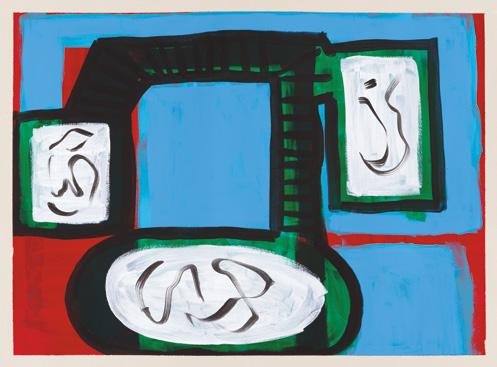
Packing
2020
Video
60 seconds
The Island
2020
Charcoal, gouache and graphite
125 x 75 cm
Opposite, bottom
Between Two Bodies
2020
Plaster and fabric
170 x 110 x 80 cm
Opposite, top
Rosanne Robertson’s practice spans across sculpture, photography, drawing and performance to explore the boundaries of the human body and its environment. Their recent works are made in the open air and explore the ‘terrain of the Queer body’ in the landscape and seascape. Robertson’s body of work entitled ‘Stone (Butch)’ was exhibited as a contemporary intervention within the display of work by Barbara Hepworth at The Hepworth Wakefield in 2019. The Island, Between Two Bodies and Packing continue to create a dialogue with the work of Barbara Hepworth, considering the abstract form as a way of expanding understandings of the figure.
In 2020 Robertson relocated to West Cornwall from West Yorkshire and was selected as a studio holder at Porthmeor Studios in St Ives where they created The Island, Between Bodies and Packing The Island is a series of submerged and emerging bodily islands in gouache, charcoal and graphite, drawn automatically from experience of swimming around coves, rocks and caves. Between Two Bodies is a pair of jesmonite sculptures cast directly in rock crevices, with one half cast in West Yorkshire and the other in West Cornwall.
Packing is a ‘performance for camera’ of the artist’s body swaying in the incoming tide, filling a deep rock crevice. These works were made in direct relation to the rocky headland of Godrevy Point on the far easterly point of St Ives Bay. This body of works considers gender fluidity and queerness in relation to the seascape and its caves, openings and overspills. Robertson is interested in what they describe as ‘phantom spaces of our bodies and how they connect with the hidden spaces of the coastal landscape’.
Rosanne Robertson has long been interested in Hepworth’s connection to the landscape and this significant acquisition queers the legacies of modernism and creates a statement of intent for The Hepworth Wakefield as it reaches out to broader audiences. The inclusion of this acquisition enables the museum to display multiple and diverse voices, enriching the traditional art historical narratives on display.
Rosanne Robertson (b.1984, Sunderland, UK) lives and works in West Cornwall. Recent solo shows include The Hepworth Wakefield, (2019); Air Gallery, Manchester and Art House, Wakefield (both 2018). Recent group shows include Yorkshire Sculpture Park and The Auxiliary, Middlesbrough (both in 2019) and Gallery 78, Reykjavik (2018).
Presented by the Contemporary Art Society through the Rapid Response Fund, 2020
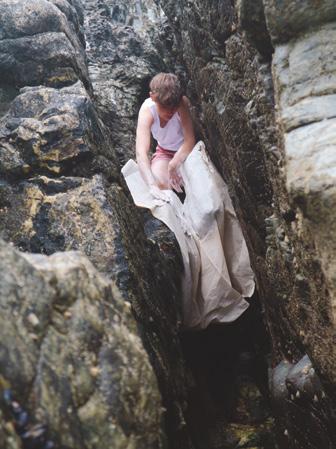
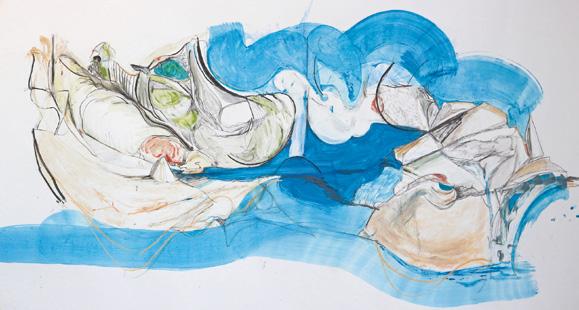
Doing Lines 1 (Lockdown) Line Journeys
2020
Oil pastel on paper
102 x 77.5 cm
Claudette Johnson is widely recognised as one of the most accomplished figurative artists in Britain today. Since the 1980s, Claudette Johnson has been a central figure in the UK Black Art Movement and has played an integral role in the Black British Feminist Art Movement. In 2011, Johnson also co-founded the BLK Arts Research Group with artists Marlene Smith and Keith Piper.
Doing Lines 1 (Lockdown) Line Journeys is a self-portrait that was created during the first national lockdown. As Johnson says, ‘the work is part of a series of larger scale “warm-up” drawings, the equivalent of scales practice for a pianist. I make them when there are no sitters as a way of exploring lines, trying to find a new way across a familiar body, working freely without too much reflection but at the same time with deep concentration’.
Johnson’s studies of Black men and women are central to her practice. Often drawn on large sheets of paper, Johnson’s works physically take up space. Their bodies typically begin at the top of the page and end at the bottom, spanning the entire paper. The subjects often stand alone as the sole focus, demanding attention and asserting their visibility with authority or in an understated manner. In this way, Johnson creates a dialogue with traditional notions of portraiture, regarding agency and the portrayal of Black bodies.
The Herbert Art Gallery intends to engage and inspire their audiences by focusing on a commitment to diversifying the narratives within the collections and moving away from centring Western perspectives. The Herbert first exhibited Johnson’s work in 1983 as part
of a ground-breaking exhibition by the BLK Art group. Doing Lines 1 (Lockdown) Line Journeys continues these relations by placing a personal work of Johnson’s in the Herbert Art Gallery’s permanent collection.
Claudette Johnson (b.1959, Manchester, UK) lives and works in London. Recent solo exhibitions include Modern Art Oxford (2019) and Hollybush Gardens, London (2017). Recent group exhibitions include The Drawing Room, London (2018); South London Gallery; and Nottingham Contemporary, Nottingham (both in 2017). Johnson will have a solo exhibition with Hollybush Gardens, London in 2021.
Presented by the Contemporary Art Society through the Rapid Response Fund, 2020

Margaret Salmon
Eglantine
2016
16mm & 35mm film transferred to digital with sound
Edition 1 of 3 + AP 70 minutes
Margaret Salmon is a filmmaker whose works interweave poetry and ethnography. In her films, Salmon explores relationships that seemingly ordinary people have with the environment around them. Eglantine was the filmmaker’s first foray into filming with 35mm, which developed her technique and enabled Salmon to have more control over the final production. In 2016, Eglantine previewed at Glasgow Film Festival before premiering at BFI London Film Festival.
Eglantine is a 70-minute avant-garde film and nature study. Filmed entirely in Scotland, on the Isle of Skye, in Oban and in various woodlands around Glasgow and Fife, Eglantine evokes the true nature of Scottish landscapes. The use of sound in Salmon’s films has been an integral part of her work and practice for years. As such, Eglantine involved collaboration with a field recorder who recorded the sounds of birds and animals. These were layered into the film, adding to the hyper-sensory element of the work as the film portrays the perception of being lost in nature from a child’s perspective. The end result forms an inter-species community and multi-sensory experience of the outdoors. Eglantine is a beautiful representation of the world perceived anew, through fresh eyes and ears, and a vivid account of a young girl’s real and fantastical adventure in a forest. The film pays tribute to children’s films of the past, particularly Ray Ashley’s Little Fugitive (1953), Jean Renoir’s The River (1951) and Albert Lamorisse’s The Red Balloon (1956).
Salmon’s portrayal of the natural world and human interaction within it complements The Hunterian’s aim to raise awareness about climate change. An acquisition that offers ways of seeing the environment through experimental filmmaking in a poetic manner will strengthen the museum’s collection. The Hunterian aspires to be a pivotal space of reflection and public discussion within the University of Glasgow and the larger community, aiming to ask critical questions about the world we live in, particularly after months of enforced confinement and radically reduced social interaction.
Margaret Salmon (b.1975, New York) lives and works in Glasgow. A solo exhibition of her work was held at Dundee Contemporary Arts (2018/19). Recent group shows include La Xavier, Paris (2018) and Rzeplinski, New York (2017). A new 35mm film and photographic works will be featured in GI 2021 and Salmon will be featured in the upcoming British Art Show 9. Salmon will have a solo exhibition at the Hunterian Gallery, University of Glasgow (2021).
Presented by the Contemporary Art Society through the Rapid Response Fund, 2020
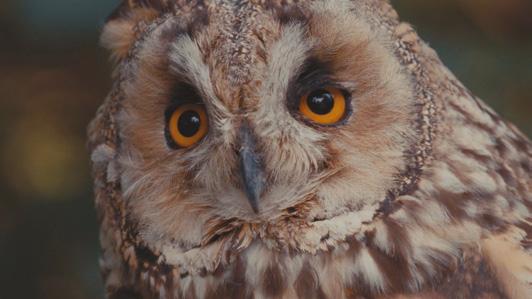
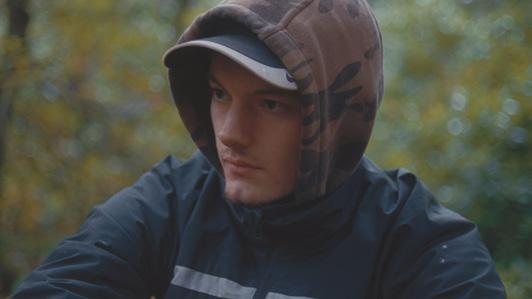
Mike Silva
Jason in Hyde Park
2020
Oil on linen
76.2 x 101.6 cm
Opposite, top
Kitchen Window
2020
Oil on linen
50.8 x 61 cm
Opposite, middle
Headphones
2020
Oil on linen
39.4 x 49.5 cm
Opposite, bottom
Mike Silva navigates past experiences of masculinity, queerness and nostalgia in his work. A painter of still lifes and portraits, Silva paints with a fondness that conveys agency and intimacy. His works are personal, exposing vulnerable sides of his life, from past relationships to previously inhabited places. Central to Silva’s practice is photography, inspired by the ability that it has to capture a fixed moment in time. The artist has amassed a large collection of photographs taken in the ’90s and ’00s. By combining the photographs from his archive with his own emotions and memories, he retells these stories again through painting. Questions arise about how and what we remember, as well as what memories we choose to let go of.
The Laing Art Gallery has acquired three works from the recent series ‘London Portraits, Interiors and Still Lives’. Headphones and Kitchen Window are paintings of interior spaces. These domestic scenes appear to be hazy through the use of white paint, shadows and the use of light which ultimately transform mundane objects into mystical relics.
Silva’s paintings are intimate, tender and somewhat melancholic. In his portraiture such as in Jason in Hyde Park, Silva paints Black men in everyday scenes, where there is both an intimacy and sternness in their gaze. He adds to the representation of Black men in painting through varying forms of masculinity, partially informed by an understanding of otherness experienced as a person of dual heritage.
These three works convey the spectrum of Silva’s practice, from still lives to portraiture. The Laing Art Gallery is committed to addressing erasures, omissions and incomplete narratives that are inherent in many public collections of British art. Acquiring Queer and diverse works are a part of a longer ongoing collecting process which the Laing Art Gallery intends to pursue.
Mike Silva (b.1970, Sandviken, Sweden) lives and works in London. Recent solo shows include The Approach, London (2020); The Annexe, London (2019); and Farbvision, Berlin (2018). Recent group exhibitions include Anton Kern, New York (2021); Copeland Gallery, London (2019); and David Risley Gallery, Rotterdam (2017).
Presented by the Contemporary Art Society through the Rapid Response Fund, 2020


Reading the Realness
2020 – ongoing
Live performance and archive of films, scripts and photographs
Dimensions vary
Harold Offeh works in a range of media including performance, video, photography and social arts practice. Offeh often employs humour as a means to confront the viewer with historical narratives and aspects of contemporary culture. He is interested in the space created by the inhabiting or embodying of history. Recent projects have explored encounters with museum objects and artefacts, forgotten queer histories and intersections of the body and technology.
Reading the Realness is a performance and its documentation acquired for Leeds Art Gallery. Every time the work is performed, the resulting documentation – films, scripts and photographs – become part of an evolving and living archive. The script is always a re-enactment of an existing panel show discussion that is selected in dialogue with the artist and a culturally diverse participant group, chosen via a targeted call-out, who then perform live.
Reading the Realness draws on rehearsal strategies from Brazilian theatre director Augusto Boal’s (1931–2009) ‘Theatre of the Oppressed’, encouraging participants and audiences to critically consider the performance of self within contemporary media debates and – more broadly – to better understand ourselves and each other. Indicative subjects for contemporary scripts may include debates around colonial statues, positive discrimination or use of the term ‘Queer’. The performance explores how bonds and connections between people can be strengthened when communities are increasingly fractured and individuals isolated. Reading the Realness
is a fascinating and multi-faceted work that responds to the need for nuanced discussion about intersectionality, social identity and the urgency of building solidarity across difference. Responding to contemporary situations and debates, Offeh’s work is about building understanding and empathy through consideration of other subject positions, strengthening connections between people at a time when it is sorely needed.
Harold Offeh’s Reading the Realness will be part of Leeds Art Gallery’s re-opening Autumn/Winter programme in 2021 and will play a pivotal role through performance, collaboration and conversation when the gallery can finally welcome audiences back.
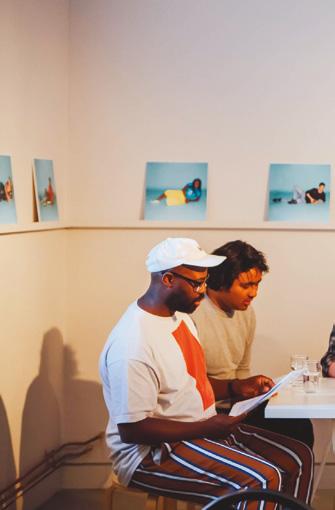
Having worked in Leeds for over 10 years, Offeh has strong ties to the city and the Rapid Response Fund acquisition chimes with Leeds Art Gallery’s ethos to ensure that the gallery’s programme reflects the diversity of the communities it serves.
Harold Offeh (b.1977, Accra, Ghana) lives in Cambridge, UK, and works between Leeds and London. Recent projects include Turf Projects, London (2019); Tate Modern (2019) and Tate Britain (2017). Recent group exhibitions include Kettle’s Yard, Cambridge (2021); Wellcome Collection (2021); and South London Gallery (2020). He was recently awarded the Paul Hamlyn Foundation Award for Artists.

Jeremy Deller
Everybody in the Place: An Incomplete History of Britain 1984–1992
2018
HD Film
61 minutes, 35 seconds
Edition 3 of 6
Jeremy Deller is a conceptual video and installation artist whose work often combines art and activism, socio-political history, popular culture and counterculture. Often working collaboratively, Deller combines storytelling and visual ethnographic methods to critique the past and present. Everybody in the Place, An Incomplete History of Britain, 1984–1992 was commissioned for Frieze 2018 and premiered on BBC4 the following year.
Everybody in the Place: An Incomplete History of Britain 1984–1992 is a film about the evolution of Acid House music in 1980s Britain against the backdrop of political and social upheaval. The themes explored in the film were previously referenced in Deller’s work titled The History of the World (1997–2004), a large-scale diagram which mapped the social connections between Acid House and brass bands, which informed Deller’s musical collaboration Acid Brass in 1997.
Everybody in the Place, An Incomplete History of Britain, 1984–1992 centres around Deller delivering a lesson to an A-level Politics class. His creative narrative of Acid House conveys the power of teaching young people about society through art. The film is about forging a sense of community amidst a period of social tensions and change. He conveys the significance of Acid House for the youth in the 1980s, citing the miners’ strike in 1984 as a catalyst for change throughout the decade.
Manchester is referenced in Deller’s film as a contemporary city shaped by music and art. The current issues raised by Covid, inequality, education and politics and the vital role that different cultures have in shaping society
have become talking points in recent years. Everybody in The Place: An Incomplete History of Britain, 1984–1992 examines the socio-political history of other works in the collection, in relation to the evolution of rave music as a significant cultural force. Manchester Art Gallery will collaborate with Manchester College for a project called The Future Programme which will use the film as a platform for discussion with A-level Visual Art students.
Jeremy Deller (b.1966, London) lives and works in London. Recent solo exhibitions include, Kumu Art Museum, Tallinn (2021); Bonner Kunstverein, Bonn (2020); and The Modern Institute, Glasgow (2019). Recent group exhibitions include The Centre for Fine Arts (BOZAR), Brussels; Southbank Centre, London; and Centre Pompidou Metz, Paris (all 2020).
Jeremy Deller won the Turner Prize in 2004 and showcased his work at the 2019 Venice Biennale.
Presented by the Contemporary Art Society through the Rapid Response Fund with support from the V&A Purchase Fund and the Bloxham Charitable Trust, 2020/21






Printed wallpaper and 100 digital print placards on correx attached to wooden struts Dimensions vary
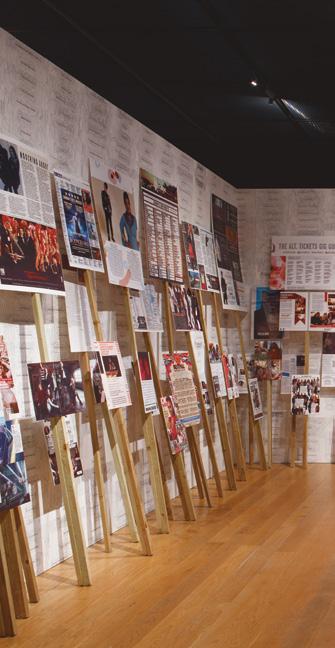
Sonia Boyce gained prominence in the 1980s during the Black Arts Movement and is currently Professor of Black Art and Design at University of the Arts London. Her work incorporates a variety of media such as photographs, performance, films, prints, drawings, installation and sound. Her most recent work incorporates the audience as an integral part of the artwork demonstrating how cultural differences might be articulated, mediated and interacted.
Boyce began Devotional in 1999, a long-term project that has been exhibited in different ways over the last two decades. It first emerged from a collaboration with the collective Liverpool Black Sisters. Starting the Devotional series with a print of Dame Shirley Bassey (b.1937 in Wales), the women in the group created a map of women of colour in the British music industry. This iteration of Devotional is a room-scale installation, which includes the names of 200 musicians printed on wallpaper, displayed with a series of 100 magazine covers and articles on placards from a wider archive held by Boyce. Boyce built this archive through public contributions to celebrate female singers in British entertainment and to be representative of a collective memory that the public can have access to.
Boyce now wishes to close the Devotional series, with the final version finding its home at MIMA. Boyce has a long-standing relationship with the museum, which first acquired her work in 1987. Since 2018, curators at MIMA
have worked with Boyce through the research project Black Artists & Modernism, based at UAL. The installation connects with MIMA’s commitment to discussing overlooked cultural narratives and offers rich stimulus for discussing relationships, visibility, memories and creativity with the wider community in Middlesbrough.
Sonia Boyce OBE RA (b.1962, London) lives and works in London. Recent solo exhibitions include Eastside Projects, Birmingham (2020); Manchester Art Gallery (2018); and ICA, London (2017). Recent group exhibitions include Goodman Gallery, London (2020); All the World’s Futures, Venice Biennale (2015); and Guildhall Gallery, London (2015). Boyce
is currently Professor of Black Art and Design at University of the Arts London. Boyce will represent Britain at the Venice Biennale 2021. Presented by the Contemporary Art Society through the Rapid Response Fund, 2020
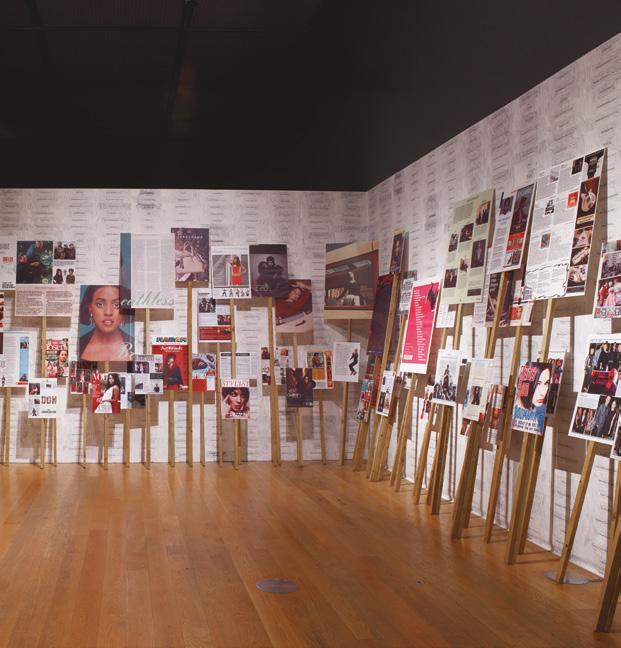

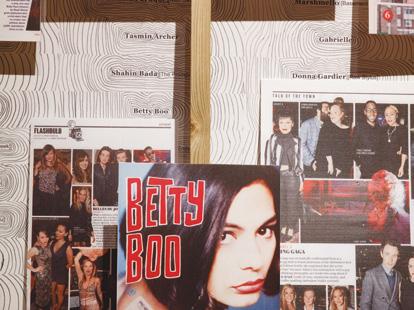
‘I am particularly excited that my work has found a home in the collection of the New Art Gallery Walsall during a period in which the European debate has arrived at the critical moment of Brexit. Having this work in the collection will stimulate ongoing debate and examination of what has been a watershed period of recent British history.’
Keith Piper, artist
Surveillance: Tagging the Other 1991
Mixed media installation with four video monitors and slide projection Dimensions vary Edition 1 of 4

By adopting a research-driven approach and using a variety of media – from painting to photography, installation, video and computer-based interactivity – Piper’s works often have an autobiographical element to them. Part of the creative process has been informed by the influences of the sociopolitical climate and analysis of his experiences and identity. Race, ideology and technology are central to navigating Piper’s work, particularly regarding the impact of how historical events are understood and reproduced in the present and their potential futures.
The multi-media installation entitled Surveillance: Tagging the Other was created in response to issues arising in the run-up to the instigation of the European Union in 1992. The four monitors, installed in a row, show the artist’s head being a target of surveillance and control. His Black body is scrutinised in terms of ethnicity, gender, citizenship and appearance. Sound is an important part of the work, featuring fragments of news reports related to the rise of racist attacks, anti-Semitism and right-wing tendencies across Europe. Central to evoking these techniques is the layering of audio and mixed media to encourage a reflection on the power and legacy of narratives we are told and the methods they are communicated by. Techniques within Surveillance: Tagging the Other and in other installations include the incorporation of sampling, visual montage such as collages, found objects and text.
Despite being created in 1991, the work’s relevance persists today. Recent events
relating to Brexit have been centre stage in UK discourse via the media and newspapers. The work also connects with wider issues around surveillance. Following the highly visible death of George Floyd, demands for racial equality and a recognition of racial inequality have permeated social discourse. Piper will have a solo show entitled Jet-Black Futures at New Art Gallery Walsall in 2021, aiming to provide opportunities for dialogue and debate.
Keith Piper (b.1960, Malta) lives and works in London. Recent solo exhibitions include Wolverhampton Art Gallery; Beaconsfield Gallery, London; and New Art Exchange, Nottingham (all 2017). Recent group exhibitions include Manchester Art Gallery (2019); Helsinki Contemporary, Finland (2018); and Millennium Gallery, Sheffield (2018). Piper is currently Professor Associate Professor in Fine Art and Digital Media at Middlesex University. Piper will have a solo show at
 The New Art Gallery Walsall entitled Jet-Black Futures in 2021.
The New Art Gallery Walsall entitled Jet-Black Futures in 2021.
A Sliced Tooth
2020
Oil pastel, oil stick on paper
Panel 1 12 x 27.5 cm
Panel 2 17 x 27.5 cm
Rachel Jones creates sculpture, paintings and works on paper. Known for her distinctive way of blending abstraction and figuration together to express the intangible, her paintings grapple with the challenges of finding visual means to convey abstract, existential concepts.
Jones’s most recent body of work has been a series of paintings made from oil stick and oil pastel that allude to the mouth and teeth. Her own identity and agency add to the complexity of the layers within her work. Repeated titles and motifs such as the mouth and teeth are indicative of Jones’s practice, creating a relationship across her works. A Sliced Tooth is the name given to the work for Pallant House Gallery, for example, but there are several other works with this title, which Jones has been using since 2020. A Sliced Tooth is a diptych that consists of two teeth with white bases, over-painted with vibrant reds and muted greys. These layers of oil pastel and oil stick are built up to create a sense of physical and metaphorical depth, with the imperfect, raw-edged canvases producing works that almost resemble landscapes.
The gallery has been looking to strengthen the presence of female artists who explore identity in their collections and exhibitions. In 2019 an exhibition entitled Radical Women was on display exploring 20th-century abstract women artists in Britain who engaged in progressive art and politics. Jones’s paintings are informed by her research into the depiction of Black figures in the arts from the eighteenth century to the present, how they
are understood and culturally reproduced, and the potential role of these representations in dismantling existing power structures. Jones’s work continues this conversation, through the exploration of contemporary painting and Black history.
Rachel Jones (b.1991) lives and works in London. Recent exhibitions include The Chinati Foundation, Marfa, Texas (2019). Recent group exhibitions include Galerie Thaddeus Ropac, London (2020); New Art Centre, Salisbury; and the Royal Academy of Arts, London (both 2019). Jones was awarded the André Dunoyer de Segonzac Hon RA Prize (2019) and the Machin Foundation Painting Prize (2018).
Presented by the Contemporary Art Society through the Rapid Response Fund, 2020

Eleanor Lakelin
Oh, Beautiful World!
2020
Horse Chestnut Burr
47 x 47 x 131 cm
Eleanor Lakelin is a conceptual wood sculptor who creates artwork made from trees grown in Britain. She is motivated by the possibilities revealed by the organic chaos within the material and the many textures and layers within. The trees Lakelin uses have been felled from decay and the wood enables Lakelin to explore the dynamics of time, growth, life and death.
Her passion for horse chestnut wood led her to engage in a dialogue with the curator at Reading Museum about a commission to commemorate the legendary poet Oscar Wilde. The horse chestnut trees were overlooking Reading Gaol when Wilde was incarcerated in 1895 but were felled in 2020 due to disease. Oh Beautiful World! is a commision to create a work that will serve the community and preserve this history.
In the making process of Oh Beautiful World!, Lakelin manipulated the material to reveal the naturally occurring textures within the grain. This unique element of disruption can be seen in many of her works, and she uses it to guide her outcome. In this case, the partially sanded and smoothed surface represents the beauty of classical vessels, juxtaposed with the exposed burr to reveal the coexistence of beauty, sorrow, health and sickness. Oh, Beautiful World! is an anthropomorphic artwork that confronts the fragility of life, pertinent to Oscar Wilde, but also facilitates discussion and reflection of nature, beauty and time.
In an effort to preserve its legacy, artists and LGBTQ+ public figures like actor Stephen Fry and writer Julian Barnes campaigned to convert Reading Gaol into an Arts & Heritage Centre. Although the prison has since been
sold to a developer, Reading Museum intends to place a work in the collection that resonates with the local community and the shared history of the area. Lakelin’s artwork will join a number of Oscar Wilde-related artworks in the Reading Museum collections, and will also form a vital part of an environmental installation. Oh, Beautiful World! commemorates the legacy of Oscar Wilde, but also offers a glimpse into the myriad of ways that the community will navigate the end to their isolation after a series of lockdowns.
Eleanor Lakelin (b.1960, Llandrindod Wells, Wales) lives and works in London. Recent exhibitions include Sarah Myerscough Gallery, London, (2020); 1831 Gallery, Paris (2020); and Arthus Gallery, Brussels (2020). Lakelin is widely exhibited and was awarded the British Wood Awards in 2017.
Presented by the Contemporary Art Society through the Rapid Response Fund, 2020

Michelle Sank
8 pairs of Photographs from the series ‘Breathe’
2020
Digital C-type colour prints
91 x 121 cm
Michelle Sank is a social documentary photographer capturing interactions and aspects of daily life. With a focus on identity and space, Sank has photographed many people in their local areas and homes. South African documentary photographer David Goldblatt (1930–2018) was Sank’s mentor when she was a student before moving to the UK in 1978. In 2006, Sank published a book entitled Becoming, which includes contributions from Goldblatt. Similar to Goldblatt, Sank captures people across Britain, particularly those who may not see themselves in documentary photographs. Sank’s work encompasses issues around social and cultural diversity, revealing an intimate portrayal of the human condition.
Walking in isolation during the first lockdown, Sank observed a strong sense of community amongst her neighbouring area of Burnthouse Lane and was drawn to how people managed private and public spaces in Exeter during Covid-19. This series of photographs is entitled Breathe and conveys how they adjusted to living on their own, in relationships or with families. The portraits are paired with empty spaces and houses. This evident contrast enables meaning to be given to the pandemic where empty chairs, religious icons and flowers became symbolic for death and loss.
Michelle Sank’s evocative images capture those weeks of empty streets, tranquillity and social isolation. They also illustrate the community spirit and human resilience that allowed people to survive such extraordinary circumstances. For RAMM, acquiring the
photographs and displaying them in the collection will help to reach out to new audiences and tell their personal stories of Exeter’s lockdown. The Covid-19 lockdown of 2020 has had a profound impact on the city and people of Exeter. A priority of the museum has been to make RAMM’s collections reflect this.
Michelle Sank (b.1953, Cape Town, South Africa) lives and works in Exeter. Recent solo exhibitions include The Exchange Gallery, Cornwall, UK (2019); Elliot Halls Gallery, Amsterdam (2016); and Royal Albert Memorial Museum, Exeter (2015). Recent group exhibitions include international touring exhibition FotoNostrum, Barcelona (2019-2020); Salford University; and Open Eye Gallery, Liverpool (both 2019). Sank has won numerous awards including The National Portrait Gallery portrait prize and In 2020, a picture Sank had taken from the ‘Breathe’ series won her a Portrait of Britain Winners Award.
Presented by the Contemporary Art Society through the Rapid Response Fund, 2020


Matt Smith
King of the New World
2014
Found textile with glass beads and bundle beads
26.5 x 21 cm
Madame Vigee Lebrun and her daughter
2020
Found textile and wool
43 x 61 cm
Oceans Rise, Empires Fall
2019
Black porcelain
44 x 12 x 17 cm
1970 1870
2014
Found and altered textile
51 x 38 cm
Overleaf, page 51
Conehead Man (Large)
2018
Black parian
22 x 7 x 5 cm
Conehead Man (Small)
2018
Black parian
17 x 6 x 5 cm
Trees
2017
Black parian
La Menina
2020
Black parian ware and found ceramic
22 x 13 x 13 cm
Opposite
Conehead Geishas with Pearls
2018
Black parian with freshwater pearls
30 x 13 cm
Wunderkammer 19
2017
Black parian ware
13 x 27 x 14 cm
Conehead Jelly Mould
2018
Black porcelain
29 x 20 x 15 cm
Wunderkammer II 1
2017
Black porcelain
14 x 24 x 15 cm
Wunderkammer II 18
2017
White parian
22 x 9 x 9 cm
Matt Smith has gained an increasing reputation as a ceramicist and textile artist. Much of his work explores the representation of queer and marginalised histories. His clay figures and tapestries describe the ways in which institutions function and reproduce fixed narratives. Artist intervention and recycled materials are employed within his practice to critique and reveal these power structures. As Matt Smith has said, ‘What museums collect, and what this tells us about what society deems important, is an ongoing fascination to me. Recent events have shown how important objects, and particularly sculpture, are in the national debate about who we are and how we got here.’
This body of work acquired through the Rapid Response Fund for Royal Pavilion & Museums Trust, Brighton & Hove contains a plethora of Smith’s practice including a number of works from the series ‘Wunderkammer’. Wunderkammern are cabinets of curiosities that were popular in the Victorian era and before. Specialists and amateurs vied to

find unusual specimens for their collection, leading to ‘faked’ objects appearing, including mermaids and unicorn horns. Smith combines these contrasting elements to make new fantastic relics, displaying the opulence of Victorian Britain whilst simultaneously inserting an element of unease and difference.
Royal Pavilion & Museums Trust, Brighton & Hove have established a relationship with the artist over the last decade. This acquisition complements the existing works in the collection and enables the museum to display how Smith’s work has evolved over time, since the museum already owns an earlier work by the artist. The museum continues to develop its craft audience, building on the success of its recent Cultural Icons exhibition of contemporary ceramicists. The benefits of craft and creativity for wellbeing are well known and resonate particularly with the current uncertain times. Matt Smith’s objects
and tapestries will form a key inspiration for activity sessions with groups especially those with varied critical social needs.
Matt Smith (b.1971, Cambridgeshire, UK) lives and works in Kilkenny, Ireland. Recent and upcoming solo exhibitions include Pitt Rivers Museum, Oxford (2020/21); London Art Fair, Edit (with Cynthia Corbett Gallery), London (2021); and Fitzwilliam Museum, Cambridge (2018). Recent group exhibitions include Cynthia Corbett Gallery, UK (2021); The Potteries Museum and Art Gallery, Stokeon-Trent; and Gustavsberg Konsthall, Sweden (both 2019). Smith holds many awards such as Brookfield Properties / Crafts Council Award 2020 (inaugural), the Young Masters Maylis Grand Ceramics Prize (2014) and was Artist in Residency at the V&A, London in 2015.
Presented by the Contemporary Art Society through the Rapid Response Fund, 2020
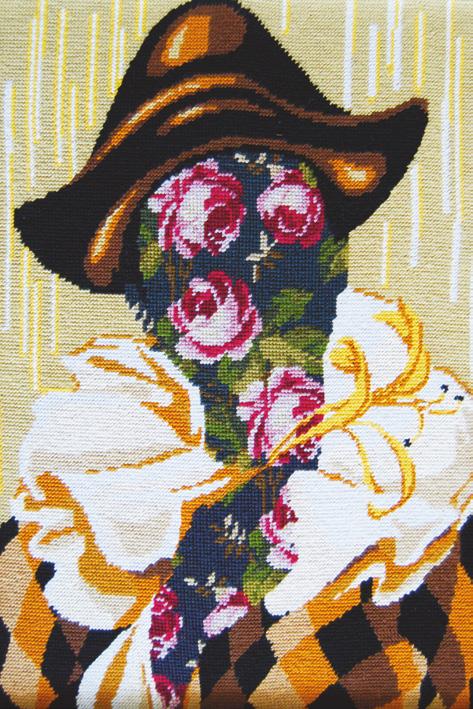
Granby Workshop
Granby Rock
Monochrome
Porcelain
100 x 90 cm
Granby Rock
Monochrome
Porcelain
50 x 50 cm
Speckled Porcelain Pendants
18 x 10.5 cm
Blue Encaustic Tiles
14.5 x 14.5 cm
Green Encaustic Tiles
14.5 x 14.5 cm
Granby Dinnerware
Big Plate
Porcelain
27 x 26 cm
Small Plate Porcelain
21.5 x 23 cm
Big Bowl
Porcelain
21 x 6.2 cm
Mug Porcelain
9.1 x 8.7 cm
Green and Pink Unglazed Sharing Platter
Porcelain
33 cm
All above works 2020
Granby Rock Slab
Monochrome
Porcelain 2021
5 x 150 x 100 cm
Granby Workshop is a community-led initiative that was established by Assemble and named after the Liverpool neighbourhood Granby. Liverpool has a legacy as a major centre for ceramic innovation from the early 1800s onwards. Granby Workshop manufactures a wide range of ceramics from bathroom tiles, to taps and countertops. Their work combines experimental craft techniques with material investigations. Central to the ethos of Granby Workshop is the ability to incorporate an element of randomness and individuality to each work so that the end products are entirely unique. Once inhabiting a space, they create their own playful exchanges with the environment that they are housed in.
The items acquired for Victoria Gallery & Museum will form part of a large room installation incorporating utensils, floor tiles and a fireplace and visitors are invited to enter the room and engage with the objects. Much of Granby Workshop’s products are made from recycled materials that directly tackles increasing environmental concerns. Their work also speaks of renewal through creativity and positivity which is something the local, national and global economy will be encouraged by over the coming years after lockdown.
An exhibition centred on a recent acquisition of four Peter Lanyon designs for a handpainted tile mural will go on display, with the theme of the human race’s conflict with nature. Acquiring a large body of work by Granby Workshop to be displayed adjacently will complement this work through a contemporary voice on ceramics, providing an opportunity to reflect on issues arising from Covid-19. Victoria Gallery & Museum intends to collaborate with the University’s School of Architecture and ceramic groups from
other colleges and communities enabling the exhibition to be remotely accessible.
Granby Workshop (est. 2015, Toxteth Liverpool) was founded by Assemble. Granby Workshop is a continuation of a project with Granby Four Streets neighbourhood residents, where they assisted in the refurbishment of 10 houses. In 2015, Assemble won the Turner Prize for
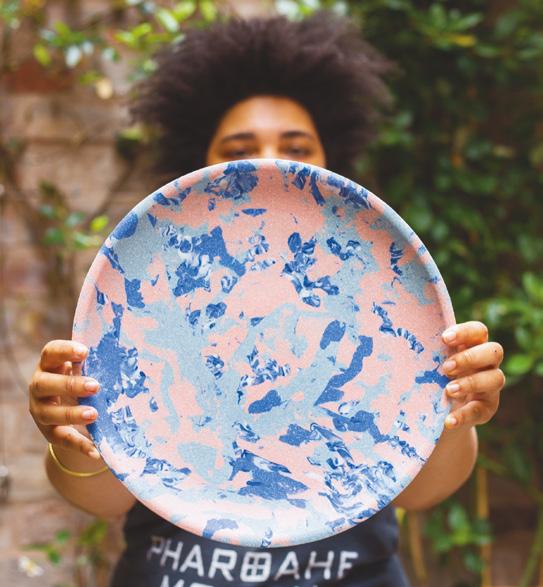
the Granby Four Streets Project. Granby is a community-oriented business, continuing to operate from Granby St, participating in the monthly community market and contributing to ongoing local renovations.
Presented by the Contemporary Art Society through the Rapid Response Fund, 2020
Frances Disley
Holo Programme 155
2020
Circular hand painted quilt 4 metres
Audio recording 20 minutes
Fleece blankets
Originally a painter, Frances Disley seeks to expand the gesture of painting into a performance, whilst also creating sculptures and installations. Through her practice, Disley questions how art is displayed, interacted with and the purpose of the space that each artwork inhabits.
Holo Programme 155 is an immersive installation that takes inspiration from two of Disley’s interests: Star Trek and psychology. Collaborating with psychologists at the University of Salford for this work, Disley gained access to research that suggests that guided visualisation can help reduce stress and relieve pain. It also revealed that plants, and colours such as light blue, beige and green, have a positive effect on our brain. Thus the installation consists of these colours to help ease the feelings of anxiety that some people experience in gallery spaces.
The original installation of Holo Programme 155 featured a grid design on the gallery’s walls, designed to mirror the Holodeck in Star Trek: The Next Generation, a transformative space which allows crew members to step into other worlds without leaving their spaceship. For the artist, an exhibition space is a holodeck, transforming to accommodate the vision of the artist on display. For Holo Programme 155, Disley strives to repurpose the gallery as a location for wellbeing and recovery. Disley’s holodeck computer narrates a 20-minute guided visualisation designed to aid wellness. The quilt, displayed as a wall hanging, can be laid out for people to sit on
during sessions. While the work employs the language and imagery of self-care and wellness, it also playfully questions the glossy, aspirational vision of wellbeing on social media.
During lockdown, many found solace in art and creativity. When galleries re-open, their purpose and value as spaces to share experiences will become even more important. The Walker Art Gallery intends to have a central role in facilitating the wellbeing of the local community. Holo Programme 155 will create a bridge between the Walker’s painting collection and its growing number of performance and durational pieces. Disley is a Liverpool Biennial Associate Artist, with strong ties to Liverpool, and this acquisition reflects the Walker’s ambition to collect more work by women and support Liverpool-based artists at critical career points.
Frances Disley (b.1976, Warrington, UK) lives and works in Liverpool. Recent solo exhibitions include Bluecoat Gallery, Liverpool (2020); Humber Street Gallery, Hull; and OUTPUT Gallery, Liverpool (both 2019). Recent group exhibitions include Complex, Dublin, (2020); Castlefield Gallery, Manchester (2020); and Hilbert Raum, Berlin (2019).
Presented by the Contemporary Art Society through the Rapid Response Fund, 2020
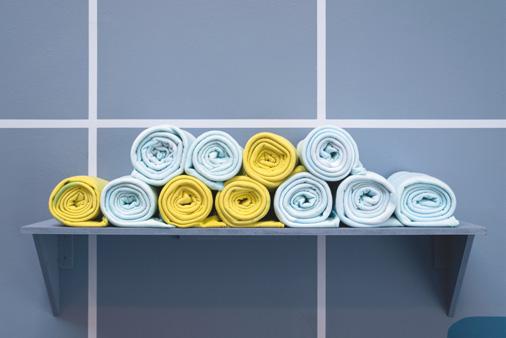
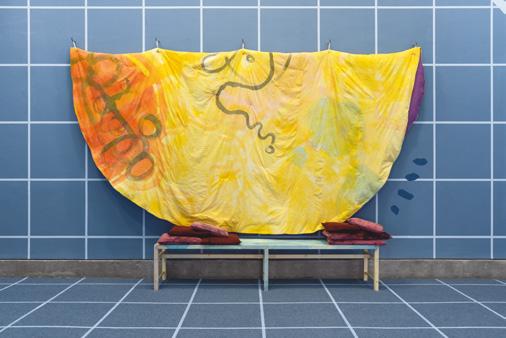
The Contemporary Art Society’s Collections Fund was set up in 2012 and, for the fourth year, has worked in partnership with Frieze London in 2019. The scheme supports the acquisition of significant contemporary works for Contemporary Art Society Museum Members across the UK. It aims to draw together the knowledge, experience and expertise of private collectors with that of museum curators. Through the Collections Fund at Frieze, the Contemporary Art Society has presented eleven photographs by Zanele Muholi to Nottingham Castle Museum and Gallery.
Nottingham Castle has been closed for a £30 million transformative capital redevelopment programme. This is one of the largest heritage projects in England and presents a rare opportunity: a once-ina-generation step-change for the Castle and its collections. When Nottingham Castle Museum & Art Gallery re-opens in summer 2021, the eleven photographic portraits by Muholi will be a central part of the new displays.
Zanele Muholi
Ayanda Mqakayi, Nyanga East, Cape Town, 2011
2011
silver gelatin print
Edition 2 of 8 + 2AP
Opposite, top left
Bathandwa Mosho, Braamfontein, Johannesburg, 2010
2010
Silver gelatin print
Edition 1 of 8 + 2AP
Opposite, top right
Lebo Leptie Phume, Daveyton, Johannesburg, 2013
2013
Silver gelatin print
Edition 5 of 8 + 2AP
Opposite, bottom left
Lerato Dumse, Brooklyn, New York, 2015
2015
Silver gelatin print
Edition 1 of 8 + 2AP
Opposite, bottom right
Tinashe Wakapila, Durban, 2018 2018
Silver gelatin print
Edition 1 of 8 + 2AP
Thembela Dick, Nyanga East, Cape Town, 2011
2011
Silver gelatin print
Edition 1 of 8 + 2AP
Zandile ‘Nkunzi’ Nkabinde, Braamfontein, Johannesburg, 2008 2008
Silver gelatin print
Edition 2 of 8 + 2AP



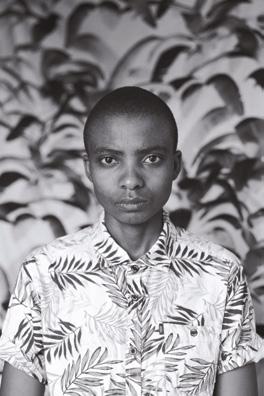
‘These 11 portraits from Zanele Muholi’s Faces and Phases series will be a highlight of new displays at Nottingham Castle when it reopens after its £30 million redevelopment. Part of a living archive of photographs that bring visibility to Black lesbians, gender-nonconforming individuals and transmen in South Africa, they exemplify the artist as activist and commentator on the issues of their times.
In each image, the subject’s direct, unflinching gaze meets our own and as a group, they command immediate attention; as part of Nottingham’s collection, they will do so for decades to come.
On a personal note, I feel energised by the intense period of collaborative research and discussion that the Collections Fund at Frieze enabled us to have with the CAS and their incredibly knowledgeable and supportive patrons.’
Deborah Dean, Principal CuratorNottingham City Museums and Galleries


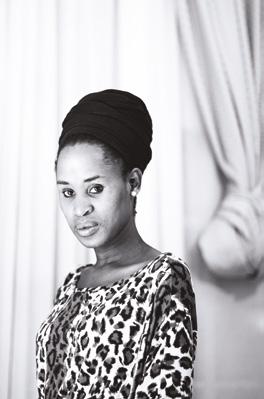

Ricki Kgositau, Melville, Johannesburg, 2013
2013
silver gelatin print
Edition 3 of 8 + 2AP
Opposite, top right
Lynette Mokhooa, KwaThema Community Hall, Springs
Johannesburg, 2011
2011
Silver gelatin print
Edition 3 of 8 + 2AP
Opposite, top left
Istesh Gonya, Parktown, Johannesburg, 2013
2013
Silver gelatin print
Edition 1 of 8 + 2AP
Opposite, bottom right
Sosi Molotsane, Yeoville, Johannesburg, 2007
2007
Silver gelatin print
Edition 6 of 8 + 2AP
Opposite, bottom left
All 86.5 x 60.5 cm
Zanele Muholi is a photographer and visual artist documenting the lives of Black lesbian, trans and gender non-conforming South Africans. Faces and Phases is a powerful series of portraits in stark black and white. The photographs are highly political, in line with Muholi’s role as a ‘visual activist’, yet deeply personal, often involving friends of the artist. They empower their sitters by granting them the dignity of presenting themselves to the world as they would like to be seen. The sitters look directly at the viewer, holding their gaze.
The artist attempts to widen the scope of South Africa’s photographic history by including people that have long been marginalised. For Muholi, the act of mapping and preserving the presence of the LGBTQ+ community is one of resistance against oppression and the threat of violence. Despite the legalisation of
same-sex marriage in 2006, discrimination and violence against the LGBTQ+ community remains commonplace and severe, therefore, Muholi’s sitters participate in the work at great personal risk.
Muholi responds to the absence of Black LGBTQ+ people from South Africa’s visual history using documentation and the commemorative power of portraiture. The series is a testament to the presence and resilience of this community. Of the eleven portraits that CAS has acquired, two are of sitters that have since passed away; Faces and Phases memorialises their loss and celebrates their lives.
The acquisition of the works by Nottingham Castle Museum will build on the Castle’s existing history of protest, contributing a global perspective and a focus on the discrimination and violence faced by the LGBTQ+ community.
Zanele Muholi (b.1972, Umlazi, South Africa) lives and works in Johannesburg. Recent solo shows include Tate Modern (2020); Seattle Art Museum; Colby Museum of Art, Maine (both 2019); and the Spelman College Museum of Fine Art, Atlanta (2018). Group shows include Museum Rietberg Switzerland (2019); Montreal Museum of Fine Arts (2018); and S.M.A.K Ghent (2017). They were featured in the 58th Venice Biennale.
Presented by the Contemporary Art Society through the Collections Fund at Frieze, 2019/20
Steven Claydon (Joanna) The Concealment and the Showing Forth
2010
Powder-coated metal frame and stool, buckram and aluminium.
150 x 124 x 75 cm
Opposite, top
Magali Reus
Harlequin Darts
2016
Fibreglass and cast polyester resin, pigments, lead shot, powder coated steel tubing and laser cut steel, blackened socket bolts, washers and nuts, burnt and engraved wood, stapled, embossed, laser engraved, screen printed, perforated, dyed leathers and suedes, hessian, laser cut rubber, metallic leatherette, polyester webbing and rope, rubber dipped threaded steel rod, passivated steel, fixings.
122 x 282 x 118 cm
Opposite, bottom
Michael Dean
FFFFFFFFF (WORKING TITLE)
2017
Concrete, silicon, steel, ink stained paperback books ‘Ilo Vey’
190 x 100 x 70 cm
Overleaf, page 64
The Contemporary Art Society has acquired important sculptures from three leading UKbased sculptors for The Hepworth Wakefield, through a Special Partnership between Henry Moore Foundation and the Contemporary Art Society, supported by Cathy Wills.
The four-year scheme supports Yorkshire as the UK centre of sculpture, with The Hepworth Wakefield and Leeds Art Gallery receiving major work by living artists each year.
Two works by Steven Claydon and Michael Dean are on display in the exhibition ‘A
Contemporary Collection’, whilst a work by Dutch-born artist Magali Reus was included in the exhibition ‘Material Encounters’ at the museum in 2018.
All three artists are familiar with the museum, having all been shortlisted for the Hepworth Prize for Sculpture between 2016 and 2018. Reus also had her first solo exhibition in the UK at The Hepworth Wakefield in 2015.
Steven Claydon works in an array of media including sculpture, painting, film, performance and music. A collector of cultural artefacts, Claydon repurposes objects into sculptures that are full of intentional contradictions. Presented without hierarchy, Claydon’s sculptural arrangements question the ways in which the museum and history ascribe value to objects and works of art. In (Joanna) The Concealment and the Showing Forth, objects including a wine bottle, glasses and a light bulb have been recreated in metal and wood. They are arranged on a structure that resembles a piano (‘Joanna’ in Cockney rhyming slang), highlighting the importance of music and sound in Claydon’s work.
Steven Claydon (b.1969, London) lives and works in London and St Just, Cornwall. Recent solo-exhibitions include Kimmerich, Berlin (2019); MERL Museum of English Rural Life, Reading, UK (2018); and The Common Guild, Glasgow (2017). Recent group exhibitions include Platform for Contemporary Sculpture, Tilburg, The Netherlands (2019); Somerset House, London (2018); and Bonner Kunstverein, Bonn, Germany (2017).
Michael Dean’s sculptures begin with his own writing, which he translates into physical human-size forms using readily available objects. In FFFFFFFFF (WORKING TITLE), 2017, paperback books are combined with industrial building materials such as concrete and steel that are manipulated into abstract assemblages. Dean refers to concrete as a ‘democratic ceramic’, and in doing so politicises this ubiquitous building material, destabilising hierarchies between high and low art.
‘This generous award enabled a complex artwork to be housed in a collection with a specific bias toward British sculpture. This meaningful acquisition cemented a relationship with the Hepworth Wakefield where my work was installed during the inaugural Hepworth prize for sculpture. It was made possible by the generosity of Cathy Wills/HMF via the Contemporary Art Society to whom I am incredibly grateful.’
Steven Claydon, artist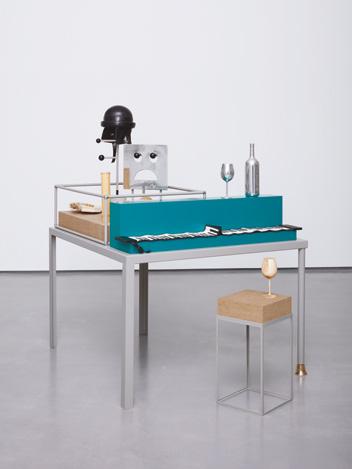
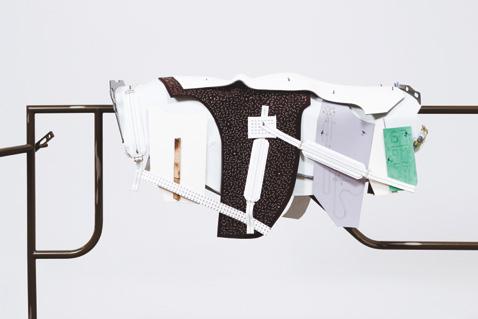
Michael Dean (b.1977, Newcastle upon Tyne, UK) lives and works in London. Recent solo exhibitions include Museo Tamayo, Mexico City (2019); BALTIC Centre for Contemporary Art, Gateshead, UK; and Portikus, Frankfurt, Germany (2017). Recent group exhibitions include Calouste Gulbenkian Museum, Lisbon (2020); The Hepworth Wakefield, Wakefield; and Tanya Leighton Gallery, Berlin (both 2019).
Magali Reus creates sculptural forms, often made in series. Her works are subtly suggestive of familiar machines or apparatus whose function and identity remains intentionally ambiguous. Reus often uses recognisable everyday objects as frameworks for her sculptures, and Harlequin Darts alludes to the form of the horse saddle, motorcycles and blankets. In the work, Reus uses a series of complex techniques to process
a variety of synthetic materials alongside fabric and leather. Like much of her work, the ‘saddle’ suggests proximity to the human body.
Magali Reus (b.1981, The Hague, Netherlands) lives and works in London. Recent solo exhibitions include Shimmer Shimmer, Rotterdam (2020); Galerie Eva Presenhuber, New York (2019); and South London Gallery (2018). Recent group exhibitions include Museum Dhondt-Dhaenens, Ghent (2020); and Talbot Rice Gallery, Edinburgh (2019/20). She has a forthcoming exhibition at Nasher Sculpture Center, Dallas, Texas in 2021.
Presented to Wakefield Council Permanent Art Collection (The Hepworth Wakefield) by the Contemporary Art Society through a special partnership with the Henry Moore Foundation, supported by Cathy Wills, 2019/20
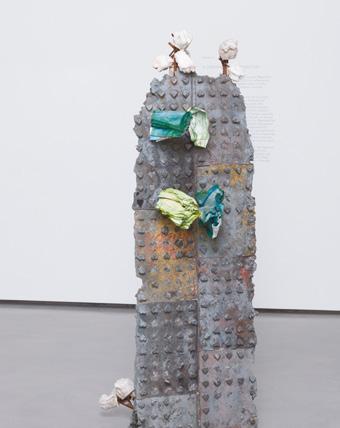
Oscar Murillo
Intaglio print, graphite, ink, marker pen and crayon on paper, mounted on plywood 4 works, each: 56 x 37 x 2.4 cm
In 2019 the Contemporary Art Society supported Art Night for the third year in a row, co-commissioning a work by artist Oscar Murillo. Letter from America was a site-specific installation and performance at the Walthamstow Trades Hall, delving into the effect of gentrification in East London. Shortly after the outbreak of the Covid-19 pandemic and subsequent closure of many international borders, the artist gifted four drawings made over etchings, entitled The Poetics of Flight, to Bristol Museum and Art Gallery.
Oscar Murillo’s artworks are embedded in social engagement. He has experienced extraordinary success with installations, paintings and drawings that expand the possibilities of mark-making mediums: unravelling the canvas from its stretcher onto the floor and hanging works from ceilings. Murillo often works collaboratively and uses recycled materials within his work. Murillo’s work is powerful and poetic, fusing aesthetics with social and cultural histories. Born in Colombia and emigrating to the UK, the migrant experience often permeates his work through its exploration of in-between, ambiguous and ambivalent sentiments.
Oscar Murillo’s (untitled) poetics of flight works make pointed reference to air travel. Aeroplanes have become a site of production, experimentation and research for the artist. Flying enables Murillo to create work and observe current social conditions through an experimental lens. Starting by etching marks and gestures onto a metal plate. These are then printed onto paper and Murillo works on top, building up layers of imagery and
phrases using ink, graphite or crayon. The drawings create a sense of movement, as a manifested stream of consciousness, and become a tangible archive of Murillo’s time spent in the air.
Murillo’s work follows some of the themes explored in the museum’s growing collection of international contemporary art, particularly those of migration and borders. Bristol’s history as a port, involvement in the transatlantic slave trade, the diverse and young population and growing gentrification have all resonated with Murillo, who is interested in histories of labour and movement across urban, rural and transnational contexts. Bristol Museum and Art Gallery curators have also been reflecting on the importance of collecting art that addresses social inequality. 2020 was a significant year for Bristol where campaigns for social and political change were amplified in the media.
Oscar Murillo (b.1986, La Paila, Colombia) lives and works in various locations. Recent solo shows include Aspen Art Museum, Colorado (2020); Kunstverein, Hamburg (2019-20); Kettle's Yard, Cambridge and chi K11 art museum, Shanghai (both 2019). Recent group shows include the Swiss Institute, New York (2021); The Shed, New York and Yorkshire Sculpture Park (both 2019). In 2019 Murillo was nominated for the Turner Prize and won as part of a collective of the four nominees. Murillo has a current solo show at Mori Art Museum, Tokyo (until 22 April 2021).
Presented by the Contemporary Art Society, in association with Art Night 2019, with support from Emma and Fred Goltz and the artist, 2020
‘The last decade has offered a wealth of geographical reearch through firsthand travel... these drawings are witnesses of energy download at the speed of flight.’
Oscar Murillo, artist‘This has indeed been an intense year and it is so very exciting for us at Bristol Museum and Art Gallery to have Oscar’s record of it. Thank you to the Contemporary Art Society for your assiduous work pulling this together for our collection and visitors.’
Julia Carver, Curator of Modern & Contemporary Art Bristol Museum and Art Gallery
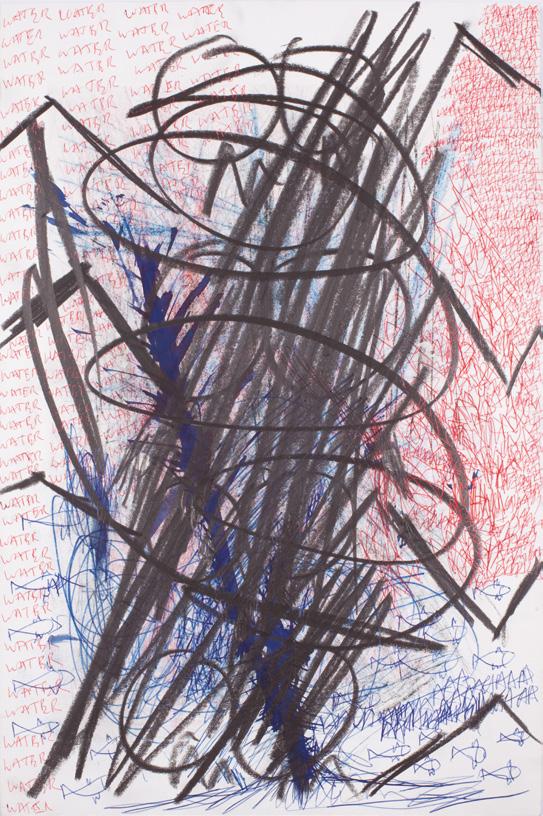
Antepartum
1973
Black and white 8mm film loop transferred to DVD duration: 1.30-minute loop (AP + 5/5)
In 2019 Mary Kelly’s important early film Antepartum was acquired for the Royal Pavilion & Museums Trust, Brighton & Hove’s Fine Art Collection, through the Valeria Napoleone XX Contemporary Art Society award, which supports the acquisition of significant works by a living female artist for a museum collection.
Mary Kelly is an established figure on the international art scene. She was renowned early in her career for introducing feminist concerns into the male-dominated conceptual art world in the 1970s. The film Antepartum is part of a series of works where Kelly focuses on the experience of pregnancy and motherhood. It is a prologue to her iconic Post-Partum Document (1973–1979), a six-year project in which Kelly, influenced by psychoanalytic theory, explored and documented the mother-child relationship. Composed of a black-and-white single close-up shot, Antepartum portrays a pregnant stomach at full term. Action is minimal: we witness the woman’s abdomen rising and falling with each intake and exhalation of breath. The subject’s hands lightly caress her stomach. The baby’s foetal movements are at times visible under the surface of the skin. The short film is projected as a continuous loop which enables viewers to feel they are watching a pregnancy in real time.
Inspired by contemporary experimental filmmaking, Kelly refuses narrative. Such an aesthetic reflects earlier durational filmworks, such as Andy Warhol’s iconic films
Sleep and Empire (1964). However, going beyond highlighting the surface nature of the film image, Kelly uses the durational film to communicate a female experience that lies outside of conventional narrative language and makes visible what was invisible in the art world at the time. She encourages a re-thinking of conventional concepts of what constitute ‘creativity’ and ‘productivity’.
Antepartum is part of Royal Pavilion & Museums Trust’s new collection of artists’ moving image from the 1970s acquired through the Art Fund’s New Collecting Award and the CAS. Antepartum will also serve to comment on and interrogate the museum’s existing painting collection and its historical representations of women more generally. The Valeria Napoleone XX Contemporary Art Society award proves a milestone in RPM’s efforts to diversify its collection and increase its representation of women.
Mary Kelly (b.1941, Iowa, USA). Recent solo exhibitions include Weatherspoon Art Museum, Greensboro (2019); Tate Modern (2016); and Tate Britain (2013). Group shows include MoMAPS1, New York (2019); National Gallery of Australia, Canberra (2018-2019); and Kettle’s Yard, Cambridge (2018).
Presented by the Contemporary Art Society through Valeria Napoleone XX Contemporary Art Society, 2019/20
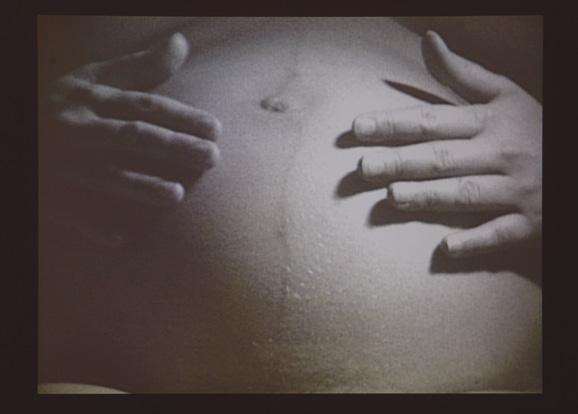
‘I am delighted that Antepartum has been acquired by the Brighton Museum and Art Gallery. England was the birthplace of my career as an artist and it is especially fitting that the very first work in my extended project on the mother/child relationship should be available to audiences there. I am grateful to the Contemporary Art Society for their enthusiastic support and to Valeria Napoleone for her important patronage of women artists.’
Mary Kelly, artist‘Made possible by Valeria Napoleone’s generosity and her incredible knowledge of art, the acquisition of Alexandra Bircken’s The Doctor brings a powerful sculptural statement to The Hunterian. We are thrilled to be able to bring this piece into contact with the artistic and scientific objects in our collection, many of which manifest 18th-century worldviews that were encyclopaedic in ambition but always partial in reality, not least in respect of gender. We look forward to discovering how The Doctor will animate and agitate our collections in future exhibitions and displays.’
Dominic Paterson Curator of Contemporary ArtThe Hunterian, University of Glasgow
Alexandra Bircken
The Doctor
2020
Steelbase mannequin, fabric, wadding, thread, metal, prosthesis, wood and boat model
183 x 62 x 60 cm
Alexandra Bircken’s sculpture The Doctor has been acquired for The Hunterian, University of Glasgow, through the Valeria Napoleone XX Contemporary Art Society award, which supports the acquisition of significant works by a living female artist for a museum collection.
Bircken’s practice utilises sharp contrasts of materials and textures to construct an artistic language that stresses physicality and embodiment as key sculptural qualities. Her signature works often feature found objects, ranging from high-end technology such as motorbikes to more modest materials including fragments of the natural world and fabrics. The synthetic and the organic, the prestigious and the lowly, are frequently spliced together in her oeuvre to create arresting compound forms. The relationship of the human body to these different objects and materials is a recurring theme, and at times – as in The Doctor – the works themselves assume something like human form. In Bircken’s hands, however, allusions to corporeality are never reassuringly simple or straightforward. Rather, our material presence in the world is consistently registered as strange, unfamiliar and perhaps disruptive, and while Bircken’s sculptures assert a powerful self-sufficiency, they also seem to be subject to powerful forces outwith themselves. In unsettling the idealising tradition in classical sculpture, for which the human form was a vehicle to aesthetic purity and sublimation, Bircken makes room for a characteristically heterogeneous and complex sense of bodily existence to take its place, one that is readily recognised as profoundly shaped by the contemporary world.
The Doctor exemplifies many of these characteristic qualities of Alexandra Bircken’s art. Its constituent materials include a surgical gown (a souvenir of the artist’s own treatment for a knee injury), a section from a discarded Christmas tree (set into a prosthetic joint), and a bisected wooden toy boat as its ‘head’, a form which seen in profile becomes redolent both of a scalpel blade and a plague mask.
Within the context of The Hunterian’s historical collections, which originate in Dr William Hunter’s anatomical work and in his voracious 18th-century project of acquiring scientific and artistic objects from around the world, The Doctor asserts a different way of gathering materials and reflecting on human embodiment. Where Hunter’s gaze was identified with objective rationality – and in his influential study of the ‘gravid uterus’, predicated on opening up and annotating the female body – Bircken’s Doctor is assembled from cultural materials animated by her own sensory experience, informed of course by her experience as a woman artist. The work is formed too by the precarious circumstances and physical exposure to risk (and to medical interventions) that have been so palpable in the pandemic conditions of 2020 and 2021.
Alexandra Bircken (b.1967, Cologne, Germany) lives and works in Berlin and Munich. Recent solo exhibitions include Museum Brandhorst, Munich (2021); Herald St, London; Fridericianum, Kassel (both 2020); and Secession, Vienna (2019). Recent group exhibitions include Baltic, Gateshead; Nottingham Contemporary (both 2020); and the Hepworth Wakefield (2019). Bircken holds a Professorship at Akademie der Bildenden Künste, Munich.
Presented by the Contemporary Art Society through Valeria Napoleone XX Contemporary Art Society, 2020/21

2019
Glazed ceramics
53 x 120 cm
The Contemporary Art Society’s Jackson Tang Ceramic Award is a fund focussed on ceramics. Designed to support a major acquisition of ceramic work for a Museum Member, the award is open to artists whose primary material is ceramic, as well as those who only employ the process and material occasionally. This award allows the Contemporary Art Society to acknowledge the current intense interest in ceramics from artists approaching the medium from a variety of different backgrounds. Applications were invited from both Fine Art and Omega Fund curators. Through the Jackson Tang Ceramic Award, in 2019 the Contemporary Art Society acquired Lubna Chowdhary’s Certain Times XXIV for Birmingham Museum and Art Gallery.
Lubna Chowdhary’s shaped tiles, sculptural objects and spatial installations in ceramic constitute a distinctive oeuvre that bridges the disciplines of architecture, craft, design, sculpture and painting. Her colour-rich body of work explores and celebrates the plurality of our built environment. Histories of material culture and cross-cultural confluence are examined to generate new forms that resist easy classification.
Her heritage – born in Tanzania to Pakistani parents who emigrated to the industrial north of England in the 1970s – brings with it the memory of richly designed spaces and diverse architectural landscapes. Subverting the traditional use of clay, Chowdhary merges ideas and aesthetics from Eastern and Western cultures to address the relationship between them.
The tableau Certain Times XXIV evokes the characteristically hybrid architecture of Asian and South Asian cities, their informal conjunctions of tradition and modernity, and the rational and spiritual. The work recalls a view of a distant cityscape, a world captured in space and existing across time. It brings together multiple, overlapping and intimately installed two-dimensional forms that are often metaphorical, but sometimes reference memories of real objects, buildings and places. Special attention is paid to constructing, accumulating and composing elements. Their vibrant glazed surfaces carry the softness and irregularity of hand glazing, which contrasts sharply with the technologically precise cut of the ceramic forms.

Chowdhary’s ceramic work will complement multiple objects in Birmingham Museum and Art Gallery’s Fine and Decorative Art collections, such as the Stanley Sellers collection of studio pottery, Indian miniatures and pieces by Chowdhary’s tutor Eduardo Paolozzi. Cross-disciplinary and de-colonial practice are at the heart of the museum’s new vision and Chowdhary’s vibrant transcultural work will echo the complexity and visual excitement of our shared lives in the UK today.
Lubna Chowdhary (b.1964, Dodoma, Tanzania) lives and works in London. Solo shows include Jhaveri Contemporary, Mumbai (2021); Art Basel Hong Kong (2019); and Kochi-Muziris Biennale, Kerala (2018).
Recent group exhibitions include Green Art Gallery, Dubai (2020); Frieze Art Fair, New York (2020); Manchester Art Gallery (2017). In 2017 she was artist in residence at the Victoria & Albert Museum, London.
Presented by the Contemporary Art Society through the Jackson Tang Ceramics Award, 2019/20
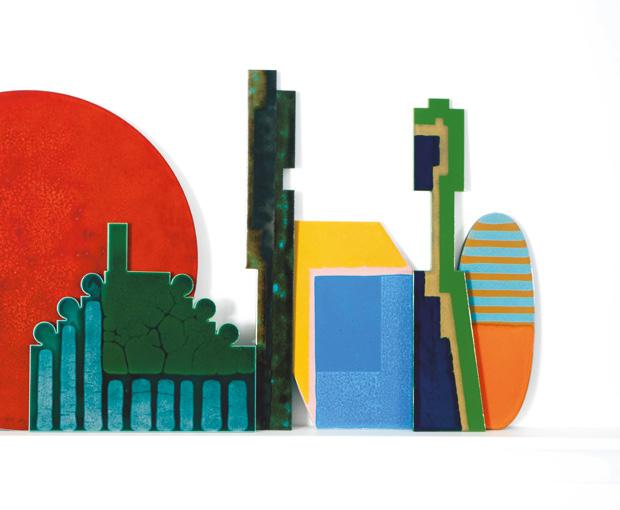
‘Thethemes that Lubna Chowdhary’s ceramics explore, such as transcultural aesthetics, modernism and the theme of metropolis are extremely relevant for Birmingham Museum and Art Gallery, especially as cross-disciplinary and decolonial practice are at the heart of the museum’s new vision. We are excited to see how Certain Times XXIV reinvigorates dialogue around the collection and are thrilled to have been supported by the Contemporary Art Society’s Jackson Tang Ceramics Awards for this important acquisition.’
Emalee Beddoes-Davis, Curator (Modern & Contemporary Art) Birmingham Museums Trust
‘I’m thrilled to have been selected for the Jackson Tang Ceramics Award. It represents a unique opportunity to engage with GoMA, a much-loved institution at the heart of my adopted city, whilst also providing a chance to expand my site-based practice: creating a new, large-scale work that addresses some of the Royal Exchange’s complex history.’
James Rigler, artistOld Money
2021
ceramic, metal leaf
Dimensions vary
Old Money by James Rigler was acquired for Glasgow Museums by the Contemporary Art Society through the Jackson Tang Ceramics Award 2020.
GoMA is housed in Glasgow’s former Royal Exchange, once the economic heart of merchant trade. Previously, the private mansion of a tobacco and sugar merchant was built on profits from slavery and, later became a public library. Considering this complex history and the 25th anniversary of the museum in 2021, James Rigler was invited to work on a new commission for the Jackson Tang Ceramics Award rather than add an existing work to the collection. Rigler has a renowned international profile for his bold, architecturally-inspired ceramics. Based in Glasgow, he has established a research-led practice that uses a site-responsive approach to develop monumental installations, with a particular emphasis on the ongoing influence of historical, architectural and decorative styles.
The commission responds to the decoration of the GoMA building and encourages a renewed interrogation of its history. Taking the form of a new frieze for the interior of the Royal Exchange, it is formed of two elements: a plain shelf structure, carefully tailored to the simple circulation space of the 1996 redevelopment, which in turn supports an informally-arranged collection of metal-leafed ceramic forms. The title, Old Money, refers both to the history of the building and the entrenched privilege it represents. It also reminds us that the meaning and value of coins are, like architectural styles,
socially constructed and can evaporate with changing times.
The support and profile of this award to acquire a striking new site-specific work by Rigler presents the perfect opportunity to demonstrate, nationally and internationally, what GoMA has achieved with a civic collection over the last 25 years in a city renowned for its artists.
James Rigler (b.1978, New Zealand) lives and works in Glasgow. Recent solo exhibitions include Tramway, Glasgow (2014) and Marsden Woo Gallery, London (2015).
Primitive Forms, Rigler’s first major public and permanent installation opened in late 2019 at Aberdeen Art Gallery. Recent Group exhibitions include The Future Perfect, New York & Los Angeles (2019); The New Craftsmen & The Crafts Council UK, Miami (2017) and New Arts Centre, Roche Court, Wiltshire (2015). Rigler was awarded the Jerwood Makers Open in 2012 and the European Ceramic Context Prize for New Talent in 2014.
Commissioned and presented by the Contemporary Art Society through the Jackson Tang Ceramics Award, 2020/21
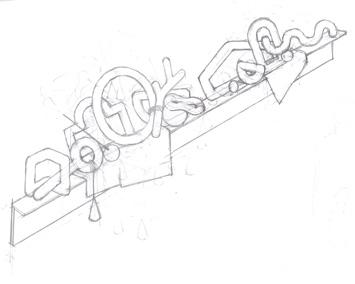
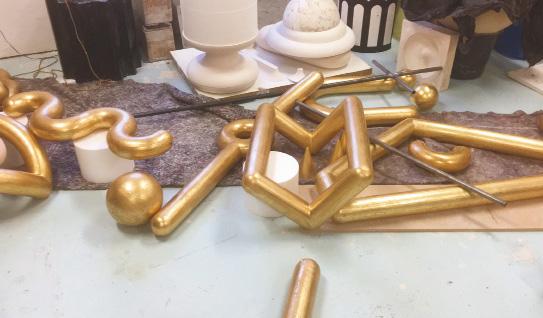
‘The acquisition made possible by the Contemporary Art Society for York Art Gallery affirms a value to the work I do. This level of support, a substantial acquisition of nine works, is also a validation. I feel immensely supported and encouraged knowing the work has found the best possible home, local to where I live, in a Gallery whose collection has shaped my thinking and encouraged my making. Thank you.’
Jade Montserrat, artistGlass, vaseline, paint, metal chain, clay, plaster, lipstick, highlighter
53 x 53 x 3 cm
Karla Black’s sculptures integrate traditional art-making materials with substances of the everyday, such as cosmetics, cellophane and sugar. The use of a pastel palette and cosmetics invites interpretations of her work as feminine, but she denies the gendering of colour and materials. Black’s practice ranges from expansive, immersive installations to smaller, freestanding sculptures. They avoid symbolism instead adopting an abstract approach to material, space and light.
Results Past is a suspended work. It consists of a glass plane painted with Vaseline, lipstick, paint and highlighter, framed with plaster and hung by metal chains. The suspension of the glass creates a precarious situation highlighting the fragility of the work and evoking a sense of tension in the space. While not strictly site-specific, the setting of the work is drawn into the form through the clear glass and its suspension in space.
The potential of the glass to break and the cosmetics to fade foregrounds destruction and decay. Yet there is an emphasis on preservation in the traces of lipstick and fingerprints, documenting otherwise temporary traces. The work marks the detritus of human presence in the world, evoking memories from these ubiquitous materials.
Black draws from abstract expressionism, land art, performance and formalism and is influenced by psychoanalysis and the study of childhood development. The influence of this blend of traditions is present in the work but she challenges the idea of painting and sculpture as distinct from each other. She proposes a vision of painting that is both painterly and sculptural.
This acquisition adds to the growing presence of contemporary female artists in Aberdeen Art Gallery’s collection. Existing works in the gallery’s collection explore the idea of thresholds, crossing boundaries and the psychological power of space. Karla Black’s work is the next step in this legacy of collecting.
Karla Black (b.1972, Alexandria, Scotland) lives and works in Glasgow. Recent solo shows include Fruitmarket Gallery, Edinburgh (2021); Kunsthalle Schirn, Frankfurt (2019); The Power Plant, Toronto (2018); and Modern Art, London (2017). Group shows include Ikon Gallery, Birmingham (2019); Museum Morsbroich, Leverkusen; and Museu d’Art Contemporani de Barcelona, Barcelona (both 2018). In 2011, she represented Scotland at the 54th Venice Biennale and was nominated for the Turner Prize.
Presented by the Contemporary Art Society with support from the Zabludowicz Collection, 2019/20

Simon Ling
Untitled
2018
Oil on canvas
201 × 150 cm
Untitled
2018
Oil on canvas
201 × 150 cm
Simon Ling is best known for his close-cropped paintings of urban and rural settings, often working en plein air. Across his practice, his work employs an intensity of looking or, as the artist puts it himself, ‘it is a question of how you see something, not what it is.’ Both his urban and rural works depict small areas of architecture or landscape, often produced on a monumental size so that a dichotomy emerges between scale and subject. In order to avoid overlaying his works with any suggestion of narrative, Ling does not give his paintings descriptive or allusive titles.
Underpainting in fluorescent orange paint has been a characteristic of Ling’s work for years, the colour vibrating on the edges of each composition, lending them an almost hallucinogenic quality. In these new paintings the contrast between this glowing orange and the dark tones of the wood is even greater –the logs appear as if supernaturally irradiated. The dark voids that draw the eye beyond the foreground recede into infinite, inky depths. In Untitled, Ling introduces a counterpoint to more romantic visions of landscape with these intense depictions of the forest floor and rotting log stacks. Close-cropped treatment of a tumbled woodpile gives each craggy log a powerful presence; the tectonic facets of the cracking bark articulating surfaces that vividly translate the sensation of touch through that of sight.
The works were originally shown in Ling’s 2018 solo exhibition at Towner, Eastbourne. His work has been of interest to Amgueddfa Cymru – National Museum Wales for some time, particularly in terms of his importance to contemporary painting and the relationship between his work and the wider tradition of the art of the Welsh landscape. Ling grew up in Pembrokeshire and retains a studio on the Welsh border; this acquisition adds to the ongoing conversation within the museum collection on the representation of place.
Simon Ling (b.1968 Pembrokeshire, Wales) lives and works in London. Recent solo shows include Greengrassi, London (2020); Towner Art Gallery, Eastbourne (2018); and Kunsthalle Bergen (2015). Recent group shows include Camden Arts Centre, London (2020); The Lewinsky Gallery, Plymouth (2020); and Hong Kong Museum of Art, Hong Kong (2019). In 2018 he was the recipient of the Paul Hamlyn Foundation Award for Artists.
Presented by the Contemporary Art Society, with additional support from the Knapping Fund and the Derek Williams Trust, 2019/20
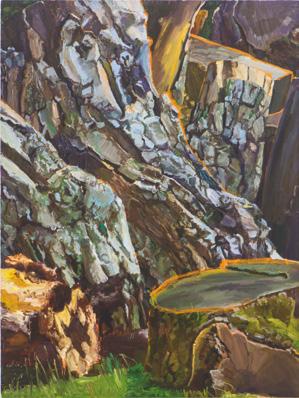

2015
Three channel HD colour video installation, 7.1 sound 48 minutes 30 seconds ed. 4 of 5 + 2 Aps
John Akomfrah is a filmmaker and artist known for his deeply moving works which reflect on diaspora, colonialism, migration and identity. He was a founding member of the Black Audio Film Collective in 1982 in collaboration with seven fellow artists and had his directorial debut with the film Handsworth Songs (1986) about the 1985 Handsworth Riots. The collective created work that centred on the experiences of diasporic communities living in Britain amongst racial tension and political strife.
Akomfrah’s Vertigo Sea takes the ocean as its protagonist, meditating on the relationship between humanity and the sea. The threechannel film, originally made for the 2015 Venice Biennale, explores the sea as a character in slavery, migration and conflict. Akomfrah uses archival material, footage shot on the Isle of Skye, the Faroe Islands and Norway with the BBC’s Natural History Unit, as well as staged scenes. The result is an epic vision of political and ecological unrest. Scenes of breaching whales and natural beauty transition into news reports of migrants drowning at sea. Modern footage of the whaling industry segues into archival film of the atomic bomb test at Bikini Atoll in 1946. The film employs Akomfrah’s signature montage technique to integrate disparate scenes in a unifying vision of awe and terror.
A sensual, poetic and cohesive meditation on man’s relationship with the sea and the exploration of its role in the history of slavery,
migration, environmental destruction and conflict, Vertigo Sea comes to Towner and Amgueddfa Cymru – National Museum Wales with the context of both gallery’s location, situated on the coast. Vertigo Sea extends the way the museums represent artists’ film in their collections and underlines their ambition to acquire an internationally important collection of contemporary art.
John Akomfrah (b.1957, Accra, Ghana) lives and works in London. Recent solo exhibitions include Lisson Gallery, London (2021); Seattle Art Museum, Seattle; Secession, Vienna (both 2020); and BALTIC Centre for Contemporary Art, Gateshead, UK (2019). Recent group shows include Lahore Biennale, Lahore (2020); Museum of Contemporary Art, Chicago (2019); and A4 Arts Foundation, Cape Town (2019).
Vertigo Sea will be shown at Towner, Eastbourne from May until September 2021.
Jointly owned by Towner Art Gallery and Amgueddfa Cymru – National Museum Wales. Acquired with support from Art Fund, the Derek Williams Trust, The Search Foundation through the Contemporary Art Society, and Towner Collection Development Fund.

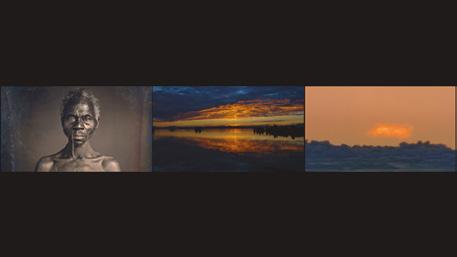
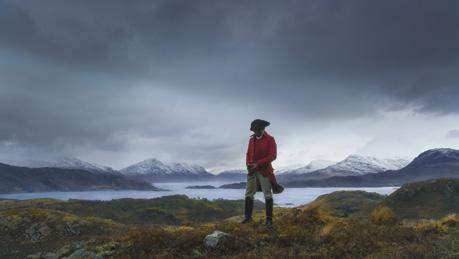
Elvira Bach
Untitled 1980
Gouache on off-white wove paper
20.9 x 29.5 cm
Untitled 1980
Oil pastel on white wove paper
29.4 x 20.8 cm
Untitled 1981
Gouache on off-white wove paper
29.6 x 20.9 cm
Untitled 1982
Oil pastel with gouache on off-white wove paper
49.8 x 34.8 cm
Elvira Bach works primarily in painting, drawing, printmaking and sculpture. A recurring motif in her work is the figurative representation of women, using her hyperexpressive style to deconstruct conventional depictions of femininity. Bach was an important figure in the Neo-Expressionist movement in the 1980s and ’90s and is especially associated with the ‘Neue Wilde’ generation of artists. Like the work of her Neo-Expressionist contemporaries, Bach’s practice is characterised by vivid, flamboyant colours and a strong, gestural style that stands in opposition to the dominant trends of conceptual and minimalist art.
These works are unique watercolour and crayon works on paper, and complement a print of the artist’s already in the Ashmolean’s collection. They are early works that exemplify her expressive, figurative language and deployment of colour, often involving her
own life and representing herself. A work from 1980 depicts a period of lovesickness, showing the artist lounging on a bed next to a bright red heart. Another work is an image of celebration featuring glasses of red wine and strawberries strewn on the floor between her legs. A third work from 1981 shows the artist at home amongst various domestic items: a bright red telephone, a television and a potted palm tree. The dynamic A3 work from 1982 was made during a residency in the Dominican Republic. It can be interpreted as a depiction of herself again, dancing with her partner against a deep blue night sky. The motifs and the artistic language are typical of Bach, appearing in many of her later drawings and paintings.
The Ashmolean’s collection of works on paper includes a group of German Neo-Expressionist prints by artists such as Georg Baselitz, A.R. Penck and Markus Lüpertz. Bach has been represented until now through one untitled screen print from 1983, and women artists in general are underrepresented in the NeoExpressionist collection. This acquisition will assist in creating representative and inclusive narratives of the movement at the Ashmolean.
Elvira Bach (b.1951, Neuenhain, Germany) lives and works in Berlin. Recent shows include the Museum of Contemporary Art, Ottobeuren (2015); Historic Town Hall, Limburg an der Lahn (2013); and Gallery Art350, Istanbul (2013).
Presented by the Contemporary Art Society and Art Fund, 2019/20

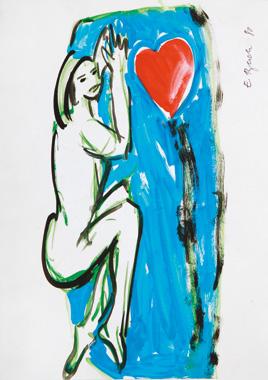

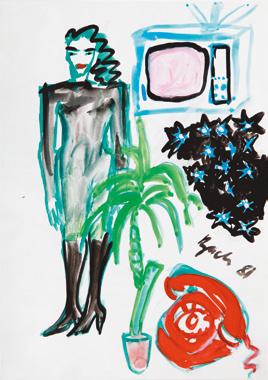
Carved wood and aluminium leaf
141 x 141 x 10 cm
Mark Titchner’s practice navigates the complex web of ideologies and belief systems that form our zeitgeist. The work is an exploration of how ideas are filtered through culture, moving from the counterculture to the mainstream. He often juxtaposes conflicting sentiments to reveal the influence of political, religious and scientific belief systems on our lives. He is concerned with how we receive ideas through public messaging and how the same utopian sentiments exist across different media from political propaganda to advertising.
Love and Work is one of an ongoing series of carved wooden pieces that are often made alongside fellow artists who work with digital prints. The text was inspired by sayings of the radical Austrian psychoanalyst, Wilhelm Reich: ‘Love, work and knowledge are the wellsprings of life, they should also govern it’; and Lebanese-American poet Kahlil Gibran: ‘Love is work made solid’.
Titchner explains that in 2003 he began using the computer as his primary tool for drawing, viewing it as a contemporary form of cottage industry. This led him to create carved wooden works which he compared to a ‘devotional process’. The work was carved in wood, burnt and then aluminium leaf applied to the surface. The works are digitally designed and then executed by hand, making visible the labour involved in the process. It is in line with the text of the work which emphasises the relationship between labour and devotion. The central design element is based on the figure of the lotus flower, often found in Buddhist art. This is combined with floral elements commonly found in the Arts and Crafts movement and a text rendered in the Futura font.
Titchner has worked on a number of projects in Birmingham. The themes of Titchner’s work and his Arts and Craft movement-inspired aesthetic, have repeatedly come to the fore as an area of interest at Birmingham Museum and Art Gallery.
Mark Titchner (b.1973, Luton, UK) lives and works in London. Recent solo shows include Firstsite, Colchester (2019); Ikon Gallery, Birmingham (2018); and LOKAAL 01, Antwerp (2016). Group shows include The New Art Gallery Walsall, Walsall; The Drawing Room, London (both 2019); and National Taiwan Museum of Art, Taichung (2018). He was nominated for the Turner Prize in 2006.
Presented by the Contemporary Art Society, 2019/20
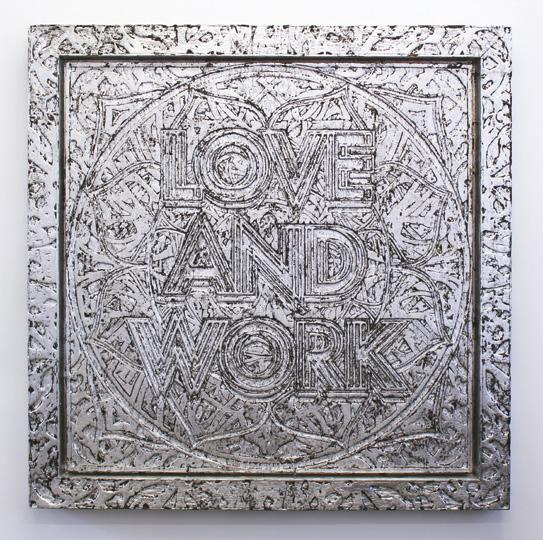
Rosie Hastings & Hannah Quinlan
They will flee like chaff scattered by the wind or like dust whirling before a storm
2020
Framed diptych, graphite on paper
38 x 50 x 3.5 cm each
Opposite
Gaby
2018
Digital Video
7:55 minutes
Rosie Hastings & Hannah Quinlan are a multidisciplinary artist duo, interrogating the iconography of queer culture through sound, moving image, live events and through incredibly skilful drawings. They map the queer landscape in a myriad of ways, creating bodies of work that place underrepresented narratives at the forefront of their practice. One of their most prominent works is the UK Gay Bar Directory, an archive documenting over 100 LGBTQ+ venues across the UK. Their works serve as archival resources because of the emphasis on community and the importance of being queer and existing loudly.
In their films, Quinlan & Hastings have used a variety of objects from mobile phones to professional cameras and have created works with CGI, found footage, archives and moving image. Named after their best friend, artist Gaby Sahhar, the film Gaby is comprised of three vignettes portraying the intricacies of intimacy and destruction, framed around the politics and commodification of the queer body. They explore storytelling from an intimate perspective to the wider political impact, reflecting on lived experiences and raising questions of safety among the LGBTQ+ community.
Quinlan and Hastings’s diptych They will flee like chaff scattered by the wind or
like dust whirling before a storm portrays another aspect of their practice. These works deconstruct the power dynamics of place and agency through the gendered lens of visibility. Reminiscent of technical masters like Hogarth yet quintessentially distinctive to their contemporary style of queer narration, these graphite works focus on the foray of limbs in motion, capturing a sense of urgency and anxiety regarding the ownership of space.
One of The Box’s acquisition priorities is to collect emerging artists that radically rework specific histories in Britain, while making use of classical forms. The Box has also, for many years, been developing a community project looking at nightlife, and in particular sound and rave culture, which will be presented as an exhibition in the near future. The addition of these works will enable the collection to convey this theme in a variety of forms. Acquiring works on paper and film also contextualises the artists’ practice and adds to the museum’s increasing South West Film and Television Archive.
Rosie Hastings and Hannah Quinlan (b.1991, Newcastle and London) live and work in London. Recent solo shows include Isabella Bortolozzi, Berlin (2020); Focal Point Gallery, Southend-on-Sea (both 2020); and FIAC with Arcadia Missa, Paris (2018). Upcoming exhibitions include Humber Street Gallery, Hull (2021). Recent group shows include Maison Populaire, Montreuil France (2020); Hayward Gallery, London; and Whitechapel Gallery, London (both 2019).
Presented by the Contemporary Art Society with the support of The Box, 2020/21


Barbara Walker
I Was There IV
2018
Ink and tracing paper on digital media paper (framed) 48.9 x 38.9 cm
Opposite, top
I Was There V
2018
Ink and tracing paper on digital media Paper (framed) 48.9 x 38.9 cm
Opposite, bottom
Barbara Walker is a figurative artist who works with different media and formats, ranging from small embossed works on paper to paintings on canvas and large-scale charcoal wall drawings. Her monochrome images are often based on archive material, unearthing underrepresented histories.
The intimately scaled ink drawings I was there V and I was there IV are part of a body of work that addresses the largely untold stories of African and Caribbean servicemen and women’s contribution to the British Armed Forces. Both drawings depict Black soldiers on tracing paper, laid over digitally printed anonymous photographic images of Black, Asian and white soldiers. The red W and E are reminders that soldiers came from the Western and Eastern parts of the former British Empire. Overlaying her drawings of underrepresented Black soldiers onto the historic photographs in a kind of palimpsest is a statement of their presence, but one which doesn’t erase the soldiers over whose images the drawings are placed. For Walker the fragile and sometimes ephemeral nature of the media she uses –chalk, embossing, tracing paper – is a vehicle for highlighting the erasure of Black histories. For example her chalk drawings are washed away from the gallery walls, or, in a reversal of history, white figures are embossed and thus blanked out of reworkings of historic
paintings with Black sitters. Inverting the anonymising act, Walker’s portraits reclaim an equal and independent position of the former ‘other’, establishing their own narratives as opposed to the ones put forward by the former colonial masters.
In recent years Bristol Museum & Art Gallery has been developing its international contemporary art collection with a strong postcolonial perspective. To continue in this vein, the museum is now looking at Britishbased art that presents a critical perspective on the world. Barbara Walker’s focus on visibility and representation continues the postcolonial critique of British history.
Barbara Walker (b.1964, Birmingham, UK) lives and works in Birmingham. Recent solo exhibitions include Turner Contemporary, Margate (2019–21); Jerwood Gallery, Hastings (2018); and MAC, Birmingham (2016). In 2024 Walker will have a solo exhibition at the Whitworth Art Gallery, Manchester. Group exhibitions include Lahore Biennale, Pakistan (2020); Southbank Centre, London (2020); SCAD Museum of Art, Savannah, Georgia, USA (2019); and Firstsite, Colchester (2019). Forthcoming group exhibitions include Tate Britain (2021); Sunderland Winter Gardens (2022); and National Portrait Gallery, London (2024).
Presented by the Contemporary Art Society with support from the Friends of Bristol Museums Galleries & Archives, 2019/20
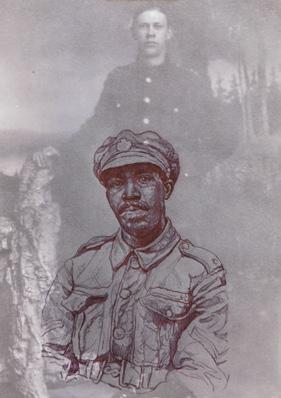

Joy Gerrard
Protest Crowd, London, (March against Brexit, 21 March, 2019)
2019 Japanese ink on linen
230 x 130 cm
Joy Gerrard has been making images of mass protests since 2003, including anti-Iraq War demonstration in London, the Arab Spring, the Occupy movement, and more recently, the anti-Trump and anti-Brexit marches and Black Lives Matter demonstrations. Her arresting images are based on aerial perspective press images. We are used to images of crowds, taken from above to show their massive scale against recognisable landmarks. Gerrard’s treatment defamiliarises this trope. The colour of the source material is replaced by a funereal monochrome grey and white, with large flat black areas that seem to create ‘holes’ in the composition. Gerrard works with the canvas horizontally, reflecting the downward-looking perspective of her images, which shifts again once the painting is on the wall. She uses Japanese ink to create the dense blackness in her oeuvre and grinds the colour pigments herself.
Gerrard’s large-scale canvases blur the individual figures into abstract marks. Equally, the buildings in Protest Crowd, London, (March against Brexit, 21 March, 2019) are nondescript. Only the banner, ‘PUT IT TO THE PEOPLE’ indicates what we’re looking at. The painting reflects the ambiguity –even polarisation – within the anti-Brexit movement by depicting the movement of the crowd pulling in different directions. She also destabilises the surrounding architecture to reflect how Brexit has unbalanced our political structures. Brexit will have an enduring effect for generations and it is one of the most divisive issues of our time. Are the marchers in Protest Crowd contained by the streets or have they claimed them?

In recent years, Bristol Museum & Art Gallery has concentrated on collecting artists who address topics such as surveillance and the notion of the modern metropolis. It is within this thematic context that Joy Gerrard’s image, which reflects a new era of mass protest, enters the collection.
Joy Gerrard (b.1971, Dublin, Ireland) lives and works between Belfast and London. Recent solo exhibitions include The Golden Thread Gallery, Belfast (2020); Royal Hibernian
Academy, Dublin (2017); and PEER, London (2015). Selected group exhibitions include Cristea Roberts Gallery, London (2019); The Drawing Room, London (2017); and MAC International, Belfast (2016). Gerrard has recently received a major Irish Arts Council bursary award to support a forthcoming three-venue touring exhibition in 2021/22.
Presented by the Contemporary Art Society with support from the Friends of Bristol Museums Galleries & Archives, 2019/2020

Samson Kambalu
Moses (Burning Bush)
2015
Digital video, colour
32 seconds
Edition 3 of 3 + AP
Opposite
Moses Synopsis
2020
Wall vinyl dimensions vary
Influenced by Situationism, Western philosophical thought, silent film and by spiritual rituals practiced in South-East Africa, Samson Kambalu embraces the subversive potential of non-productive time, the gift economy and the notion of playing.
He is best known for his Nyau Cinema, an ongoing series of short films that are made in various locations around the world in which the artist explores new places with his camera, using his own body as the subject of his playful, spontaneous and site-specific performative actions. Kambalu’s films are often based on Nyau Culture, a secret society of the Chewa tribe in Malawi, which is especially known for its ritual mask performances. Influenced by the experience of watching films as a child in Malawi, his films have the look of found footage from early cinema and have been described as ‘cinematic fragments that blend slapstick and spiritual ritual’.
The addition of Kambalu’s film Moses to the Permanent Collection Gallery at Bury Museum interjects a new medium to the historical oil paintings that dominate the space, expanding representations and ideas of landscape. Central to Kambalu’s work is the idea of the gift – ‘the gift of time’ as he describes it – and a momentary pause is required to absorb the film that shows the artist throwing his hat up in the air in a landscape in Arizona. Kambalu’s
film responds spontaneously to the landscape in which it is created, in opposition to the landscape paintings in the collection that are painted over a much longer period. Kambalu’s playful movement and the changing of the film’s colour enhance the magical qualities of the hat hovering ‘like a bird’ in the air, reinforcing Kambalu’s notion of film ‘being a form of miracle’.
A focus of contemporary collecting at Bury Art Museum has been the development of the Text Art Archive, with a focus on language art, and Kambalu’s vinyl text piece that accompanies his film is a timely addition to this collection. The acquisition of works by Samson Kambalu is also an important signal of Bury’s commitment to re-address the balance of the permanent collection and the society it represents.
Samson Kambalu (b.1975, Chiradzulo, Malawi) lives and works in Oxford. Recent solo-exhibitions include PEER, London (2020); Kate MacGarry, Statements, Art Basel, Switzerland (2017); and Whitechapel Gallery, London (2016). Recent group-shows include Mu.ZEE, Ostend, Belgium (2020); La Villette, Paris (2017); and Venice Biennale (2015). In 2021 Kambalu was shortlisted for the Fourth Plinth Commission, London.
Presented by the Contemporary Art Society, 2019/20
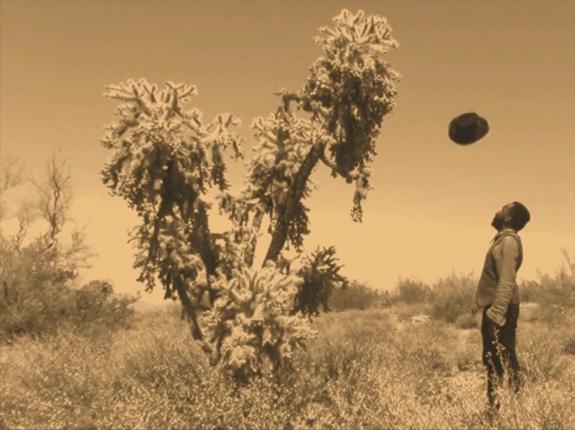
Charmaine Watkiss
Knowledge Keeper
2019
Pencil, watercolour, coloured paper and gum on paper
175 x 65 cm
Opposite, left
We are Here
2015
Pencil, gouache and ink on Fabriano paper
148 x 78 cm
Opposite, right
Charmaine Watkiss’s primary medium is drawing. As a person of the Caribbean diaspora, Watkiss is inspired by her Jamaican heritage. Exploring African traditions and cosmology is integral to her practice. It may appear that Watkiss herself is the focus of her life-sized works, but her drawings are not self-portraits; rather, they are characters that navigate and reimagine ideas of ancestry, tradition, ritual and cosmology.
Watkiss is known for using one colour other than graphite pencil in her work, indigo. Historically, the value of indigo increased as it became commodified in West Africa. It was transported to the Americas during the transatlantic slave trade and produced on plantations throughout the Caribbean until the end of the 18th century. In West Africa, indigo dyeing dates back to the 11th century and among the Yoruba women of Nigeria a distinct technique developed called Adire (Hand tie and indigo dye) that has become a symbol of cultural heritage and women’s entrepreneurship.
Watkiss engages with indigo’s sacred use in ancient African cultures, particularly with reference to funerary rites and spiritual beliefs. This connection is established vividly and poetically in Knowledge Keeper, with intricate geometric motifs in various shades of blue.
Stars within the clothing and the string in the hands create the infinity symbol, exploring the retrieval of ancient knowledge outside of the boundary of time. Similarly in We are Here, the dress also features cosmic stars and within the hands is a star created through the game Cat’s Cradle.
For Bradford Museums and Galleries, acquiring these drawings by Charmaine Watkiss will add to the growing number of works documenting a myriad of Black British female experiences. The curators also intend for Watkiss’s works to inspire their audiences and ignite a potential passion for an artistic career path. When on display, the works will facilitate discussions with the diverse communities within the district, in particular the Caribbean community.
Charmaine Watkiss (b.1964, London) lives and works in London. Recent solo and group shows include Collyer Bristow Gallery, London (2020); Carl Freedman Gallery, Margate (2021); Tiwani Contemporary, London (2020); Leicester Gallery, Leicester (2020); and Trinity Buoy Wharf Drawing Prize (2019). Watkiss holds an MA in Drawing from UAL Wimbledon College of Art (2018). Her work will also be featured in the Drawing Biennial 2021.
Presented by the Contemporary Art Society, 2019/20

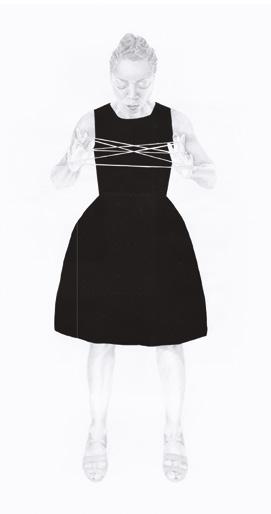
Thomas J. Price
Head #13
2012
Bronze, perspex, automotive spray paint
21.8 x 9 x 11 cm
Edition of 3
Opposite, top
Mental Structure #19 (Just Beyond This)
2015
Bronze, perspex, automotive spray paint
21 x 11 x 11 cm
Edition of 3
Opposite, bottom
Mental Structure #20 (A Long Time Now)
2015
Bronze, perspex, automotive spray paint
21 x 11 x 11.5 cm
Edition of 5
Thomas J. Price works across film, photography and sculpture to convey issues of power, structure, representation and perception. Price explores complex issues of diversity and representation in both society and art. Part of his practice revolves around the viewers’ perception, challenging stereotypes, preconceptions and assumptions of the images he creates.
Price’s sculptures are fictional, mainly male and Black. They are amalgamated from a range of sources, from classical sculpture to individuals observed in the artist’s everyday life. The ‘Head’ series is an ongoing project since 2006 and features bronze busts situated on brightly coloured plinths. Head #13 is one of the earlier works to be acquired; the initial sculpting process was incorporated into the BBC documentary, How To Get A Head In Sculpture.
Mental Structure #19 (Just Beyond This) and
Mental Structure #20 (A Long Time Now)
were completed during a residency at the Nirox Sculpture Park, South Africa. Created in part from observations of the park staff and residents of Johannesburg, as well as in response to some of Price’s previous pieces and historical sculptural references, the works speak to the resilience of many of the people Price encountered during the residency, who were still having to navigate society following the end of apartheid. In these sculptures, the artist engages with a psychological understanding of our socially learned attitudes as well as the impact that the media and taught behaviours have upon our perception of other people.
The Collection and Usher Gallery has a particular interest in collecting contemporary art that explores concepts of authorship and reproduction, reflected in recent acquisitions through the Contemporary Art Society by Alan Kane and Oliver Laric. Price’s work in the collection will address this by engaging with and facilitating questions around representation within art and wider society.
Thomas J Price (b.1981, London) lives and works in London. Recent solo shows and projects include The Line, London (2020); The Power Plant Contemporary Art Gallery, Toronto (2019); and Frieze Sculpture, London (2017). Recent group shows include ARKEN Museum of Moderne Kunst, Copenhagen (2021); Goodman Gallery, London (2020); and Somerset House, London (2019). Price is currently working on a commission for Hackney Council to honour the Windrush generation, which will be unveiled in 2022. Purchased with support from Art Fund, Contemporary Art Society and the Heslam Trust, 2020/21


Lubaina Himid CBE
The Crown 2019
Acrylic and pencil on paper
102 x 72 cm
Lubaina Himid was one of the first members of the Black Arts Movement founded in the 1980s, and has since continued to make activist art. Himid strives to bring visibility to marginalised historical narratives of Black people by interrogating their relationship with colonialism and Empire. Dominant structures of wealth, gender, class and colonialism are prominent themes engaged with through resistance and resilience.
Himid paints on a variety of materials from paper to wood and ceramics, manipulating scale and depth to confront invisible narratives. Her work is mostly figurative and has a theatrical quality. It is rich in bright colour and patterns. Ultimately, Himid aims to develop a conversation with an audience, and to ascribe value to Black people’s contribution to Europe’s culture over the past several hundred years.
Himid created a second series of work to which The Crown belongs, whilst creating work for her solo exhibition at the New Museum in New York. The Crown is part of a series of works that delves into the relationship between people and objects. The inspiration for The Crown comes from Himid’s own family as her grandparents were successful publicans in the North of England. The painting explores her interest in restitution, through the theme ‘make do and mend’. ‘Make do and mend’ ultimately expresses how traumas have been navigated by Black people over the past 600 years, the broken sign representing the complexity of the relationship that many people have with Empire.
Himid has a close collection with the Blackpool region where the Grundy Art Gallery is situated. Himid arrived in Blackpool when she migrated to England from Zanzibar. Honouring this connection, The Grundy Art Gallery is pleased to receive this work, featuring The Crown as the first work in ‘Collection Spotlight – Portrait’, a series of collection-focused exhibitions that, throughout 2021, will celebrate the 110th anniversary of the Grundy.
Lubaina Himid CBE (b.1954, Zanzibar, Tanzania) lives and works in Preston. Recent solo exhibitions include Frans Hals Museum, The Netherlands (2019); Musée d’art contemporain de Bordeaux, France (2019); and New Museum, New York (2019). Recent group shows include Wiels Contemporary Art Museum, Brussels (2020); Hollybush Gardens, London (2020); and Hayward Gallery touring exhibition (2020). In 2017, Lubaina Himid won the Turner Prize. She is also Professor of Contemporary Art at the University of Central Lancashire. Himid will have a major solo exhibition at Tate Modern in November 2021.
Presented by the Contemporary Art Society, 2019/20
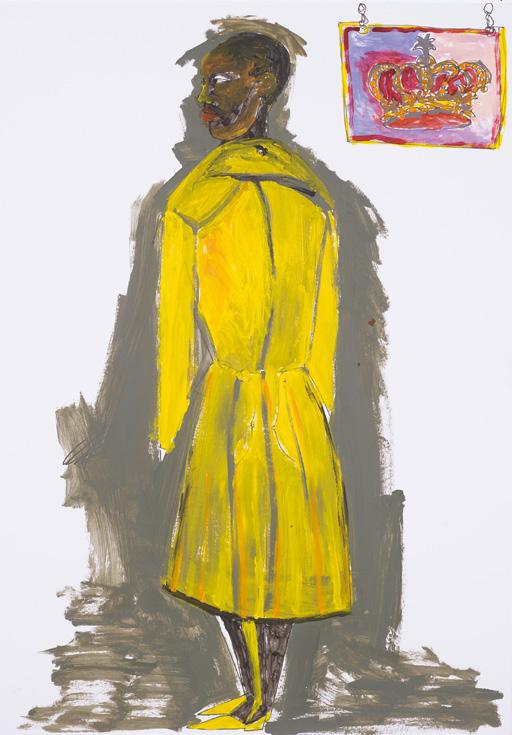
Matthew Krishanu
Boy in a Pool
2019
Acrylic on canvas
50 x 60 cm
Two Boys in a Boat
2019
Oil on board
46 x 61 cm
Two Boys on a Log
2019
Oil on board
61 x 46 cm
Opposite
Matthew Krishanu’s work looks back at his upbringing in the UK, India and Bangladesh, exploring notions of childhood, memory and place. Born in Bradford to a British father and an Indian mother, Krishanu emigrated to Bangladesh aged one before returning to the UK when he was 12. It is this period of early childhood spent with his parents and brother that features in much of Krishanu’s work. His other series of works have focused on the expat community he lived amongst in Dhaka and his father’s work as a missionary in Bangladesh.
Many paintings depict the artist and his brother exploring natural landscapes, recalling how these expansive spaces would feel to a small child. Yet the works are not from the perspective of childhood as it is experienced at the time but the act of looking back through the hazy filter of memory.
Two Boys on a Boat is set on a riverboat with the distinctively flat horizon of Bangladesh expanding into the distance. Two Boys on a Log depicts the brothers in Kashmir above rapidly cascading water; the boys are both precarious and assured in their position. The third painting, Boy in a Pool, shows a small, solitary figure in a comparatively vast body of
water. Krishanu recalls that he and his brother often swam in pools or lakes; in this case they are in Kashmir. The paintings draw from photographs and memories, capturing how the passage of time makes early memories appear dreamlike: an effect aided by the eerie beauty of the landscape. Elusive childhood memories are easy to sentimentalise – something the works avoid by presenting childlike naïveté through the knowing gaze of adulthood.
Krishanu’s first major solo show ‘The Sun Never Sets’ was a landmark exhibition for Huddersfield Art Gallery. It cemented Krishanu’s status as an important emerging figurative artist. It is a timely acquisition that complements Huddersfield’s existing collection of British painting.
Matthew Krishanu (b.1980, Bradford, UK) lives and works in London. Recent solo shows include Niru Ratman Gallery (2020); Iniva, London; Midlands Arts Centre, Birmingham; Ikon Gallery, Birmingham (all 2019); and Huddersfield Art Gallery (2018). Group shows include Walker Art Gallery, Liverpool (2021); Hayward Gallery/Southbank Centre; and Lahore Biennial, Lahore (both 2020).
Presented by the Contemporary Art Society, 2019/20

Uriel Orlow
Muthi 2017
15 mins
Uriel Orlow’s work often engages with specific locations and events, using archives and research-led processes to excavate micro-histories. Orlow explores the spatial and pictorial conditions of history and memory, working across video, photography, drawing and sound.
Muthi is part of a long-term project entitled Theatrum Botanicum (2015-2018) which explores botany and nature as a site of political meaning and tension. Orlow views plants as actors as well as witnesses to history. The project looks at Europe and South Africa, considering the role of plants in the history of medicine, spirituality, economic exploitation and colonialism.

‘Muthi’ means tree in Zulu and is the term for traditional medicine in Southern Africa. Before the establishment of Western medicine in the area, Muthi was the dominant form of healing. Under British colonial rule it was deemed ineffective and unscientific, however it was also perceived as a threat to the dominance of European culture. Since then, pharmaceutical companies have come to understand the commercial potential of medicinal plants, to the detriment of traditional practitioners. The film follows the endurance of traditional medicine in rural and urban environments including Johannesburg, the Western Cape and KwazuluNatal. It explores how Muthi is a healing and spiritual practice, however it is also embedded in an economic system. The film explores the role of traditional healing in modern life and the continuation of indigenous knowledge and alternative medicine in the face of erasure.
Since Leamington Spa Art Gallery and Museum’s move to the Royal Pump Rooms in 1999, the collection has focused on medical history. The building was historically used for medical treatments, particularly hydrotherapy and physiotherapy. The collection reflects the history of the building as a space for healing and the acquisition of Uriel Orlow’s work builds upon this legacy of acquiring contemporary works that explore medicine and healing.
Uriel Orlow (b.1973, Zurich, Switzerland) lives and works between London and Lisbon. Recent solo exhibitions include Kunsthalle Mainz (2020); La Loge Brussels (2020); and State of Concept Athens (2020). Recent group exhibitions include Taipei Biennial (2020); Riga Biennial (2020); Lubumbashi Biennale (2019); and Manifesta 12 (2018). In 2021–22 Uriel Orlow will participate in the British Art Show 9. In 2017 he was awarded the Sharjah Biennial Prize, and in 2020 he received the Conrad Ferdinand Meyer Prize.

Katie Paterson
Precious metals returned to their stars
2017
Micro-waterjet-cut sterling silver Edition 1/3
11 x 21 x 0.3 cm
Opposite, top
A mountain carried away stone by stone
2017
Micro-waterjet-cut sterling silver
Edition 3/3
11.3 x 18.9 x 0.3 cm
Opposite, bottom
A fountain drawing water from the ocean’s deepest point
2020
Micro-waterjet-cut sterling silver Edition 2/3
32.5 x 11 x 0.3 cm
Katie Paterson’s work engages with the landscape both as a physical entity and as an idea. Her work is highly conceptual. Fusing science with fine art she draws on the natural world, with geological references to create minimal yet romantic poetic works. She is well known for her work Future Library, an ongoing project that utilises paper grown in a forest in Norway. Each year, a poet creates a work that will eventually become an anthology of 100 submissions. The project is in its sixth year and has contributions from poets all over the globe. Paterson’s ‘Ideas’ series also dates back to 2014 and is an ongoing lifelong project. Ideas are crafted from solid silver, with text inscribed reminiscent of Japanese haiku. In their evocation of natural imagery, the
ideas are cosmic in scale but become alive in the imagination of the viewer to become an expression of the idea itself. Thinking and imagining are a vital part of Paterson’s practice. She also collaborated with scientists, astronomers, geologists and meteorite experts to translate these into profound works of art.
The McManus has sought to acquire work from contemporary artists that resonates strongly with the wider multi-disciplinary museum collections. The three ideas consider the relationship to deep time and the geological landscape, themes in Paterson’s practice and within the collections. Curators at the museum hope the works can be shown as interventions within the permanent galleries, creating a dialogue between past and present that adds depth to the displays, such as the invitation to consider the transitory nature of life and impact upon the planet. This should resonate strongly with visitors and make connections with the collections that highlight Dundee’s historic involvement in global exploration.
Katie Paterson (b.1981, Glasgow) lives and works in Fife, Scotland. Recent solo shows include NYLO The Living Art Museum, Reykjavik (2021); Scottish National Gallery of Modern Art, Edinburgh (2020); and Utah Museum of Modern Art (2020). Recent group exhibitions include BOZAR Brussels (2020); The Art Gallery of New South Wales, Sydney (2020); and Serpentine Galleries, London (2020). For the summer of 2021, Paterson has been commissioned by IHME to make a new public artwork for the city of Helsinki. This olfactory artwork, To Burn, Forest, Fire takes the form of incense replicating the scent of the first forest ever to grow on earth, and the scent of the last forest of the age of climate crisis.
Presented by the Contemporary Art Society, 2020/21

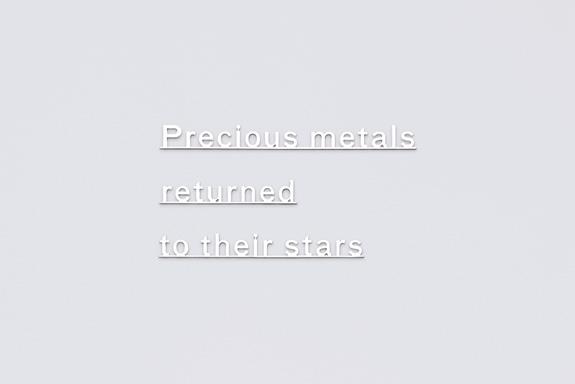
Untitled 2016
C-type print mounted on Dibond 101.6 x 152.4 cm
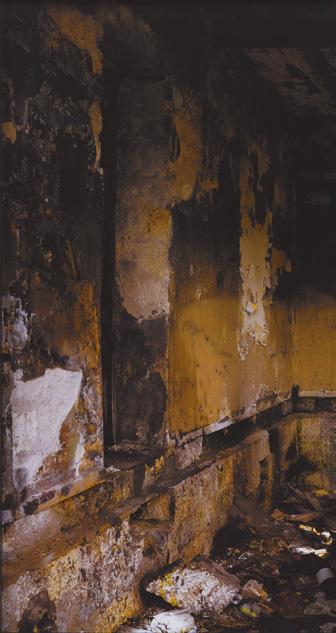
John Akomfrah is a filmmaker and artist known for his deeply moving works which reflect on diaspora, colonialism, migration and identity. He was a founding member of the Black Audio Film Collective in 1982 in collaboration with seven fellow artists and had his directorial debut with the film Handsworth Songs (1986) about the 1985 Handsworth Riots. The collective created work that centred the experiences of diasporic communities living in Britain amongst racial tension and political strife.
Untitled is a photograph inspired by Akomfrah’s dual screen film Auto da Fé (2016), which translates as ‘Act of Faith’. The film follows a series of eight historical migrations over the last 400 years. It begins with the 1654 migration of Sephardic Jews fleeing Catholic Brazil to Barbados and runs to the present day, depicting the religious persecution and migration of populations from Hombori, Mali and Mosul, Iraq. Like the film, the photograph employs costumes and sets to create the aesthetic of a period drama to present historical and contemporary cases of displacement and the continuation of religion as a cause of global migration. The location is kept deliberately anonymous as the story of displacement is not confined to a particular region.
This image has a theatrical quality; the eye is drawn to the still, centred pose of the young woman who stands on a solid concrete beam, surrounded by devastation. Her formal costume evokes the 1950s, but the devastation is timeless and universal. Not seeing her expression creates a sense of ambiguity.
In 2015, the Mead Gallery showed Akomfrah’s film, The Unfinished Conversation (2012) in a solo exhibition. The acquisition of this photograph resonates with this earlier film and continues the exploration of migration in the 20th century and Coventry’s history as a home to migrants.
John Akomfrah (b.1957, Accra, Ghana) lives and works in London. Recent solo exhibitions include Lisson Gallery, London (2021); Seattle Art Museum, Seattle; Secession, Vienna (both 2020); and BALTIC, Gateshead (2019). Recent group shows include Lahore Biennale, Lahore (2020); Museum of Contemporary Art, Chicago (2019); and A4 Arts Foundation, Cape Town (2019).

I Hope I’m Loud When I’m Dead
2018
16mm, SD video, HD video, transferred to HD 21 mins
Edition 3/5
Beatrice Gibson is an artist and filmmaker whose collaborative practice spans many disciplines, including poetry, dance and music. Driven by her own experiences of motherhood, Gibson has increasingly prioritised feminist and queer perspectives in her work. In doing so, the artist provides a transformative vision of community, addressing global concerns that are grounded in the lived experiences of the individual.
I Hope I’m Loud When I’m Dead is a highly personal account of the artist’s world set against the backdrop of Donald Trump’s inauguration ceremony in 2017. The work draws on a rich variety of visual and literary material, exploring an increasingly volatile socio-political climate. The film begins with the artist describing an overwhelming moment of panic, a feeling that intensifies with the introduction of further voices. Gibson’s films often feature her influences and friends. The poets CAConrad and Eileen Myles, for example, feature prominently, with the work’s title taken from CAConrad’s poem of the same name. The fast-moving visuals deliberately disorientate the viewer, just as global events disorientate with waves of fear and anxiety. Interwoven with tender footage of the artist’s own family, however, an alternative narrative of community and strength emerges.
Norwich Castle Museum & Art Gallery is often described as a ‘landscape museum’, containing the world’s finest collection of work by the Norwich School of Artists. Many works in the modern and contemporary collection reflect and expand upon this tradition. Gibson’s work addresses broader political, social and economic landscapes through an
intensely personal lens, one that emphasises the familial spaces that feature so prominently in people’s lives.
Beatrice Gibson (b.1978, London) lives and works in London. Recent solo exhibitions include Camden Arts Centre, London; Bergen Kunsthall; and Mercer Union, Toronto (all 2019). Recent group exhibitions include Ballroom Marfa, Texas (2017); Contemporary Art Center Parc Saint-Leger, Pouguesles-Eaux, Bourgogne, France (2016); and Whitechapel Gallery, London (2014). In 2015 she won the 17th Baloise Art Prize, Art Basel, and more recently was the recipient of the Images Festival Award for Autobiography (2019). Her latest film premiered at Cannes Film Festival 2019.
Purchased with support from the Contemporary Art Society, V&A Purchase Grant Fund, Art Fund and Norfolk Contemporary Art Society, 2019/20


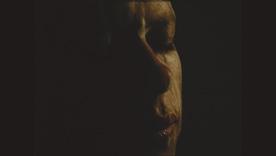


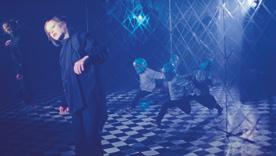
Goshka Macuga
Make Tofu Not War 2018
woven tapestry, acrylic, lurex, cotton, wool 293 x 447 cm
Goshka Macuga works in a wide variety of media including sculpture, drawing, painting, film, photography and textiles. These elements are often incorporated into large installations that may include archival material, museum artefacts and work by other artists. Both artist and activist, spectator and commentator, Macuga’s works often contain bold political statements.

Make Tofu Not War is one such work, a large-scale 3D tapestry that is dynamic, humorous, environmental and politically charged. Make Tofu Not War is centred around a dystopian landscape with three people dressed as animals: a polar bear, a wolf and a reindeer. They are surrounded by discarded signs and placards that appear to be the remnants of an environmental and political protest. The animals appear standoffish, their postures convey a sense of frustration and displeasure at their surroundings and place within their world.
The tapestry is rich in associations and references, with layered narratives from environmental change to debates on personhood. Influences can be drawn from works such as George Orwell’s Animal Farm, to the glorified and not-so-distant past portrayal of hunting, to the futuristic Sci-Fi scene indicated by the spaceship in the background. Inspired by the ability of historical events to become varied narratives, Macuga deconstructs these same narratives in her work to reveal how events can be altered, exploring the relationship between propaganda and art. When viewed with 3D glasses, the viewer can immerse themselves in the work, reflecting upon their own interactions with nature and
the impact that exploiting nature’s resources has and continues to have.
For Nottingham Castle Museum, Goshka Macuga’s Make Tofu Not War will enrich the growing body of work in various media by contemporary women artists and add to the extensive tapestries and collection of paintings. Nottingham Castle Museum has been delving into the archive to unearth and explore histories in references to protest,
democracy and power that are present in Make Tofu Not War, which also make this acquisition fitting for the institution.
Goshka Macuga (b.1967, Warsaw, Poland) lives and works in London. Recent solo shows include The Museum of Modern Art, New York, NY (2019); Kate MacGarry, London (2019); and Kestner Gesellschaft, Hanover, Germany (2019). Recent group shows include Bauhaus Association, Weimar, Germany (2019); Freud

Museum, London (2019); and The Museum of Modern Art, Warsaw, Poland (2018). Make Tofu Not War will be on display at Nottingham Castle Museum in 2021.
Presented with support from the Art Fund, Arts Council England/V&A Purchase Grant Fund and the Contemporary Art Society, 2019/20
Kaye Donachie
Monotonous Remorse
2019
Oil on linen
80 x 56 cm
Kaye Donachie’s modest-size figurative paintings primarily refer to literature, biography and archival imagery, with a strong interest in early 20th-century avant-garde women who contributed to art and culture but remain marginalised figures in history. For the artist these women have a clear sense of identity, represented through their writing and art and as muses.
Donachie’s dreamlike paintings re-imagine modernist female protagonists, transcending their fierce ambition and dreams into the present. The artist does not aim to represent a realistic portrait but rather aims to capture an emotive atmosphere through a considered use of colour, light and figural gesture, merging reality, unconsciousness and fiction.
Monotonous Remorse was made in response to the writings and poems of Iris Tree (1897–1968), an English avant-garde poet, actress and muse to the Bloomsbury group. The soft and hazy profile portrait of Tree, who seems to be gazing in a contemplative daydream, is painted in delicate shades of grey, blue and green, a colour palette that is distinct to Donachie.
Pallant House recently staged Radical
Woman: Jessica Dismorr and her Contemporaries (2019/20), an exhibition telling the story of a group of early 20thcentury female artists in Britain who engaged in progressive art, literature and politics. Pallant House Gallery has a strong collection of Modern British painting and aims to strengthen the presence of female artists who explore notions of identity, modernism, poetry and portraiture. Donachie’s sensual
portrait of an unconventional woman like Iris Tree is a timely addition to the museum’s collection.
Kaye Donachie (b.1970, Glasgow, Scotland) lives and works in London. Recent solo exhibitions include St Carthage Hall, Lismore Castle Arts, County Waterford, Ireland (2020); Yuka Tsuruno Gallery, Tokyo, Japan (2019); and Maureen Paley, London (2018). Recent group exhibitions include FRAC – Ile-de-France – Chateau Rentilly, Bussy-Saint-Georges, France (2019); Noire Gallery, Turin (2018); and Reading International, Reading (2017).
Presented by the Contemporary Art Society with the support of The Friends of Pallant House Gallery, 2019/20

Rina Banerjee
In turmeric Yellow, another world apart from ours, bathed in humans as resources, natural riches seated in natures warm throne, golden and delicious, encrusted in sugary plants and rambunctious animals waited, watched when small factories tired in the business of making money could not make me a mango 2020
Watercolour and ink on paper
76.2 x 55.9 cm
Rina Banerjee is known for her eclectic sculptures, watercolour paintings and delicate drawings that reflect her background, incorporating South Asian and Western cultural and material influences. Her practice often incorporates materials from various traditions. Her works on paper are inspired by ancient Asian art, where colourful patterns and grotesque, monstrous figures intertwine and float in an extraordinarily curious universe. The lines between male and female, human and divine are blurred, rendering strong depictions of our contemporary world through the artist’s eyes.
The work depicts a female figure holding a monkey. Banerjee’s titles are often long and poetic, seeming to come from ancient texts, but the words are the artist’s own. The painting contains a large figure uncomfortably contorted in the scene. Both the figure and the monkey stare out at the viewer, making it apparent that the viewer is intruding upon the scene and disrupting the natural environment.
Inspired by ancient South Asian art, the painting was specially selected as it builds upon the art-historical associations between South Asian art and the museum’s collections. The architectural sculptor and art teacher John Lockwood Kipling (1837–1911) attended art classes in Stoke before moving to India, where he taught at the Sir Jamsetjee Jeejeebhoy School of Art in Mumbai and the Mayo School
of Industrial Arts in Lahore (today Pakistan’s National College of Arts). Kipling also helped to establish the Wonderland Art Pottery, which specialised in traditional South Asian arts and crafts, and a selection of the earthenware vessels made by the pottery were donated to The Potteries Museum by Kipling’s son, the author Rudyard Kipling, in the early 20th century. The work is thus a significant addition to the development of the museum’s fine art collection, strengthening its holdings of artworks by important female South Asian artists.
Rina Banerjee (b.1963, Calcutta). Lives and works in New York City. Recent solo exhibitions include Frist Art Museum, Nashville, Tennessee (2020); San José Museum of Art, California (both 2019); and Musée des Beaux-Arts de Rouen, France. Recent group exhibitions include Galerie Nathalie Obadia, Brussels (2020); Fondation Villa Datris, l’Isle sur la Sorgue (2019); Dr. Bhau Daji Lad Museum, Mumbai (2018).
Presented by the Contemporary Art Society, 2020/21

Jeff Keen
Pome Discs
c.1965
Wood with pencil, paint and stencilled letters
52 x 52 cm each
Opposite
Acme Generating Co
c.1968
Collage with photographs
41 x 29 cm
Jeff Keen was an artist and experimental filmmaker who lived and worked in Brighton from the 1950s until his death in 2012. An important contributor to Britain’s 1960s countercultural scene, Keen staged numerous expanded cinema and poetry performances, most famously at the legendary Better Books on Charing Cross Road, London. He was also co-founder of the London Film-makers’ Co-op and founded the Film Society at Brighton Art College.
Jeff Keen featured his friends and family in his films, performances, artworks and poetry. Acme Generating Co is a series of Polaroid photographs showing these stars in his mythical universe. Posing are Keen, his wife Jackie, filmmaker Tony Sinden and the Australian performance artist and poet Jas H. Duke. The polaroid bottom right shows the exhibition ‘Flux and Flix’ in a shop on Trafalgar Street, Brighton that Keen had rented for a ‘pop-up’ exhibition and performance.
‘Acme Generating Co’ was the name Keen and Jas H. Duke gave to the group’s expanded cinema events that often took place at the Arts Lab ‘Brighton Combination’ on West Street. Reflecting his love of American cinema, Keen’s collage humorously promotes his early underground expanded cinema productions. According to Keen’s daughter Stella Keen, Keen intended the collage to be part of
a memorabilia book for his famous expanded cinema film RaydayFilm (1968–76).
Keen’s Pome disks were used as props in various performances and films from the late 1960s onwards, including RaydayFilm. Decorated with cartoon drawings and stencilled letters, they combine Keen’s passion for poetry, graffiti and movement. They were typically put into motion via record players or spun manually by performers.
The first retrospective exhibition of Keen’s multimedia practice – ‘Shoot the Wrx, Artist and Film-maker Jeff Keen’ – was held at Brighton Museum & Art Gallery in 2012. These new Jeff Keen acquisitions form an important contribution to the museum’s collection of artists’ moving-image works from the 1960s and 1970s. CAS purchased Keen’s collage for the museum in 2013. With these new acquisitions the museum will be able to contextualise Keen’s films and communicate the radically experimental and multimedia nature of his practice. The disks, in particular, reflect a direct link to the 19th-century optical toys in the museum’s historical film collection and help establish a line of continuity between the early days of moving image and the 1960s revival of film as an experimental artistic medium.
Jeff Keen (b.1923 Trowbridge, Wiltshire, UK, d.2012 Brighton, UK). Keen’s films featured in seminal historical film festivals and exhibitions such as the ‘International Underground Film Festival’ at the National Film Theatre, London (1970) and ‘Perspectives on Avant-Garde Film’, Hayward Gallery, London (1977). Recent solo shows include Kate MacGarry, London (2016); Hales Gallery, London (2013); and Tate Modern (2012). His work is in the collections of BFI, Tate and The Royal Pavilion & Museums Trust.
Presented by the Contemporary Art Society, 2020/21
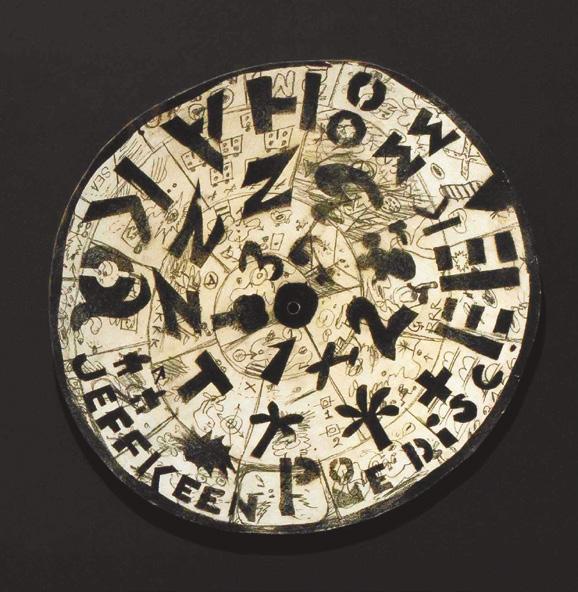
Untitled 2020
Oil on board
40.5 x 30.5 cm
Gillian Wearing is a conceptual artist and is part of the generation of artists known as the YBAs. Her films and photographs explore the expression of identity in public and personal spaces, often featuring her family members. Wearing is known for her documentary method of film and photographic portraits which capture everyday life. She is concerned with portraying identity within the private and the public spaces we inhabit, blurring the line between reality and fiction. Although Wearing’s portraits initially appear to conform to traditional methods of documentation, she highlights how the camera is not objective towards its subjects and invites the subject to include their own thoughts in the picture, often through text. This makes the interaction between artist, subject and viewer more conversational than the typical methods of portraiture.
During the first lockdown, Wearing created a series of self-portraits, some in watercolour and a few in oil paint, that documented her state of mind during isolation. This resulted in an exhibition entitled Gillian Wearing. The themes explored within the artworks echo her familiar interests in masks and identities, but in a radical and new way. The watercolours and oils, as opposed to film, convey a different side to Wearing, one that is inherently vulnerable and makes the viewer think of isolation and loss. The painting Untitled belongs to this body of work. Wearing is depicted gazing into the distance looking forlorn, an expression so powerful that the presence is undeniable.
The impact of the pandemic on the arts has been widely documented with visual artists
having projects, exhibitions and displays cancelled and this series captures the anxiety faced across the arts and heritage sector because of the uncertainty around recovery and what the future will hold post pandemic.
Portraiture is well represented at Rugby Art Gallery and Museum. This acquisition will join figurative work by Claudette Johnson and Lubaina Himid, facilitating discussions around social and cultural identity. Furthermore, Untitled from the lockdown series will ignite conversations around representations of mental health and wellbeing.
Gillian Wearing CBE RA (b.1963, Birmingham, UK) lives and works in London. Recent solo exhibitions include Guggenheim Museum, New York (2021); Maureen Paley, London (2020); and Moody Center for The Arts, Houston, Texas (2019). Recent group exhibitions include Museum of Contemporary Art Chicago (2020); Tanya Bonakdar Gallery, New York (2020); and Royal Academy of the Arts, London (2020). In 1997, Gillian Wearing won the Turner Prize and in 2018 she was commissioned to make a statue of suffragist Millicent Fawcett that has been erected in Parliament Square, London.
Presented by the Contemporary Art Society with support from the V&A Purchase Grant Fund, Rugby Museum & Art Gallery and the Zabludowicz Collection, 2020/21

Rosalind Nashashibi
South of France
2018
Oil and nylon tights on canvas
110 x 90 x 2 cm
Rosalind Nashashibi has worked in various media including film and photographic installations, as well as painting. In her work, daily life intersects with fantasy and the mythological and often exposes the tension between public and private spaces. Like her films, her paintings encompass both impressions and more figurative depictions, creating collages of everyday life.
Beginning in 2014, her painting started to engage with place through organic forms rendered in vivid colours. South of France continues in this style, yet incorporates the everyday through the nylon tights draped over the canvas. The tights hang between oval forms, suggesting a liminality between the mundane and the idyllic. The landscape refers to the light, colours and atmosphere of the south of France, a place the artist links with Matisse, Bonnard and Monet. Nashashibi describes the title as being an ‘offhand and vague reference’, as it is a subjective take rather than a direct reference.
The leaves Nashashibi depicts are pink and purple like the colour of fruits or flowers, rendering an uncanny space referring to the imperfect nature of memory. The mass-produced nylons hanging over the scene represent legs in the sun. The nylons mimic a figure rather than creating a figurative depiction, producing a closeness to the feeling of a body and the notion of retreat, paradise and painting.
Southampton City Gallery holds an impressive collection of work, particularly 20th-century and contemporary painting. The Post-Impressionist holdings in particular
complement Rosalind Nashashibi’s contemporary take on the subject matter of French Post-Impressionist painting. Her work contributes to the strength of the collection and highlights its remarkable expansion over the last 80 years.
Rosalind Nashashibi (b.Croydon, 1973) lives and works in London. She has had solo exhibitions at National Gallery, London (2020), GRIMM, New York; S.M.A.K., Ghent; and The High Line, New York (all 2019). Recent group shows include Royal Academy of Arts, London (2020); Centre Pompidou and Forum des Images, Paris (2019); Tate Britain (2017); and Documenta14, Kassel (2017). She was shortlisted for the Turner Prize in 2017 and was Artist in Residence at the National Gallery, London in 2020.
Presented by the Contemporary Art Society, 2019/20

Vinyl wall text, on the gable end of South London Gallery’s Fire Station Annexe
110 x 283 cm
Lawrence Weiner’s work takes the form of typographic texts. Although Weiner is one of the central figures in the formation of conceptual art in the 1960s, he does not consider himself to be a conceptual artist but a sculptor whose medium is language and the materials referred to. Weiner’s practice focuses on the interaction between artwork and viewer. He challenges the notion that an artwork has to consist of a physical object, suggesting that it could be a concept or an idea which the viewer would be invited to engage with. Weiner’s statements have taken the form of texts in gallery or public spaces, spoken dialogue in audio and moving image, books and posters, lyrics and tattoos. Throughout his career of more than 50 years, Weiner has had major exhibitions and works acquired in important museums and galleries all over the world.
is a large scale vinyl that is indicative of Weiner’s previous works. The work will be the artist’s first permanent work in London. The installation on the Fire Station follows that of another work by Weiner, ALL IN DUE COURSE, that was temporarily shown on the façade in 2014 as part of his solo show of the same name at the South London Gallery (SLG). SLG has an international reputation for its contemporary art exhibitions by established, mid-career and younger artists and its programme of film and performance events. In other words, the context in which they are seen by the public creates the impact on the process of interpretation. It thus invites the viewer to be a collaborator in the work process. Although the idea of acquiring the work for the SLG came about before
lockdown and social distancing had even been considered in the UK, the work shows the power of contemporary art to convey the meaning and experiences of the present.
Lawrence Weiner (b.1942, New York) lives and works in New York and Amsterdam. Recent solo exhibitions include Museo Nivola, Orani, Sardinia (2019); Pérez Art Museum, Miami; and Milwaukee Art Museum (both 2017). Recent installation projects include a banner installed on the facade of the Jewish Museum, New York (2021) and a permanent installation at Kistefos Museum, Jevnaker, Norway (2020). He has participated in various biennales and Documenta exhibitions.
Acquired for the South London Gallery’s permanent art collection with generous funding from Art Fund, Contemporary Art Society, Candida & Zak Gertler, Marian Goodman Gallery, Alex Hank, Neil Wenman & Jane Carr, and the Henry Moore Foundation, 2020/21

Chantal Joffe
Bella in a Vest 2016
Oil on board
90 x 60 x 1.8 cm
Chantal Joffe creates disarmingly raw portraits, almost always depicting women and girls, often working from candid photographs. Appropriation of existing imagery is key to her work where she transforms photographic images into complex and engaging paintings. Her most recent work explores issues of female identity. Her paintings are alluring and revealing, laying bare distortions, quirks and imperfections with her loose, fluid brushstrokes. Her gestural style presents her subjects in positions that vary from relaxed to awkward, their comfort with the artist seemingly met by the discomfort of being observed and recorded.
Joffe’s subjects are often her family and friends, and the intimacy of these relationships is present alongside the raw honesty of her work. This is particularly visible in her depictions of girlhood, which is a recurring motif. She has painted her own daughter throughout her life. The large-scale portrait Bella in a Vest depicts a friend’s daughter sitting in a vest on a chair against a neutral backdrop. It combines the genres of childhood portrait and casual family snapshot. The palette used and the stylised blue stripes pay homage to the artist Alice Neel. Bella sits with her hands clasped in her lap, her cool gaze avoids meeting the viewer directly, appearing both self-possessed and insecure. The juxtaposition of these attitudes captures the contradictions of adolescence and girlhood. Joffe often discusses her paintings in terms of transformation, exploring ageing and growing. In her work, she chronicles both the physicality and psychology of these changes.
Chantal Joffe is an artist whose practice bears a relationship with the existing works within Sunderland Museum’s collection, particularly those of artists deploying painterly images for emotional effect, such as L.S. Lowry, and those looking at transitions and identity, such as Jeffrey Sarmiento or Bruce McCann. The addition of this work to Sunderland Museum’s collection expands the representation of female artists.
Chantal Joffe (b.1969, Saint Albans City, Vermont) lives and works in London. Recent solo shows include Victoria Miro, London (2020); Arnolfini, Bristol (2020); and The Lowry, Salford (2018). Group shows include Royal Academy of Arts, London (2020); The Foundling Museum, London (2020); Scottish National Gallery of Modern Art, Edinburgh; and The Drawing Room, London (both 2019).
Presented by the Contemporary Art Society, the Arts Council England/V&A Purchase Grant Fund and the friends of Sunderland Museum, 2019/20

Cipher
2007
Photograph, C-print on paper, face-mounted to glass
1440 x 1740 mm
Edition of 5 plus 1 artist’s proof plus 1 trial print
Anne Hardy is a multidisciplinary artist working with sculpture, photography, sound and room installations. Her installations are incredibly immersive, her ability to transform objects and the space they inhabit so meticulous that they almost imitate a parallel reality. Hardy is inspired by life; it is by wandering urban landscapes and exploring spaces in the city that Hardy gets her influences for her installations. By incorporating found objects into her work, Hardy is guided by the materials and the physical spaces which she encounters. The work is intended to exist outside of time, or in alternate reality. Created over a period of months, the room installations are constructed with the frame of a photographic lens in mind. After the images are captured, the room then ceases to exist in the physical sense but is left to the imagination of the viewer, created by the image alone.
The print entitled Cipher is emblematic of Hardy’s ambitious room-sized installations. Cipher is meticulously composed, proactively evoking feelings of nostalgia to claustrophobia with an undertone of eerie whimsicality. The muted brown plastered walls are marred and textured, making the space appear weathered and aged. Combined with the illumination from the artificial light against the walls and the feathers on the floor, the print almost looks like a painting. In contrast to this sense of abandonment, the heavy lifting equipment and the numbers on the wall allude to evidence of human intervention. Like many of Hardy’s works, much is left to the imagination of the viewer regarding the interpretation of space and time.
Hardy has built a strong relationship with Tate. In 2019 she was commissioned to undertake the 2019 Winter Commission on the exterior of Tate Britain and between 30 November 2019 and 26 January 2020, The Depth of Darkness, the Return of the Light was installed on the Gallery’s façade. This acquisition facilitates Tate in their endeavour to build stronger representation of Hardy within the national collection and enable their audiences to understand the artist’s contemporary practice in full.
Anne Hardy (b.1970, London) lives and works in London. Recent solo shows include Tate Britain Winter Commission (2019); Arts Council Collection at Towner Art Gallery, Eastbourne (2019); Maureen Paley, London; and Museum Boijmans van Beuningen, Rotterdam (all 2018). Recent group shows include Rugby Art Gallery, Rugby; and Royal Academy of Arts, London (both 2020). In 2021 she is Artist in Residence at The Chinati Foundation, Marfa, Texas. Her work will also be included in British Art Show 9.
Purchased by Tate with support from the Contemporary Art Society, 2020/21

Rachel Jones
Lick your teeth, they so clutch
2021
Oil pastel and oil stick on canvas
18 x 50 cm
Rachel Jones creates works on paper, sculpture and paintings. Through her bold and intense paintings, Jones explores ways of finding a visual language through which to convey abstract concepts. Using shape, form and composition, she creates a tension in her work that is enhanced by her balance of rich colours, from warm, fiery reds to cool blues and greens. She creates texture through her layered use of oil paint and oil sticks, applied to imperfect, raw-edged canvases, producing works that almost resemble landscapes.
Lick your teeth, they so clutch stems from this wider body of work investigating identity and representation of self. Through this seemingly abstract and visceral painting, Jones is inviting the viewer to see something of her own presence and lived experiences. Jones is interested in creating images that explore the Black Interior, the depth of her own interiority and how, as a Black woman, it consists of an autonomous, imaginary and multifaceted experience. Jones has questioned how the Black body has been read and depicted through the history of art, researching the representation of Black figures in the arts from the 18th century and in contemporary society, and addressing it by pulling these explorations into her own work. Recently she has been using abstract forms of mouths and teeth to suggest a literal entry point to the interior and the self.
Jones’s work joins the Towner’s permanent collection with its strength in modern British and contemporary works. The curators are also keen to investigate and address a historic lack of diversity and under-representation of women in the public collections, through a long-standing mission of acquiring and
exhibiting young and emerging artists. Jones’s work adds another dimension to the varied collection of work by dynamic emerging artists.
Rachel Jones (b.1991) lives and works in London. Recent exhibitions include The Chinati Foundation, Marfa, Texas (2019). Recent group exhibitions include Galerie Thaddeus Ropac, London (2020); New Art Centre, Salisbury; and the Royal Academy of Arts, London (both 2019). Jones was awarded the André Dunoyer de Segonzac Hon RA Prize in 2019 and the Machin Foundation Painting Prize in 2018.
Presented by the Contemporary Art Society, 2020/21


Barbara Walker
All the King’s Men
2018
Graphite on embossed paper
63.1 x 46.4 cm
Opposite, top left
Parade I
2018
Graphite on embossed paper
50.1 x 56.8 cm
Opposite, top right
Backdrop
2018
Graphite on embossed paper
58.0 x 38.0 cm
Opposite, bottom
Barbara Walker is a figurative artist whose practice focuses on drawing. She makes work that scales from small embossed works on paper to large charcoal wall drawings. Issues of visibility and representation are central to Walker’s practice. She views the archive as a space of power that is used to privilege white western histories and subjects over Black people and culture. Within this unbalanced system, art plays the mediator, supporting or challenging established narratives through acts of representation. As such, her drawings often reference public archives to create works that seek to transfer visibility to Black subjects; ranging in subject matter from the ‘stop and search’ police tactic, European paintings in the National Gallery and the First World War. Through a process of erasing white subjects, and bringing Black men and women to the fore, Walker revisits and reveals the prejudices inherent in how western histories are told by those with power.
The three drawings acquired for the Whitworth are part of an ongoing series called ‘Shock and Awe’ (2015–present). In
these works, white soldiers are rendered almost invisible through embossing whilst Black soldiers are brought to the surface with graphite marks. Through this inversion, these portraits reclaim an equal and independent position of the former ‘other’, establishing their own narratives rather than those told by their former oppressors.
The narrative of national heritage presented through public collections is informed and shaped by museum acquisitions. Within the Whitworth’s collection, Barbara Walker’s striking drawings will be used as a tool for disrupting the traditional narrative of British history.
Barbara Walker (b.1964, Birmingham) lives and works in Birmingham. Recent solo exhibitions include Turner Contemporary, Margate (2019/21); Jerwood Gallery, Hastings (2018); and MAC, Birmingham (2016). In 2024 Walker will have a solo exhibition at the Whitworth Art Gallery, Manchester. Group exhibitions include Lahore Biennale, Pakistan (2020); Southbank Centre, London (2020); SCAD Museum of Art, Savannah, Georgia (2019); and Firstsite, Colchester (2019). Forthcoming group exhibitions include Tate Britain (2021); Sunderland Winter Gardens (2022); and the National Portrait Gallery, London (2024).
Presented by the Contemporary Art Society with support of The Friends of The Whitworth Art Gallery, 2019/20

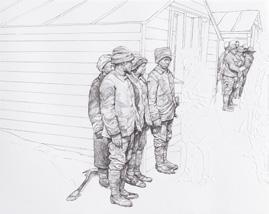
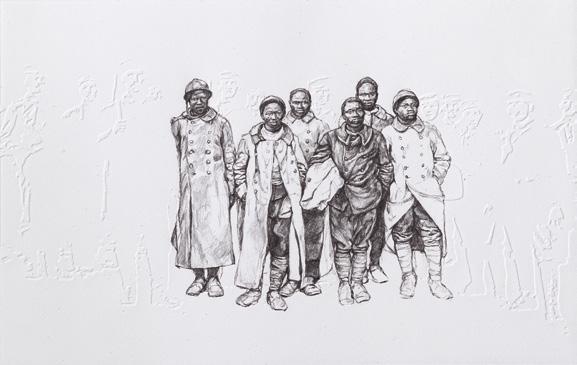
Jade Montserrat
Her body with no father in sight
2017
Ink on paper
39 x 30 cm
She saw no need for clothing other than comfort
2017
Watercolour on paper
32 x 26 cm
Her inscription read Brown Sugar
2017
Watercolour on paper
32 x 24 cm
Opposite, top
Picking teasing brittle curls
2017
Watercolour on paper
32 x 24cm
Opposite, bottom left
Fanny Ann, Exhibit A
2015
Watercolour, pencil and gouache on paper
36 x 26 cm
Fanny Ann, St Hilda’s
2015
Watercolour, pencil and gouache on paper
36 x 26 cm
Fanny Ann, Freemasons
2015
Watercolour, pencil and gouache on paper
36 x 26 cm
Overleaf, page 140
Shadowing/Revue: Ecclesiastes I
2017
Watercolour, Indian ink, gouache, pencil and pen on paper
48 x 36.5 cm
Shadowing/Revue: Ecclesiastes II
2017
Watercolour, Indian ink, gouache, pencil and pen on paper 48 x 36.5 cm
Jade Montserrat’s practice is research-led, excavating shared histories alongside delving into her own personal narrative. She works across artistic media: in painting, drawing, film, performance, installation, sculpture, text and print. Much of her work focuses on the entertainer and civil rights activist Josephine Baker (1906–75), whose story represents the intersection of gender, race, class and celebrity culture that fascinates Montserrat.
In the 1920s, Baker performed at the Folies Bergère, became the first Black woman to star in a feature film and later joined the French Resistance. In later life, she became a figure in the American civil rights movement. Baker’s extraordinary life is the basis for Montserrat’s ‘Rainbow Tribe’ series. It references a period in Baker’s later life when she adopted twelve children of different ethnicities and religions as the embodiment of her vision of a world without racism. Taking this fairytale-like idea as inspiration, Montserrat explores contemporary issues of diversity, belonging and movement, examining our globalised world through the lens of Baker’s flawed experiment.
Of the nine works acquired for York, three are depictions of the artist’s own torso emblazoned with symbols and patterns, while four are text pieces that make direct reference to the body. Both of these sets relate to Montserrat’s experience of growing up in North Yorkshire. The other two works share synergies between both of the former groups, showing crouching bodies embellished with intricate script.
Montserrat’s work is strongly aligned with the permanent collections at York Art Gallery, particularly in relation to the collecting strategy initiated in 2012 that takes inspiration from York-born Georgian artist William Etty, a lifelong advocate of the nude. Major works such as Quadrille (1974) by Rose English and
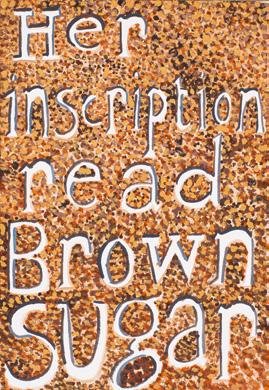
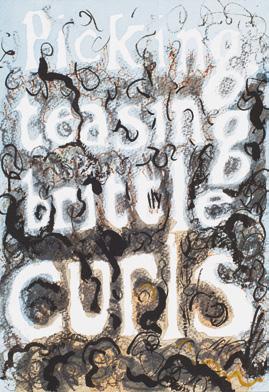
Ego Geometria Sum IV: Boat, age 2 years (1983) by Helen Chadwick have been acquired as part of this initiative, which aims to build a contemporary art collection that deals with issues surrounding the human body. Fittingly, Jade Montserrat’s works on paper have now joined this growing collection of self-portraits by remarkable women artists.
Jade Montserrat (b. 1981, Scarborough, UK) lives and works in Scarborough, North Yorkshire. Recent solo exhibitions include Iniva, London; Manchester Art Gallery as the

first Future Collect artist (both 2020); Humber Street Gallery; and Bluecoat, Liverpool (both 2019). Group shows include Lisson Gallery (2021); and ICA, Philadelphia (2018). She was the Stuart Hall Foundation practice-based PhD candidate at The Institute for Black Atlantic Research, University of Central Lancashire (2017–20). Residencies include Hospitalfield (2020–21) and awards include Henry Moore Foundation (2020) and Jerwood Drawing Prize: Student Award (2017).
Presented by the Contemporary Art Society, 2019/20
‘I am unafraid to share the beauty of meaning I have experienced in this life. Thank you, Mother Earth, for allowing me honoured freedom of access into the unsoiled winner’s dialogue of your pure heart. I am honoured to see a British Institutional collaboration by which my contribution is supported as a worthy historical record. My words are represented accurately as I have spoken them.’
Lawson Oyekan, artist
Antler Helmet
2020 Ceramics
17. 5 x 22 x 13.5 cm
Rasmussen
Malene Hartmann Rasmussen’s ceramic creations invite the spectator to step into a surreal world where dark undercurrents abound and things are never quite as they seem. Working in her distinctive style, Rasmussen conjures characters that often evoke what seems to be a far-off world of folklore, myth and legend, yet each incarnation is in fact much closer to home – a study in ceramic designed to exorcise personal feelings of misery, anger and grief. In her own words, Rasmussen explains, ‘I want my work to look like a very skilled child could have made it, clumsy and elaborate at the same time. Initially the viewer may, mistakenly, be drawn to my figures thinking them to be toys; however closer examination reveals their rather darker narrative.’
Antler Helmet was first shown in 2019 as part of the installation Fantasma, which Rasmussen describes as a kind of temple in which she could explore feelings around the loss of her own father and mother. Antler Helmet is an animal/human hybrid, the antlers resembling those that could have been used in shamanic seances. The helmet shape instantly resonates as an excavated Viking relic. Both elements come together as a visual mnemonic of the journey from life to the afterlife. It comes as little surprise to learn that Rasmussen’s early childhood visits to the National Museum in Denmark inspired Antler Helmet. There she was introduced to Bronze Age horned helmets, replete with zoomorphic design elements – surviving relics from an era where burial rituals were wholly affected by the desire to achieve a successful afterlife. Antler Helmet is an exciting addition to Aberdeen Archive, Gallery & Museum’s collection. Because of the meaning behind the piece, Antler Helmet
is also a route into discussing loss, grief and memory – themes of unparalleled collective relevance for so many in society today.
Malene Hartmann Rasmussen (b. 1973, Hillerød, Denmark) lives and works in London. Recent solo exhibitions include Messums, London (2019); Aspex Gallery, Portsmouth (2016); and Jessica Carlisle, London (2014). Recent group exhibitions include Messums, Wiltshire, UK (2020); Simone DeSousa Gallery, Detroit (2020); and the Vehbi Koç Foundation, Mesher, Istanbul (2019). In 2015 Rasmussen won the Jerwood Makers Open. In 2018 she was awarded resident artist at the Victoria & Albert Museum, London. In 2020 she was awarded resident artist in Detroit through the Danish Arts Council’s USA programme.
Presented by the Contemporary Art Society through the Omega Fund, 2020/21
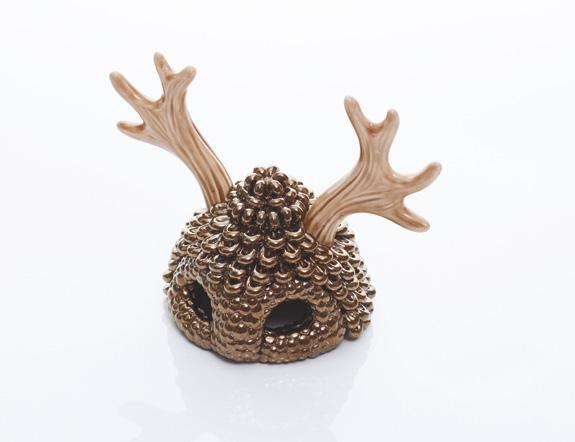
Lisa Krigel
Seven Stacks 1a – 7a 2018
Glazed ceramic stoneware
60 x 69.8 x 54.9 cm
Lisa Krigel’s functional ceramic sculptures are inspired by the designs and utopian ideology of modern and brutalist concrete architecture. Krigel is fascinated by the parallels and dichotomy between hand-crafted ceramic techniques and industrial construction methods, between clay and concrete, as well as between the domestic and the monumental.
Seven Stacks comprises individual stacked pieces in combinations of four to eight elements: mugs and cups, plates and bowls, spoons and containers. All hand-thrown and precisely finished, these have been made using a stoneware clay blended with oxides to achieve the colour and texture of concrete, an effect that is the result of extensive experimentation. Each ‘tower’ alludes to the industrial, engineering and architectural uses of ceramics, blending sculptural qualities with functionality. While the ostensible purpose of the towers of vessels is to store, share and serve specific foods, they also actively encourage the user to engage in a ritual of construction and deconstruction.
Krigel’s work finds an ideal home in a strongly interdisciplinary collection like that at Amgueddfa Cymru, where ceramics and photography, art and industry, architecture and social ritual are some of the many cross-cutting themes. Krigel is inspired by the architecture of Berlin and by the aesthetic of the industrial structures photographed by Bernd and Hilla Becher. The influential German photographers are known above all for their typologies, grouped images documenting European and American industrial structures. For this reason, Krigel’s sculptures make an ideal partner to their
work, and they were shown in parallel with Amgueddfa Cymru’s exhibition Bernd and Hilla Becher: Industrial Visions (2019-2020)
Lisa Krigel (b.1961, Pittsburgh, USA) lives and works in Cardiff. Recent solo exhibitions include Mission Gallery, Swansea (2019); Llantarnam Grange Arts Centre, Cwmbran (2018); and the Museum of Modern Art, Machynlleth (2017). Recent group exhibitions include New Brewery Arts, Cirencester (2020); Oita Prefectural Museum, Japan (2019); and the Royal Cambrian Academy of Art, Conwy (2018). In 2016 she won the Gold Medal for Craft and Design at the National Eisteddfod of Wales, Abergavenny.
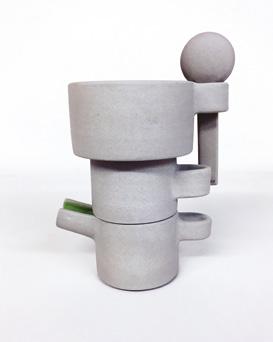

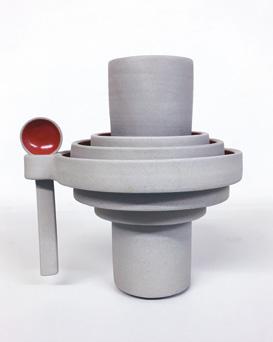

Morel Doucet
Black Death – Crown of Thorns
2019
Porcelain ceramic with cast altered forms and hand built elements

36.8 x 15.2 x 16.5 cm
Haitian artist Morel Doucet is based in Miami, Florida. His local environment informs his practice, where he investigates and critiques the realities of climate-gentrification, migration and displacement among the Black diaspora communities. Doucet conveys these realities as a multidisciplinary artist working with ceramics, print and illustration. Black Death – Crown of Thorns comprises two Rococo porcelain coffee pots from the series ‘White Noise: When Raindrop Whispers & Moonlight Screams in Silence’. The porcelain itself is fragile, a metaphor for the vulnerability of the African American and Caribbean communities that are most affected, yet often have no input into the conversations around environmental activism.
As with the other works in this series, Doucet imitates the textures of local flora and fauna. Each vessel appears to be a representation of an interaction, emotion or state that gives way to larger debates around identity, meaning and value. Black Death – Crown of Thorns is engulfed in ecological and socio-economic meanings, from climate change to rising sea levels and the impact of development upon the African diaspora in Miami. Coral, sea sponges and shells symbolise the local biodiversity in Miami that is at risk of ecological erosion and may cease to exist in the near future. In his work, Doucet challenges racial inequalities and hierarchies of power by questioning the dominant voice and face of environmental activism.
The Box acquired work by Morel Doucet because of the many connections between his practice and the location of Plymouth, a port city, and the museum’s collection. Much of the
collection has a maritime theme and there is a large collection of porcelain shell wares. The Box wishes to explore the long history of porcelain manufacture, the narratives of migration and identity internationally as there is a large collection of domestic works from the Plymouth Porcelain Factory made in the 18th century.
Morel Doucet (b.1990, Haiti) lives and works in Miami, Florida. Recent solo shows include African Heritage Cultural Centre, Miami (2019); and Pinkard Gallery, Baltimore (2013).
Recent group shows include The Bass Museum of Art, Miami (2020), Patricia & Phillip Frost Art Museum, Miami (2020); and Haitian Heritage Museum, Miami (2019).
Presented by the Contemporary Art Society through the Omega Fund, 2021

Renee So
Janus Vessel Man
2019 stoneware
45 x 25 x 25 cm
Hong Kong-born and Australia-raised Renee So’s ceramics and textiles draw upon different sources, ranging from 17th-century ceramics such as Bellarmine (Bartmann) beer jugs to ancient vessels from Assyria, Egypt and Colombia and modernist textiles designed by the Bauhaus. Her trans-historical and global points of reference and her playful merging of ancient and modern forms is a contemporary take on the interest of 20th-century artists in ancient material culture.
Janus Vessel Man is a stoneware vessel which takes the form of a two-sided, threefooted figure. Created using hand building techniques, it is inspired by Janus heads, Bellarmine jugs, Chinese Neolithic tripod pots and the historical representation of bearded men. Janus was the Roman god of transitions, portrayed with two faces – one facing the past and one facing the future.
‘The intention of this work was to make a 2 in 1 figure, something which could be viewed from front or back. I worked without a sketch, making it up as I went along...so it is freer and slightly different in spirit to the other Bellarmine vessel men, which are based on drawings.’
In Janus Vessel Man, the trajectory of material culture is also implied: Bellarmines for example were exported globally, often as tourist souvenirs, and were first brought to Britain in 1500. Discovered all over the world in sites of archaeological interest, they now tell a particular history of European travel, trade and colonial passage. So’s work will sit alongside global-inspired Modernist art in Bristol Museum & Art Gallery’s collection
while reflecting on it and looking forward. This includes work by Henri Gaudier-Brzeska, Jacob Epstein and the abstract artist Aubrey Williams, who incorporated motifs from Mayan art and Warau tribal art from his native Guyana into his painting. Equally, So’s work connects with aspects of BMAG’s collections beyond art, including applied art, British archaeology, Egyptology and world cultures, and blurs the boundaries between them.
Renee So (b.1974, Hong Kong) lives and works in London. Recent solo exhibitions include De La Warr Pavilion, Sussex; Henry Moore Institute, Leeds (both 2019); and Kate MacGarry (2016). Group shows include Goldsmiths CCA, London (2020); Whitechapel Gallery, London (2018); Leeds Art Gallery; and Nottingham Castle Museum (both 2016). So has a forthcoming solo presentation at Frieze London with Kate MacGarry in October 2021.
Presented by the Contemporary Art Society through the Omega Fund with the support of the Friends of Bristol Museum & Art Gallery, 2020/21

The Burden I 2021
Vegetable tanned leather
79 x 38 x 45 cm
Esna Su is a textiles artist and former jewellery designer. She explores the complex issues of how identity and memory are irrevocably changed during political instability. Su’s work is deeply personal, connected both to her own family history and its geographic location in the south of Turkey near the Syrian border. She uses traditional Turkish weaving techniques such as crochet, twining and needlework, using vegetable tanned leather to create artworks that are both sculptures and wearable pieces.
The Burden by Esna Su is based on the struggle of Syrian refugees who have been forced to abandon their homes and flee conflict. Of the 3.6 million Syrian refugees in Turkey, many ended up in Su’s hometown of Antioch. Observing them, she reflected on how their lives had become isolated from their homes yet filled with the hope of returning. Vegetable tanned leather is the chosen material as it closely resembles skin, establishing a connection to the body. Su moulds the knitted leather cords around a collection of cherished objects to create the unique shape of each piece. The indentations serve as a reminder of a life left behind, an invisible yet burdensome reminder of their past.
Migration is a very important theme that Bradford Museums and Galleries addresses through its collections and displays. Bradford has a long history of migration, with diverse communities having travelled there from all over the world. It is important that the collection reflects this diversity through the contemporary works collected. Esna Su’s piece will work well alongside those currently on
display by Salima Hashmi, Yinka Shonibare and Sylvat Aziz, creating dialogue and further stories. The aim is for visitors to reflect on the difficulties that some of their neighbours have had to endure in order to call Bradford their home. This piece is particularly personal, offering a chance for the visitors to relate and become emotionally invested in it. To facilitate this, The Burden will be used in outreach and engagement workshops.
Esna Su (b.1977, Antioch, Turkey) Recent solo shows include Amman Design Week, Jordan (2019); SARABANDE Foundation, London (2017); and Lethaby Gallery, London (2017). Su’s work has been presented at the Cheongju Biennale, South Korea; Shanghai Fashion Weekend, China; and Schmuck Jewelry Week, Munich, Germany (all in 2017).
Presented by the Contemporary Art Society through the Omega Fund 2020/21
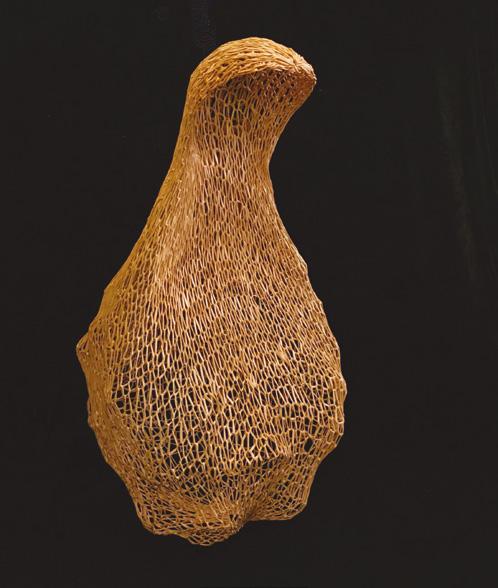
Suzanne Berry
Rannoch Chestnut Spoon
2020
Cast sterling silver
14 x 4.5 cm
Rannoch Stem Spoon
2018
Cast bronze, silver plated
21.5 x 4.6 cm
Opposite, bottom left
Hope Spoon
2018
Cast bronze, silver plated
21 x 5.5 cm
Opposite, bottom right
Flow Caddy Spoon
2018
Hand engraved, sterling silver
16.5 x 4.5 x 2.0 cm
Opposite, top left
Silver Birch Beaker
2018
Hand engraved, chased, britannia silver
9.0 x 7.7 cm
Opposite, top right
Inspired by the Scottish woodlands of her childhood and the open skies of the Peak District where she often roams, Suzanne Berry’s work explores the balance between nature and humankind. Through the process of walking and foraging she reveals a sense of place and explores her evolving relationship with the landscape. Each resultant piece is both a reflection of self and a literal memory of a place and her time spent there.
Suzanne Berry’s practice involves gathering natural ephemera such as seed pods, twigs and tree bark to create a rich collection of source material. These tactile items are
subsequently manipulated with wax and transformed into intriguing silver and bronze objects, which are both functional and sculptural.
Berry was inspired to create a collection of spoons after moving to Sheffield in 2017. The Hope Spoon was made from an oak tree twig found whilst walking in Hope Valley, Derbyshire. This spoon is textured with a surface pattern, its form suggesting the spoon’s bowl may have grown from the twig itself. The Rannoch Chestnut Spoon was created from a chestnut shell and tree bark which Berry found whilst walking in woodland close to her family home in Scotland. The sculptural quality of the chestnut shell and bark creates an object which is at once playful, beautiful and intriguing.
This grouping of Berry’s work will extend Sheffield’s designated Metalwork collection, complementing historic examples by makers such as Ramsden & Carr whilst reflecting contemporary practice in the city. Berry’s work also has synergies with the Ruskin Collection cared for by Museums Sheffield, which was originally created to inspire the workers of Sheffield and encourage people to engage with the natural world.
Suzanne Berry (b.1985, Johnstone, UK) lives and works in Sheffield. Recent exhibitions include Millennium Gallery, Sheffield; Sheffield Assay Office (both 2019); and Manchester Craft and Design Centre (2018). Berry recently completed a two-year residency at Yorkshire Artspace, Persistence Works in Sheffield.



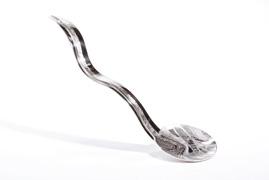
Malene Hartmann Rasmussen
My Inner Beasts #3
2017 Ceramic (earthenware)
23 x 24 x 22 cm
Malene Hartmann Rasmussen creates fantastical ceramic sculptures drawing on her childhood memories of growing up in Denmark, along with Norse mythology and fairy tales, the natural world and cinematic influences. With an eerie and dreamlike quality, Rasmussen’s work is both familiar and yet quite removed from our everyday world. Whether displayed individually, or part of fantastical tableaux, her figures aim to elicit an emotional response in the viewer which actuates all our imaginations.
My Inner Beasts #3 was originally part of an installation for the 2017 British Ceramics Biennial in Stoke. It was one of eight, highly expressive – terrifying yet cartoonish –creatures displayed within a multi-coloured vitrine. Rasmussen wrote at the time of this work: ‘Everyone has their own inner beasts. Most people are good at keeping them locked inside, but not me.’
Rasmussen has talked publicly about the challenges of growing up with an alcoholic father who died when she was ten years old. She then became the carer for her mother, who lived with bipolar disorder, and who also passed away before Rasmussen graduated from art school. After working in art-house cinemas, Rasmussen’s training in ceramics gave her the ability to give exquisite physical form to the dark corners of her imagination in work such as My Inner Beasts
The Harris holds extensive collections of historic books, fine and decorative art, and history collections ranging from local history to world cultures and archaeology. It is currently working on a major redisplay of the collections as part of a capital refurbishment of the building. Exploring how curatorial processes
can engage with social issues such as mental health is a key theme. For this acquisition, the museum worked with local peer-led mental health groups to explore how artists use clay to explore complex social and emotional themes.
Malene Hartmann Rasmussen (b.1973, Hillerød, Denmark) lives and works in London. Recent solo exhibitions include Messums, London (2019); Aspex Gallery, Portsmouth (2016); and Jessica Carlisle, London (2014). Recent group exhibitions include Messums, Wiltshire (2020); the Vehbi Koç Foundation, Meşher, Istanbul (2019); and Fondation Bernardaud, Limoges (2017). In 2015 Rasmussen won the Jerwood Makers Open. In 2018 she was awarded resident artist at the Victoria & Albert Museum, London. In 2020 she was awarded resident artist in Detroit through the Danish Arts Council’s USA programme.
Presented by the Contemporary Art Society, through the Omega Fund, 2019/20
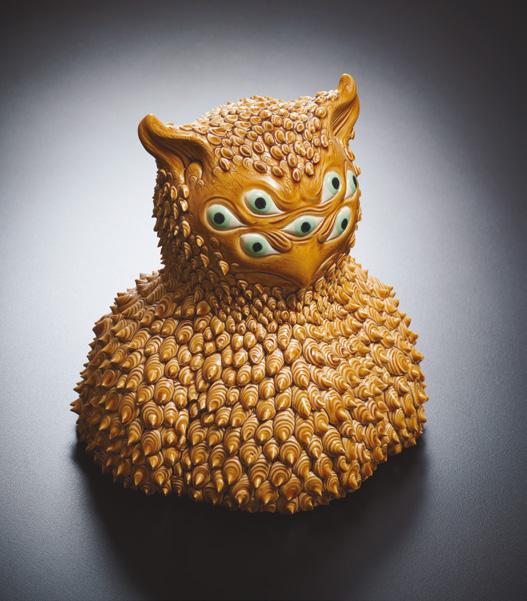
Lawson Oyekan
Ore in Edy-Rose, Known 2015
Earthenware with black slip
28 x 30 x 30 cm
Lawson Oyekan is a ceramist sculptor who sculpts with clay. Oyekan often uses clay to explore histories connected with land by excavating and working site-specific matter. He makes monumental ceramic installations and smaller vessel-like pieces. A signature feature within his ceramic works are pierced walls which add to the depth and texture by creating passages for air and light. Gestural marks echo calligraphic inscriptions inspired by poetry in Yoruba and English. An integral part of Oyekan’s practice is to convey his thoughts on the beauty and power of nature through its transformation and destruction.
The sculptor’s work is inspired by the very material that creates life, clay. In this, the material is imbued with historical, mythological and sacred meaning. Ore in Edy-Rose, Known is made from clay extracted from the Nécropole nationale de La Fontenelle, a military cemetery near Oyekan’s studio in the Vosges Mountains, France. Oyekan processes waste earth from the site with water from a local river to extract a reddish clay which holds traces of the metal debris deposited in the ground when the area was a battleground during the First World War. The vessel’s swirling ‘rose’ shape refers to the eddies that form when a fast-flowing river meets an obstacle and briefly flows back on itself. For Oyekan this motif is a metaphor for human experience.
Middlesbrough Institute of Modern Art (MIMA) is dedicated to collecting a range of works by diverse artists, particularly those who tell stories of their own personal histories. Oyekan’s work joins pieces by many of his contemporaries in the MIMA Collection.
The work builds on MIMA’s collection of sculptural ceramics and works that engage with clay to develop social, conceptual and performative works. It connects with thematic strands in the collection around land and ecologies, migration and hybrid cultures.
Lawson Oyekan (b.1961, London) lives in Vosges, France. Recent shows and installations include Sotheby’s Gallery, London (2020); Fitzwilliam Museum, Cambridge, then touring to Yale University, New Haven (2018); and Positif Exil, Paris (2015). Lawson Oyekan was awarded the Grand Prize Award Winner of the 1st World Ceramic Biennale, South Korea (2001).
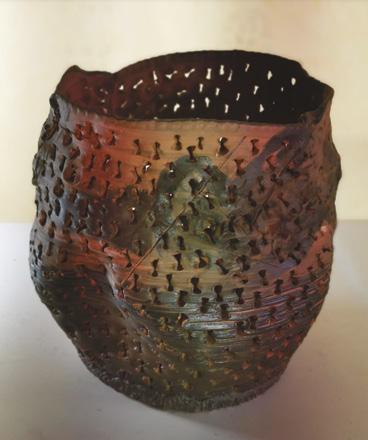
Sam Bakewell
Dust, V (Time for Waste)
2018
Parian
3.2 x 17 x 11.3 cm
Opposite, bottom
Dust, IV (Time for Waste)
2018
Parian
8.5 x 9.5 x 11.7 cm
Opposite, top
Sam Bakewell works predominantly with clay, exploring the relationship between making, creativity and mental health. Bakewell believes in the power of clay to reveal our subconscious by engaging with the material while letting the mind wander. Growing up in a small village in Somerset, Bakewell spent many hours digging up clay in his garden. Taking evening classes with his father from the age of eight, he followed whatever path he could to continue to use clay. His practice explores the expansive formal possibilities of the material through a self-critical and autobiographical approach. He dissects the role of the maker, the objects made, and the cultural/aesthetic value systems bestowed upon them.
For the Dust V and Dust IV pieces, Bakewell used the shavings from fine-sanding his works, transforming the detritus into new work. Firstly, the dust is sieved, fired and sieved again. Then it is arranged in neat piles on small, compact blocks which are then fired to set. Bakewell achieves a variety of effects with the dust, some piles are slightly clumped while others remain a fine powder. It is a playful manipulation of material creating a sense of vulnerability through the illusion that the dust could be blown away. The Dust pieces are deceptively fragile, highlighting Bakewell’s skill as a ceramicist.
The colours are carefully considered, pairing bright colours with pastel and dark powders, almost resembling a painter’s palette with mounds of pigment neatly arranged.
Nottingham City Museum has a large collection of pottery, including 18th-century Wedgwood ceramics and 20th-century studio pottery, but contemporary ceramics are under-represented. Bakewell’s acquisition reflects the innovative and more conceptual making of today’s ceramic artists and makes connections with other parts of its collection, including contemporary textiles and sculptural installations.
Sam Bakewell (b.1983, in Yeovil, Somerset) lives and works in London. Recent solo exhibitions include Corvi-Mora, London (2019 and 2021). Group shows include Kate MacGarry, London (2020); Meşher, Istanbul (2019); Messums Wiltshire, Wiltshire (2017); and British Ceramic Biennial, Stoke-onTrent, 2015; He was Artist in Residence at the Victoria & Albert Museum, London, and won the British Ceramics Biennial Award (Stoke-on-Trent) in 2015.
Presented by the Contemporary Art Society, through the Omega Fund, 2019/20
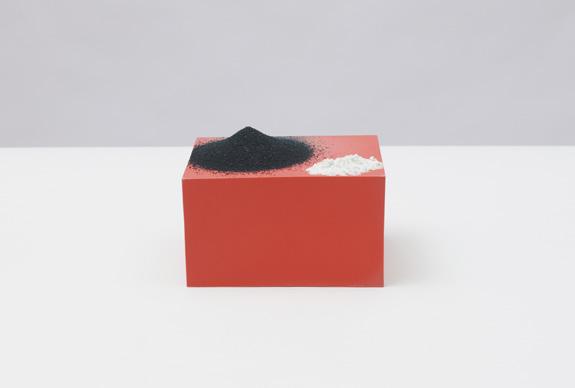

Nao Matsunaga
Rototo
2019
Glazed Ceramic
60 x 69.8 x 54.9 cm
Nao Matsunaga is guided by an exploration of ancient ceremonial traditions, and this anthropological gaze analyses similarities in past and present cultural and human interactions. Matsunaga employs clay, wood, ceramics and paper in his works. He is inspired by the unknown, fusing techniques both ancient and contemporary to create pieces that have entirely new meanings. These unique artworks speak for themselves, intended to occupy and evoke a ceremonial existence.
Rototo is comprised of glazed ceramic. Matsunaga is fascinated by working with clay, by its ability to capture movement and in a sense, time. His creative process includes ‘slap building’ and ‘blanket glazing’, techniques that he developed himself. After kiln firing, the marks made on the soft clay become permanent. Matsunaga’s practice entails engaging with the materials which he manipulates. He engages in a natural dialogue, allowing the material’s elasticity to guide the process and dictate the outcome. Matsunaga utilises references from his Anglo-Japanese background, international residencies in Arizona and Norway and interest in universal primitive objects. The artist cites diverse sources of inspiration – from Native American and Ainu tribal designs, folk and outsider art, and arte povera to Thomas Houseago, Aaron Curry and Isamu Noguchi.
Matsunaga has links to Brighton University where he studied from 1999–2002. Royal Pavilion and Museum, Brighton & Hove is continuing to position itself as a museum of making with the success of the 2019–20 pottery
exhibition Cultural Icons. The acquisition of Rototo will enable opportunities for research around the nature of abstraction in contemporary ceramics .
Nao Matsunaga (b.1980,Osaka, Japan) lives and works in London. Recent solo exhibitions include Tokyo Art Centre, Japan (2020); Marsden Woo, London (2020); and New Art Centre, Salisbury (2019). Recent group exhibitions include Te Auaha, New Zealand (2020); Stereo Exchange, Denmark (2020); and Large Glass, London (2019). Matsunaga studied Wood, Metal, Ceramics and Plastic at the University of Brighton and holds an MA in Ceramic and Glass from the Royal College of Art (2007). In 2013 he won the British Ceramics Biennial Award and the Jerwood Makers Open in 2012.
Presented by the Contemporary Art Society with the support of New Art Centre, 2020/21
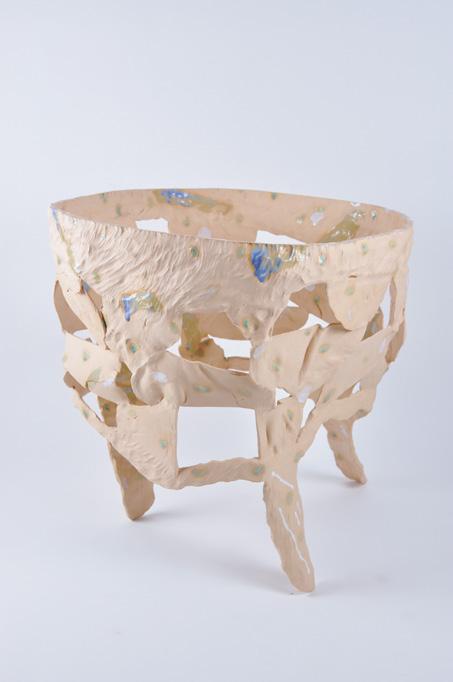
The Odyssey 2003
Thread, fabric on canvas
180 x 385 cm
Alice Kettle’s textile works exploit largescale mechanical processes and emotive, figurative scenes. Her work asserts the power of myth and storytelling, emphasising its centrality to human life. In her exploration of narratives, she draws inspiration from literary, mythological and poetic sources delving into their power to form worlds. Her works are massive in scale, which creates an almost cinematic impact, yet on closer inspection they are incredibly detailed and craft a lyrical narrative through exquisitely intricate embroidery.
Originally made for the Mythscapes exhibition (2003–2005) at the Bankfield Museum in Halifax, England, Kettle’s textile work tells the dual story of Penelope and Odysseus. Homer’s epic explores notions of rites of passion, faith and endurance, which are the references for Kettle’s process of making the resulting artwork.
By crafting a narrative in embroidery, Kettle centralises the role of Penelope even as she is absent from the image. In the Odyssey, Penelope fends off suitors by weaving a burial shroud for Odysseus’s elderly father Laertes and claiming that she will choose a suitor when she has finished. Every night for three years, she undoes part of the shroud and this is presented as an equally heroic action to Odysseus’s journey.
Kettle’s tiny stitches combine to create richly textured, painterly strokes of colour. These form the sea and land which are opposing forces, obstacles and fluid elements that Odysseus traverses throughout the story. These unsteady and fixed worlds reflect the experiences of those within them and this
work, made in a time of personal turmoil for the artist, recreated for her a sense of home: a place in the world. Kettle renders this epic story in an epic scale, capturing both the vast scope and the emotional intricacies of the story.
Alice Kettle (b.1961, Winchester, UK) is currently a Professor of Textile Arts at the Manchester School of Art. Recent solo exhibitions include Candida Stevens Gallery, Chichester (2020); The Whitworth, Manchester (2018); Winchester Discovery Centre; and Candida Stevens Gallery, Chichester (both 2017). Group shows include British Textile Biennale, Gawthorpe Hall; Karachi Biennale 19, Pakistan (both 2019); and the 11th China Embroidery Festival, Hanshan Art Museum, Suzhou (2018).

Purchased through the Chipperfield Bequest Fund with support from the Arts Council England/V&A Purchase Grant Fund, the Art Fund, the Contemporary Art Society and the Nerys Johnson Contemporary Art Fund, 2019/20

‘The importance and impact of female collectors and artists has long been overlooked and underestimated, so we are delighted to have the opportunity of acquiring a large collection of significant works, mostly by female artists, from the collection of Patricia Barnes.’
Dr Helen Walsh, Curator of Ceramics
Patricia Nichol Barnes was born in Chicago, Illinois on 16 July 1928. She passed away at the age of 91 on 21 December 2019. Patricia Barnes was guided by a passion for literature and art, teaching composition briefly at Malcolm X College and running an antiquarian bookstore with her husband Richard S. Barnes. After moving to London part time, Patricia Barnes became an avid collector of contemporary British ceramics and sculpture. Her collection includes a number of works by Alison Britton, Carol McNicoll and Ewen Henderson among others. Her collection grew large enough for Barnes to open an art gallery, The London Gallery, in Illinois. The London Gallery granted a new exposure to an American audience with an interest in British ceramics. Between managing the gallery and living in London, Barnes shared her love of and delight in contemporary British artists, cementing her reputation as a pioneer in the field of collecting. Barnes’s legacy has secured her an important place in this history; she will
be remembered as one of few female collectors, a rarity in her lifetime.
The Contemporary Art Society were granted the pleasure of working with the family of Patricia Barnes to gift a large collection of these works to three member museums, York Art Gallery; The Hepworth Wakefield and Middlesbrough Institute of Modern Art (MIMA). These works span a range of Barnes’s collecting, reflecting her aesthetics and eye for exquisite ceramics. The collection for Middlesbrough Institute of Modern Art is diverse, including an elegant teacup by Ryoji Koie, and a set of dinner plates by Hylton Nel and a dish by Jacqui Poncelet – both with intricate figurative designs. York Art Gallery have received a large collection of works, including sets of cups by Carol McNicoll and Edla Griffiths, examples of British studio pottery. The Hepworth Wakefield have received a collection of works including an elaborate dish by esteemed ceramicists Alison Britton OBE and Ladi Kwali MBE.
A gift from the private collection of Patricia Nichol Barnes, presented by the Contemporary Art Society, 2020
York Art Gallery
Alison Britton
Set of 5 cups
1992
Hand-built stoneware, with coloured slip
13.5 x 20 cm
Opposite, left
Alison Britton
Large Wall Panel
1970
Slab-built earthenware, tin-glazed with green copper carbonate inlaid pattern
57 x 57 x 4 cm
Bryan Illsley
Tea pot
c.1993
Earthenware
18 x 19 cm
Bryan Illsley
Untitled
Painted wood
Date to be confirmed
89 x 62 x 9 cm
Bryan Illsley
Metal Mask
1979 metal
28 x 23 x 20 cm
Bryan Illsley
Mallet
c.1978
Oil on board
45 cm
Carol McNicoll
Composite Milk Jug
c.1992
Earthenware, slip glaze and transfers
10 x 16 cm
Carol McNicoll
Composite vase and coffee
pot
2005
Earthenware, slip glaze and transfers
29.5 x 22 x 12 cm
Carol McNicoll
Corrugated tea pot
1992
Earthenware
21 x 28 x 15 cm
Carol McNicoll
Double candle holder
Date to be confirmed
Earthenware
16 x 28 x 17 cm
Carol McNicoll
Fan shaped Fruit Bowl
Date to be confirmed
Earthenware
21 x 36 cm
Above, right
Carol McNicoll
Set of 4 Coffee cups
c.1992
Earthenware
23 x 21 x 13 cm each
Carol McNicoll
Fruit bowl with twisted handles
Date to be confirmed
Earthenware
20 x 22 x 22 cm
Carol McNicoll
Giraffe bowl stand
2000
Earthenware
29 x 28 cm
Carol McNicoll
Large vessel with corners
c.1982
Earthenware
38 x 35 x 34 cm
Carol McNicoll
Large fruit bowl
1996
Earthenware, one-off, slip cast, marble, bolted rod, clear glaze, coloured slips and transfers
34 x 20 cm
Carol McNicoll
Plate
c.1980
Earthenware
20 cm
Carol McNicoll
Large vessel with corners
c.1982
Earthenware
38 x 35 x 34 cm
Carol McNicoll
Large fruit bowl
1996
Earthenware, one-off, slip cast, marble, bolted rod, clear glaze, coloured slips and transfers
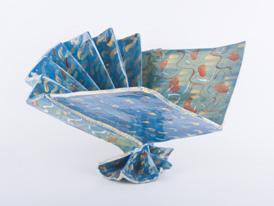

34 x 20 cm
Carol McNicoll
Vase with striped fish
c.1990s
Date to be confirmed
Earthenware 28 x 23 cm
Carolein Smit Dog
Date to be confirmed
Glazed earthenware 26 x 32 cm
David Garland
Large Bowl
Date to be confirmed
Earthenware 45 cm
Edla Griffiths
Jug
Date to be confirmed
Glazed earthenware
Edla Griffiths
Set of 4 cups
Date to be confirmed
Glazed earthenware
Dimensions vary
Edla Griffiths
Date to be confirmed
Glazed earthenware
Painted wood, polychrome 89 x 62 x 9 cm
Hylton Nel
Set of 4 Dinner plates
Date to be confirmed
Painted ceramic
22 cm each
Hylton Nel
Set of 2 Dinner plates
Date to be confirmed
Painted ceramic
29 cm each
Henry Pim
Untitled
Date to be confirmed
Stoneware with matte green glaze
29 cm
Janice Tchalenko
Deep Bowl
Date to be confirmed
Glazed earthenware
22 cm
Kenneth Eastman
Untitled
1990
Stoneware painted slip
20 x 48 x 38 cm
Kenneth Eastman
Untitled
1990
Stoneware painted slip
35 x 47 x 36 cm
Kenneth Eastman
Untitled
1990
Stoneware painted slip
22 x 39 cm
Michael Ambrose Cardew Platter
Date to be confirmed
Earthenware
44 x 27 x 7.5 cm
Quentin Bell
Painted Fulham pottery
Plate
Date to be confirmed
26 cm
Maker Unknown
Double spouted vessel with bridge handle
Date Unknown
Glazed earthenware
16 x 20 cm
The Hepworth Wakefield
Alison Britton Blue Zigzags
1986
Hand-built stoneware, slip and underglaze
46 x 29 x 20 cm
Alison Britton
Leaf Dish
1989
Hand-built stoneware, slip and underglaze
18 x 40 x 36 cm
Angus Suttie
Pair of vessels
1990
Earthenware
19 x 18 cm each
Ewen Henderson Boat shaped Dish
1981
Slab built stoneware, inlaid clay
13 x 41 x 15 cm
Ewen Henderson Coffee Set
1990
Slab built stoneware, inlaid clay
32 x 40 x 30 cm
Ewen Henderson
Cup and saucer
Date to be confirmed
Earthenware
Dimensions vary
Ewen Henderson
Dish with tessellated triangular form
1980
Earthenware
33 x 49 cm
Ewen Henderson
Sprig Jug with Autumn leaves
2011
Earthenware
9 x 17 cm
Ewen Henderson
Sprig Jug with war planes
2011
Earthenware
11 x 20 cm
Ewen Henderson
Unfurling vase
Earthenware
26 x 36 x 34 cm
Ewen Henderson Vase
1980
Earthenware
26 x 22 cm
Jacqueline Poncelet
Untitled sculpture
1979
Slab built stoneware
30 x 30 cm
Jacqueline Poncelet
Untitled vessel
1981
Stoneware inlaid clays
13 x 41 x 15 cm
Ladi Kwali
Small dish
Glazed ceramic
19 cm
Mary Rogers
Vase
Porcelain
15 x 12 cm
Ruth Windmüller Duckworth
Biomorphic form
Date to be confirmed
Hand-built stoneware, glaze
24 x 30 cm
Ryoji Koie
Platter
1981
Stoneware
8 x 32 x 26 cm
Middlesbrough Institute of Modern Art
Alison Britton
Field
2007
Slab built earthenware, decorated underside
9.5 x 26 x 27 cm
Carol McNicoll Coffee Pot
1990
Earthenware
28 x 27 x 20 cm
Carol McNicoll Cup and Stand
1994
Earthenware
12 x 17.5 x 15 cm
Carol McNicoll Cup and saucer
1976
Earthenware
9 x 14 x 14 cm
Carol McNicoll
Cut glass mug
Dimensions
2014
Earthenware
11 x 12 x 7 cm
Carol McNicoll
Dessert bowl with set of 7 dishes
Date to be confirmed
Earthenware
Dimensions vary
Carol McNicoll
Pair of candlesticks
Date to be confirmed
Earthenware
23 cm each
Carol McNicoll Ribbon Cup
1990
Earthenware
8.5 x 15 x 8 cm
Carol McNicoll
Soft Jug and 5 soft mugs
1991
Earthenware
Dimensions vary
Carol McNicoll
Sprig Jug, Transfer printed, Range Rovers
2011
Earthenware
14 x 18 x 12 cm
Carol McNicoll
Unfurling vase
Date to be confirmed
Earthenware, 26 x 36 x 34 cm
Christie Brown Head
1995
Stoneware
18 x 13.5 x 16 cm
Hylton Nel
6 dinner plates with shell design
Date to be confirmed
Dimensions vary
Jacqui Poncelet
Dish form
1981
Stoneware
5 x 58 x 27 cm
Jill Crowley Cat
1980
Raku-fired earthenware
38 x 16 x 11 cm
Michael Cardew Mug
Date to be confirmed
Slipware
13 x 14 x 10 cm
Michael Cardew Mug with inscription
Date to be confirmed
Slipware
13.5 x 14 x 10 cm
Michael Cardew Sauceboat
Date to be confirmed
Slipware
6.5 x 22 x 15 cm
Ryoji Koie
Tea bowl
Date to be confirmed
Stoneware 10 x 12.5 x 10.5 cm
Edward Allington (1951–2017) was a sculptor, educator and writer. He gained recognition in the early 1980s during the New British Sculpture Movement. Notable early exhibitions were ‘Objects and Sculpture’ at the Institute of Contemporary Art (ICA) in 1980 and ‘The Sculpture Show’ at The Hayward Gallery in 1983. He is represented in The Arts Council and The British Council collections; Tate; the Victoria and Albert Museum, IMMA, Dublin; and Foundation Cartier, Paris.
Edward Allington studied Ceramics at Central Saint Martins and Cultural History at the Royal College of Art. He was Gregory Fellow at the University of Leeds and the Henry Moore Institute. Allington was Professor of Sculpture and Head of Graduate Sculpture at the Slade School of Fine Art, UCL where he remained from 1990. The Contemporary Art Society has been privileged to work with his family to gift several sculptures and accompanying works on paper to Manchester Art Gallery, The Hepworth Wakefield and Middlesbrough Institute of Modern Art.
Allington was concerned with the influences and incorporation of Greek and Roman aesthetics and architecture in contemporary life. In his sculptures and drawings, he conveyed this in a whimsical manner that combined kitsch with an industrial approach. Allington often played with scale and form to push the boundaries of the conceptions of contemporary sculpture.
Herm I and Herm II (The Hepworth Wakefield) portray the incorporation of kitsch, such as plastic fruits and pebbles, and stem from an observation of varying cultural influences upon contemporary art practice, whilst Aphrodite Debased in Blue (Manchester Art Gallery) portrays Allington’s expression of Greek architecture and scale. In total there are thirteen works on paper and sculpture gifted to Contemporary Art Society Member Museums that convey Allington’s legacy as one of Britain’s most innovative sculptors.
Gift of the Estate of Edward Allington, presented by the Contemporary Art Society, 2020
Manchester Art Gallery
Aphrodite Debased in Blue
1986
Stuccoed wood, paint and marble figures
33 x 72 x 25.5 cm
Opposite
One Unforgiving Minute
1984
Steel, wood, plastic vases, plaster and paint
168 x 137 x 107 cm
Untitled
1983
Pencil, ink and emulsion on ledger paper
Dimensions unknown
Untitled 1986
Pencil, ink and emulsion on ledger paper
44 x 60 cm
A Fragment of my Lost Love II
2013
Pencil, ink and emulsion on ledger paper
47.9 x 60.1 cm
The Hepworth Wakefield
Room Fragments I – IV
1991
Copper, MDF, dexion, carpet felt, fluorescent light, armoured cable
126 x 30.5 x 39 cm, 77 x 61 x 157 cm, 51 x 61 x 125 cm and 61 x 30.5 x 70.5 cm
First Herm 1983
Steel, plastic apples, and bananas
80 x 80 x 155 cm
Second Herm 1983
Steel, plastic stones
40 x 40 x 100 cm
Middlesbrough Institute of Modern Art (MIMA)
From Forgotten Seas 1981
Plaster, paint, bronze powder, 102 x 70 cm
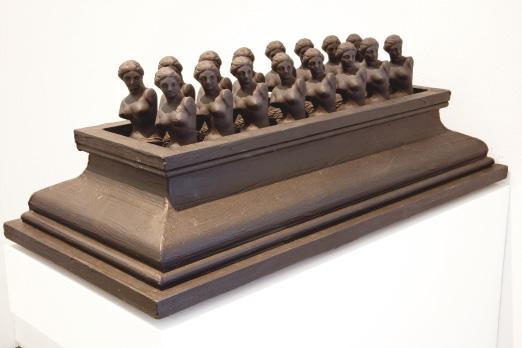
From Forgotten Seas 1981
Ink and emulsion on paper 73 x 69 cm
the first day and the first hour
2013
Porcelain in wood, aluminium and plexiglas vitrines
40 x 169.2 x 17 cm
Born in Nottingham, Edmund de Waal has an enduring love for porcelain, or ‘white gold’, and has a long fascination with objects. He is not only interested in their touch and form, but also in their ‘lives’ – how they are collected, dispersed or lost. De Waal’s obsession with objects was sparked during his childhood, when he was given a collection of fossils and stones by a local archdeacon. Literature, sound, and architecture also serve as vital sources of inspiration for de Waal’s practice.

De Waal is known for his porcelain vessels of neutral colours grouped together in custommade, highly minimalist vitrines. Because of their subtle variations in tone and texture, each pot de Waal produces is unique. With their little dents and pinches, they testify to the beauty of imperfection. The groupings are like rhythms, and the individual vessels notes of a musical composition or words in a poem written by de Waal.
the first day and the first hour reflects this, as well as the importance of natural light to his work, which falls softly on to the porcelain and casts shadows that shift throughout the day. He describes how these vessels are ‘all about breath, the space inside; for me a vessel is all about holding a breath: one breath and then another’.
Nottingham has an important collection of ceramics, with particular strengths in 18thcentury Wedgwood, Chinese porcelain and the Ballantyne collection of 20th-century studio ceramics. the first day and the first hour is a significant addition and will impact on the way the museum considers and works with this historical collection. However, given how Edmund de Waal’s work bridges the worlds of Fine and Decorative Arts so elegantly, this
gift also sits comfortably within the museum’s contemporary art collection. the first day and the first hour will be displayed in Nottingham for the first time in summer 2021, when the Castle re-opens after a major redevelopment.
Edmund de Waal (b. 1964, Nottingham, UK) lives and works in London. Recent solo exhibitions include Gagosian, London (2020/21); Henry Moore Studios & Gardens, Perry Green (2021); and New Art Centre, Wiltshire (2021). Recent group exhibitions
include Frick Collection, New York (2019); 58th Venice Biennale (2019); and Centraal Museum, Utrecht (2019). De Waal is also a writer, publishing The Hare with Amber Eyes (2010), The White Road (2015) and Letters to Camondo (2021).
Gifted by the artist through the Contemporary Art Society, 2019/20

Untitled 1 – 5 2019
Gouache on paper
41.9 x 29.6 cm
Lisa Brice is an artist who creates drawings and paintings. The focus of her work is about reclaiming ownership of the portrayal of women in art. She often paints nude women doing mundane activities to challenge the often misogynistic depiction of women in historical portraiture, largely painted by white men, for white men. Brice is interested in portraying the dynamics and differences in space and hierarchy, such as the difference between public and private or artist and muse. Brice gives agency to her subjects which can be seen through their posture and gaze. Objects such as cigarettes also disrupt the notion that the figures are to be objectified. Cobalt blue is a signature colour of Brice’s, the other being vermilion red. In these works, cobalt creates both distance from race and a depth in form. The figures are neither gendered nor racially specific; they are feminine but not female. The colour is also inspired by Brice’s time spent in Trinidad and Tobago. The Jab Molassie (Devil Molasses) is a masked representation of the devil in the Trinidad and Tobago Carnival. The performer is smeared in blue or black dye from head to toe to mask their identity and create havoc. In Brice’s work the blue represents boundaries; the blue mask enables the figures to reclaim control over how they are perceived.
Untitled comprises a set of gouache works on paper from her series of female nudes established in 2014. The figures are captivating, both abstract and represented in an ethereal style. There is both an air of liberation and secrecy conveyed in the works. There is inhibition in the intimacy yet there is also mystery. The figures inhabit interior
worlds which feel private, where they relax, slouch and smoke with a sense of assuredness.
Untitled explores feminine confidence and pleasure through mundane activities and poses, whilst challenging the authority of the gaze. In contrast to representations by Manet, Picasso or Degas, Brice’s subjects challenge traditional representations of women in the art historical canon. In recent years, The Whitworth has been acquiring works on paper that show female artists representing women. For The Whitworth, these drawings by Brice will strengthen this area of the collection, confronting historic works that display the female nude as depicted by men.
Lisa Brice (b.1968, Cape Town, South Africa) lives and works between London and Trinidad. Recent solo shows include The Hague Contemporary, The Netherlands (2020); Stephen Friedman, London (2019); and Tate Britain, London (2019). Recent group shows include Stephen Friedman, London (2020); Thaddaeus Ropac, London (2019); and Goodman Gallery, Cape Town (2018).
Gifted by the Holly Peterson Foundation through the Contemporary Art Society, 2019/20
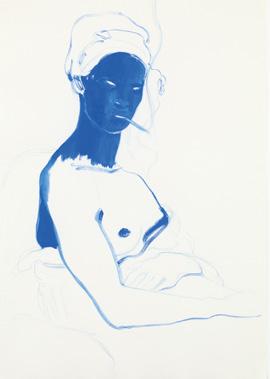


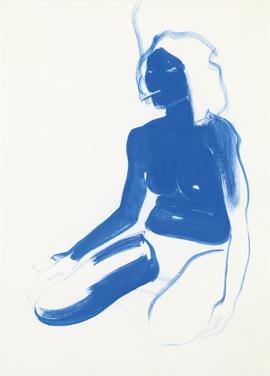
Haroon Mirza
Duet for a Duo (Solar Symphony 7) 2015
Photovoltaic panels, LEDs, Arduinos, rock speakers, cable Dimensions variable
Haroon Mirza is internationally acclaimed for his installations, sculptures and performances. His art uses audio interference to question predetermined concepts of noise and music by exploring relationships between sound, light and electricity. He manipulates electricity through inanimate objects to orchestrate an interplay between sound and vision, describing himself as a kinetic composer. Regular objects such as electrical goods, vinyl and turntables, LEDs, furniture and video footage are used for a different purpose forcing one to reconsider both their form and function. Synthesised by Mirza’s modifications, the space in which a work resides transitions into an atmospherically charged arena, at once both harmonious and divergent.
Duet for a Duo (Solar Symphony 7) is an interactive sound and light sculpture and part of Mirza’s solar-powered, multi-sensory Solar Symphony series. Electronic audio compositions are generated through rockformation speakers while a band of lightemitting diodes change brightness according to the strength of the sunlight as it tracks across the photovoltaic panels. The noise and light both have a direct relationship to the intensity of the sun, increasing or decreasing as more or less light is absorbed.
In 2010 Haroon Mirza’s work featured in ‘Art Sheffield 2010 – Life: A User’s Manual’, held at the Millennium Gallery. Living in and working in Sheffield at the time, Mirza was a key member of the Sheffield art scene and in 2011, Museums Sheffield nominated him for the Northern Art Prize, which he subsequently won. His piece Duet for a Duo
(Solar Symphony 7) is a valuable addition to Sheffield’s collection of contemporary artworks, joining that of other internationally renowned artists such as Grayson Perry, Sutapa Biswas and Kateˇrina Šedá.
Haroon Mirza (b.1977, London) lives and works in London. Recent solo exhibitions include CCA Kitakyushu, Kitakyushu, Japan; Hausler Contemporary, Zurich, Switzerland (both 2020); John Hansard Gallery, Southampton; and Aberdeen Art Gallery, Aberdeen (both 2019). In 2018 Haroon Mirza unveiled a large-scale outdoor sculpture commissioned by Ballroom Marfa, Texas, which will remain in the landscape for five years. He has won numerous awards including the Northern Art Prize and the Silver Lion at the 54th Venice Biennale (both in 2011), the Nam June Paik Art Center Prize (2014); and the COLLIDE International Award (2017).
Presented by the artist through the artist through the Contemporary Art Society, 2020/21

Catherine Yass
Karisma Kapoor
2000
Ilfochrome transparency, lightbox
88 x 131 x 12.5 cm
Opposite, top
Madhuri Dixit
2000
Ilfochrome transparency, lightbox
88 x 131 x 12.5 cm
Opposite, middle
Sanjay Dutt
2000
Ilfochrome transparency, lightbox
88 x 131 x 12.5 cm
Opposite, bottom
Catherine Yass creates photographs and films that explore the relationship between physical and psychological space, namely how environments are constructed and experienced by their inhabitants, through an emphasis on temporal duration. Her signature photographic method involves manipulating both the exposure and development of the film, layering a positive transparency on top of a negative. Yass then realizes the resultant images as lightboxes, prints and films. Her technique yields images that are richly coloured, ethereal abstractions that embody the dualities of reality and illusion, presence and absence.
Catherine Yass represented Britain at the 10th Indian Triennale in New Delhi in 2002 with a body of work specially commissioned by the British Council. The series, entitled ‘Star’ comprised six lightboxes depicting portraits of Indian Bollywood film celebrities, with a further four images of empty auditoria of Mumbai cinema houses. Living in the East End of London, Yass’s first awareness of Indian film came via the large Asian community there.
The glowing, dreamlike quality of Yass’s ‘Star’ series speaks of the almost sacred status of Bollywood actors among fans. The global phenomenon of Bollywood is a significant part of cultural life for many Birmingham communities, but it is an art form not often acknowledged in a fine art or museum context. In this, the works will contribute to Birmingham Museums Trust’s collection focus on acquiring work that represents Birmingham as a multicultural, transcultural and global city. The pieces will join a series of six photographic cityscapes by Yass in the Birmingham collection and are an excellent addition to a rapidly growing collection of portrait photography including recent acquisitions of work by Pogus Caesar, Stephen J. Morgan and Vanley Burke.
Catherine Yass (b.1963, London) lives and works in London. Recent solo shows include Ambika P3, London (2021); Milton Keynes Gallery (2014); and Alison Jacques Gallery, London (2012). Recent group shows include Galerie Lelong & Co., New York (2021); Guildhall Art Gallery, London (2019); and Wellcome Collection, London (2018). In 2002 Yass was shortlisted for the Turner Prize and since 2012 she has been teaching MA Photography at the Royal College of Art, London.
Gifted by Catherine Yass through the Contemporary Art Society, 2019/20
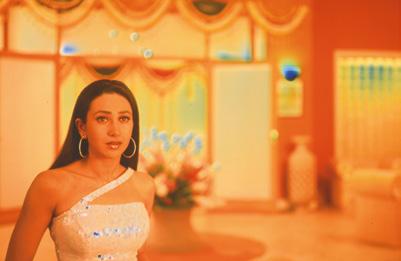
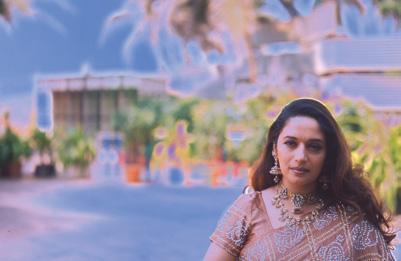

Sleep (path)
2005
Ilfochrome transparency, lightbox
68 x 86 x 13 cm
Catherine Yass is an important British artist known for her use of experimental photographic and film techniques. Her use of analogue photography using negative images and overlaid transparencies creates a distinctive solarising effect:

‘Space and time are distorted to disorientating effect, pulling you in and out of the image and suggesting different psychological, spatial and temporal dimensions. The image is de-familiarised, asking us to re-position ourselves and re-think how we are in the world.’
In common with much of her work, Sleep (path) has a disturbing psychological quality. As early as 2002 Yass began exploring the crossover between sleep and wakefulness, trying to capture a sense of how the unconscious mind shapes our perception of everyday reality. Paths, stairs and corridors are recurrent motifs in her work and images of pathways through trees have re-emerged in her most recent work.
The Atkinson prioritises the acquisition of work by leading contemporary female artists. Recent additions to the permanent collection include digital work by Tracey Emin, mixed media pieces by Cornelia Parker and Laura Ford and a suite of etchings by Rachel Whiteread. Catherine Yass’s Sleep (path) will be seen in the context of other photographic works in the collection, including works by Yevgenia Arbugaeva from the ‘Tiksi’ series, and experimental photography by Paul Kenny as well as Boyd & Evans.
The Atkinson has programmed an exhibition exploring the imagery of trees for 2022. Sleep (path) will be exhibited alongside
major historical works from our permanent collection such as Paul Nash’s Vimy Ridge, John Piper’s Ruin, Dentdale and The Vineyard by Vanessa Bell.
Catherine Yass (b.1963, London) lives and works in London. Recent solo shows include
Ambika P3, London (2021); Milton Keynes Gallery (2014); and Alison Jacques Gallery, London (2012). Recent group shows include Galerie Lelong & Co., New York (2021); Guildhall Art Gallery, London (2019); and Wellcome Collection, London (2018). In 2002 Yass was shortlisted for the Turner Prize
and since 2012 she has been teaching MA Photography at the Royal College of Art, London.
Gifted from Aspen Insurance Holdings Limited through the Contemporary Art Society, 2020/21
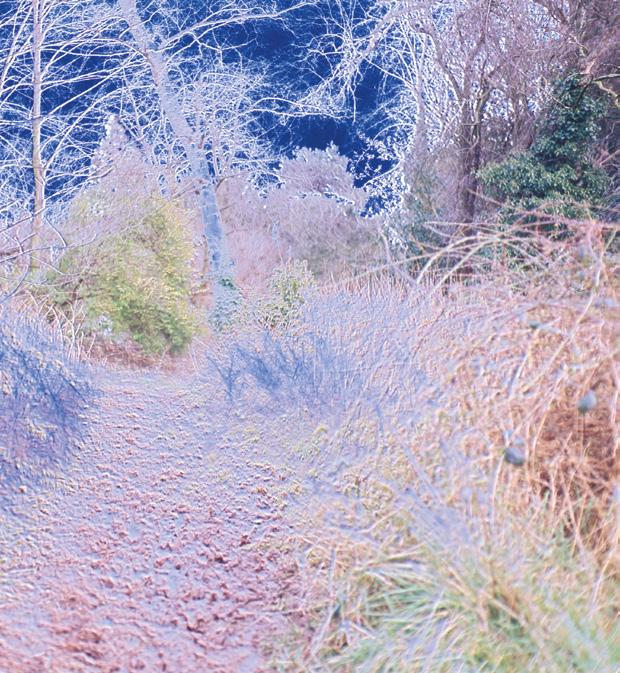
2020
Oil on board
51 x 76cm
Matthew Krishanu’s works draw on his early childhood spent in Dhaka. His parents moved there when Krishanu was two years old, in order to work for the Church of Bangladesh. Krishanu’s paintings meditate on the displacement he felt as a child with Indian and white British parents growing up in Bangladesh. His works also convey a sense of fascination with, but distancing from, the rituals of the church and the work of his parents, which he observed at close hand without ever feeling a part of.
Krishanu often employs shallow pictorial depth and backgrounds that veer into abstraction. He paints figures in those shallow spaces that often seem to exist in a liminal zone, at a remove from their surroundings. These techniques are seen in the work Procession of Priests, in which nine priests in long robes walk barefoot in the same direction. On closer inspection it is apparent that there is one white priest in amongst this procession of South Asian faces. From a western perspective this is a small but important reversal: a lone white subject (who is in fact Krishanu’s father) in a minority position. The painting subtly articulates the hybridised practices that took hold after the British had departed and speaks of the lives of those who lived in the postcolonial landscape. Empire might have been history, but its effects were still all around, a phenomenon that continues to this day.
Part of Krishanu’s ‘Mission’ series, Procession of Priests is informed by memories of his early childhood in Bangladesh, and by his own experiences and identity as a child of mixed heritage. He explains that these dreamlike
works that reference half-remembered moments and places from his childhood are ‘about religion’ as opposed to being religious painting. When the artist was born his father was working as a curate in Bradford, but soon afterwards the family relocated to Selly Oak in Birmingham where his parents undertook training for a move to Bangladesh for mission work.
Birmingham Museums Trust’s ongoing collecting aims include acquiring works that explore the lives of Birmingham people, their childhoods and faiths, as well as the histories and continuing legacies of the British Empire. Krishanu’s work is a beautiful intersection of these interests.
Matthew Krishanu (b.1980, Bradford, UK) lives and works in London. Recent solo shows include Niru Ratman Gallery (2020); Iniva, London; Midlands Arts Centre, Birmingham; Ikon Gallery, Birmingham (all 2019); and Huddersfield Art Gallery (2018). Group shows include Walker Art Gallery, Liverpool (2021); Hayward Gallery/Southbank Centre; and Lahore Biennial, Lahore (both 2020).
Donated by Guy Halamish through the Contemporary Art Society, 2020/21
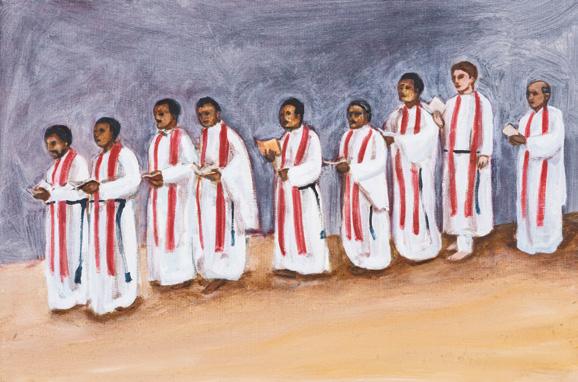
Joanna Price
Good form and Nice style
2003
Oil on canvas
122 x 122 cm
Opposite, top
Untitled
c.1999
Painted and glazed ceramic
25 x 20 x 12 cm
Opposite, bottom
Joanna Price is best known for her figurative works, studies of life and society which reference paintings and themes from the past but always with a refreshing and subversive narrative. A recurring motif in her works are blue, male figures in suits, first seen in her second solo exhibition, ‘Small Blue Executive World’, at the Anna Bornholt Gallery. Good form and Nice style is typical of this style, with blue figures, clustered on floating islands, their dramas played out on a pale surface. The island motif is also seen in the organic form of the ceramic sculpture, which also depicts a similar male tension.
The Guildhall Art Gallery houses the City of London Corporation’s art collection and is situated in the heart of the Square Mile. The collection is particularly rich in Victorian art and since the Second World War the Gallery has concentrated on expanding its unique collection of London pictures. Given the Gallery’s location, several works explore themes associated with the City of London, such as money, power, boom and bust, trade and commerce, with particular reference to the financial services.
Price’s works are well-observed portraits which evoke the masculine/phallic energy of the City of London, a part of the city which is evidenced in the collection through formal portraits mainly of men in roles of power and
authority, and to this aspect of the collection the two works are a pertinent counterpoint. In Good form and Nice style, the actions of the figures are ambiguous, the interactions can be read as friendly or something more malevolent, a kind of restrained violence. The figures in the sculpture, men urinating (top level) whilst other figures hold them up (bottom level) has a similar tension, and most obviously brings to mind the term ‘pissing contest’ and what it means metaphorically as well as its connotations of toxic masculinity. With an obvious visual link to the Gallery’s financial surroundings, Price’s work within this context is particularly thought-provoking.
Joanna Price (b. 1956, Wexford, Ireland, d. 2014, Norfolk) lived and worked in Paris and New York before settling in London. She enjoyed considerable success as a painter in the 1990s and 2000s. Solo shows include Anna Bornholt Gallery, London (1990, 1993, 1995); Heufelder-Koos Gallery, Munich (2005); and Galerie Pamme-Vogelsang, Cologne (2012). She won the painting prize at the Whitechapel Open (1990), represented Britain in the Cagnes-sur-Mer Festival (1991), where she was awarded the Grand Prix, and in 1997 won the Jerwood Drawing Prize.
Gift of the estate of Joanna Price, donated by Bea and Clem Moyes. Presented by the Contemporary Art Society, 2019/20
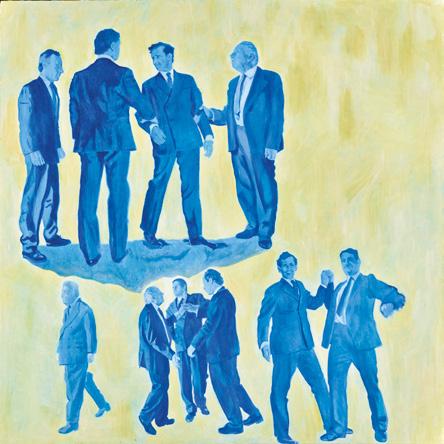
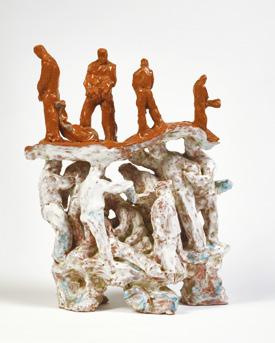
Lynn Dennison
Black Forest Cut-out Dress
Paper and wire
36 x 15 x 27 cm
Opposite, top
Cut-out Roses Dress
Paper and wire
85 x 21 x 33 cm
Opposite, bottom left
Cut-out Trees Jacket
Paper and wire
37 x 19 x 40 cm
Opposite, bottom right
Malaysian Cut-out Dress
Paper and wire
42 x 22 x 12 cm
All 2003–04
Lynn Dennison’s sculptures made of paper (sometimes painted or pre-printed), wire and textiles explore the connected themes of gender, identity, place and costume. Her technique of ‘fleshing out’ dresses with delicate white paper allows her to give each of her sculptures its own texture.
Cut-out Roses Dress is a wire-framed, floorlength, miniature paper dress for which Dennison has cut the silhouettes of roses and their leaves throughout the dress, as though nature is growing through and absorbing its femininity. For Black Forest Cut-out Dress the artist has cut out the silhouettes of evergreen ‘Christmas’ style trees, circling the dress in a spiral format, as though nature is rising up from the ground to absorb its unnatural form. Cut-out Roses Dress (2003–2004) can be seen to be exploring the way changing light can affect moods and perceptions, while in Cut-out Trees Jacket Dennison displays forms of winter and summer trees throughout the jacket, as though nature has been planted upon it.
Everyone can identify with the visual world Dennison creates, as it is a landscape of myth and memory that we all recognise and share. For her, an artwork is not the culmination of spiritual revelations about the landscape, but the embodiment of personal narratives and intimate histories. She acknowledges the importance of familial networks and formative experience in conditioning her creative response to the earth. Dennison’s Cut-out Dresses are questioning our innate connection with the Earth and hint that what remains here are the shadows, which stretch languorously across the exhibition wall, mocking us with their lost vitality.
Lynn Dennison’s four sculptures are an important addition to Tullie House’s collection. As a Cumbrian-born artist Lynn Dennison fits perfectly with the museum’s collecting priorities to represent established, emerging, and diverse Cumbrian artists. Her work also enables the museum to expand the collection of works by women artists and sculptors, which are both underrepresented. The museum is opening major new galleries devoted to the Tullie House Costume Collection and is actively expanding in line with this. Lynn Dennison’s sculptures will provide an important contemporary response. The natural motifs in her sculptures also relate to Cumbria, the most biodiverse county in England, to the museum’s recently designated Natural Science collection and to current debates around the environment and climate change.
Lynn Dennison (b. 1958, Penrith, Cumbria, UK) lives and works in London. Recent solo shows include Palazzo Pesaro Papafava, Venice (2019); Flowers Gallery, New York (2016); and De La Warr Pavilion, Bexhill on Sea (2015). Recent solo exhibitions include Groundworks, Kings Lynn (2019); Bush House Gallery, King’s College, London (2018); and Peninsula Arts, Plymouth (touring 2016/17). Dennison was the winner of Flickering Stone, Hidden Award (2018). In 2017/18 she was the Florence Trust Resident and in 2016/17 she was Artist in Residence, Research and Cultural Collections (Birmingham University).
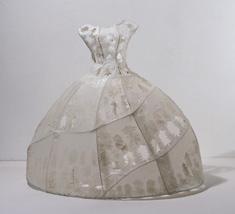


‘The Supreme Court was delighted with the involvement of CAS Consultancy in the commissioning of the new artwork, generously funded as part of Spark21’s First 100 Years project, in courtroom
2. This was a sensitive project, in a modern courtroom in a grade II* listed building, marking the 100th anniversary of women being able to practise in the law. Consultancy was able to simplify the whole process –which went from concept to reality in less than a year – by using their expertise to clarify the brief, identify who might be contenders for the commission and take on the whole burden of dealing with getting the commission realised and installed – acting as a liaison between commissioner, host site, artist, technical teams and communications. In the process the team expanded our knowledge of the range of art practices and responses to contemporary commissioning and ensured delivery of an artwork, which has enhanced the court as well as contributing to public education.’
Mark Ormerod, Chief Executive The Supreme Court of the United Kingdom‘Quintain approached CAS Consultancy in 2019 to discuss a significant art commission for the reception of our flagship office building at Wembley Park. They took us on a journey, introducing us to inspiring artists who each brought us such varied and exceptional concepts. We couldn’t be more delighted with the final piece by Vivien Zhang, it is extraordinary and the team guided us through the process seamlessly. We would like to thank CAS Consultancy for their guidance and outstanding knowledge.’
Jason Margrave, Executive Director of Development QuintainCAS Consultancy’s commitment to creating Great Art for Great Places has become increasingly visible over the past two years. With a host of new projects working at the intersection of public art, strategy, placemaking and programming, Consultancy is embedded in the new arts ecology that is emerging post-Covid.
We continue to support the charitable mission of the Contemporary Art Society with projects that put art and culture at the heart of public space, at a moment when discussion about the nature and uses of public realm has become personal as well as political. We have worked with our clients to locate opportunities for artists in what has been an incredibly unpredictable time, securing 18 artist commissions and managing budgets in excess of £1.6 million. As lockdown took hold, we expanded our work digitally, with a growing platform of online programming and thought leadership in the shape of webinars, talks and podcasts, which have connected more than 25 artists and arts and culture professionals with our audiences. Looking forward, we can see the tremendous possibilities for developing creative workplaces. As offices re-open, there will need to be more than IT support and a local coffee shop to entice workers back into the city. We know the power that art and culture have to transform working spaces: our work with a long-standing private investment firm expanded from the management of its excellent contemporary art collection to include three bespoke commissions from female European artists, each of which works with the unique character of the client’s offices to create a sense of dynamism in the workplace. Similarly, our collaboration with an international pensions investment board provided the opportunity to interact with a workforce of more than 150 people through the provision of a rolling exhibition programme from the likes of Olafur Eliasson, Sam Durant and John Gerrard, which included interaction with staff in the form of Lunch and Learn sessions, guided tours and informal publications. We brought artist Vivien Zhang to the new Wembley development’s flagship office to create a stunning new work at a scale and with techniques that are new to the painter. And our work continued with 22 Bishopsgate, the tallest building in the Square Mile, delivering new commissions from artists Ryan Mosley and Karine Laval that humanise the building’s vast reception spaces, both inside and from the street. We are continuously developing in a changing world, offering practical advice and guidance to workplaces as they re-align themselves with new agendas centring on inclusion, wellness and creativity.
Our work in the public realm has continued over the past two years. At the end of 2019, we proudly unveiled Catherine Yass’s work for the Supreme Court of the United Kingdom, which commemorates 100 years of women practising law in the UK, as well as the retirement of Lady Brenda Hale, the Court’s first female President. Yelena Popova’s tapestry for the Eddington development in North
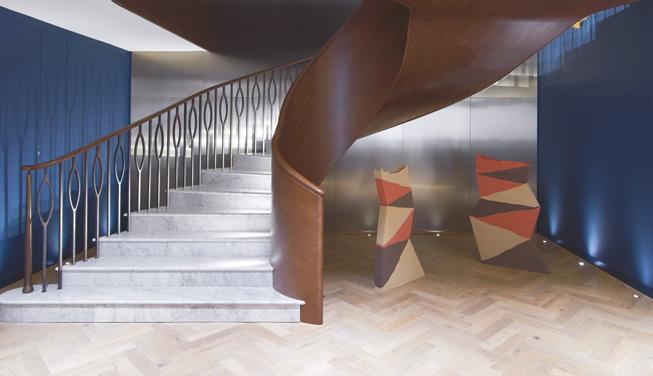


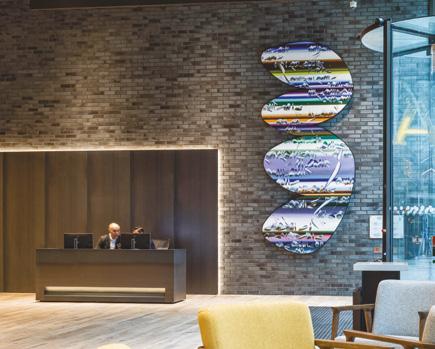
West Cambridge tells another story about the power of pioneering women in an examination of scientist Hertha Ayrton’s work at Cambridge. Tod Hanson’s Spectra, a seven-storey mural painted to coincide with the London School of Economics’ opening of the Rogers Stirk Harbour + Partners’ Centre Building development, considers the School’s commitment to social justice through the lens of the the famous Victorian maps of London poverty by Charles Booth. Our public commissioning is brave and expansive and we are proud to be associated with sharing inclusive stories in the public sphere, now more than ever.
Our commitment to socially driven placemaking is evidenced by our work online – we have been programming events, webinars and podcasts that reflect Consultancy’s unique stance as a part of the wider Contemporary Art Society charity. We developed a new format, Culture Matters, an on-going series addressing art and culture in the public realm, including Public Space After the Virus; Reclaiming the High Street and Commemoration or Confrontation, chaired events discussing some of the most pressing cultural issues of 2020/21 and Consultancy’s response as a thought leader. We have also set up a series of podcasts, Art & Law, a 50-minute format that brings artists and curators into discussion with legal professionals to consider best practice for commissioners, from Intellectual Property to non-fungible tokens. And we have hosted talks for our partners –
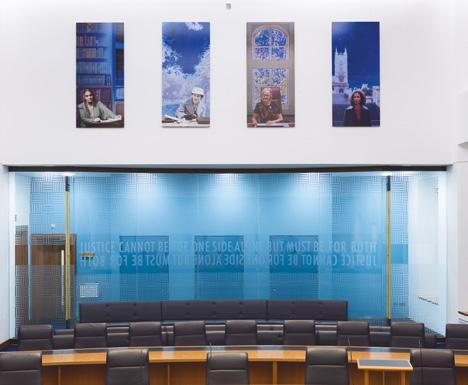


this spring we held a webinar as part of the Cambridge Festival, bringing the inspirational ArtScapers, with whom we have worked for years at Eddington, into conversation with art and education professionals for Children are Placemakers, an exploration of new educational models and the powerful benefits of child-centred design.
As we look forward, we can see the need for these new models. Covid-19 has changed us, as surely as the need to address climate change will in the coming years. Consultancy is proactively working to develop strategic thinking that aligns with our clients’ needs and is delivering new models for a new world. Our work developing the public art strategy for the University of Bristol addresses the need for porous public spaces that are inviting to all people, as befits a truly civic campus. We are working with the University to deliver four new public art commissions that will address the built environment and the people it serves. We completed our work for the Mayor’s Office on the Royal Docks Cultural Strategy, which now addresses one of the largest plots of disused land in Europe as a site for social and cultural activation and exchange. Our programme with Lendlease at Elephant Park resulted in a public art strategy that put nature and greening at the heart of its agenda. We are now beginning to deliver an artwork for the site with Ryan Gander leading the way in delivering a new programmatic model for co-creating with local communities. Likewise, our work with the Hawkins\Brown-led design team transforming the public realm of Smithfield in the City of London has resulted in Larry Achiampong being embedded as a resident artist in the team, a bold move that will deliver radical outcomes. And our work developing Wakefield’s expansive Public Art Framework is currently addressing the need for a post-Covid recovery for people via the public realm offer, from art cycle paths to walking art tour apps. This is the first strategy we have developed since the pandemic took hold and we have responded with a series of recommendations that align with new ways of bringing people back into public space.
This has been a period of immense change, so in many ways, it’s not surprising that Fabienne Nicholas, who has led Consultancy for nearly 14 years, has decided it’s time for a change of her own. Fabienne leaves behind a tremendous body of work and a team of Art Producers who share her vision of Great Art for Great Places. Fabienne will be dearly missed. Colin Ledwith is taking up the reins as Consultancy Head, having previously worked on the Crossrail art projects and with Futurecity before joining the team two years ago as its Deputy Head. Together, the Consultancy team is passionate about its mission and will continue to deliver its shared vision through groundbreaking work that tests the boundaries between art, culture, public good and strategic thought.

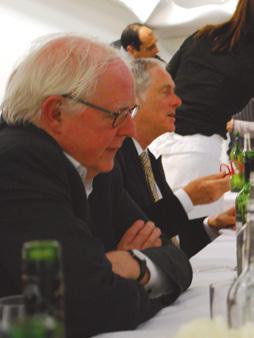
In 2019 the CAS lost a much-loved friend and formidable advocate in Richard Sykes. His commitment to the CAS and our mission, and his ever-thoughtful support, characterised the way he gave generously of his time and friendship. Richard and Penny made friendships with a number of emerging artists they met through the CAS and in this way and in many others his legacy will live on. We are grateful for the vital advice he gave us in setting up our Future Fund and will fondly remember his presence at so many CAS events.
We were deeply saddened to hear the news of our dear friend, patron and tireless event committee member Philippa Bradley who passed away in October 2020. She will be greatly missed by those many CAS members fortunate enough to have known her. Her vivacity and enthusiasm for our initiatives knew no bounds and we are forever grateful for her endorsement and ambassadorship over the past 16 years. Philippa, with husband and CAS trustee Michael, attended nearly every international trip and Philippa was a stalwart of our gala committees, from Gothic to the unforgettable Artist Table event with Grayson Perry at his studio. Our thoughts are with Michael and his family.

The generosity and active involvement of the Contemporary Art Society’s Supporters and Patrons continually enables our vital work with public museums and galleries, our open dialogue with artists, and a wide-ranging, engaging programme around contemporary art. We would like to thank the following individuals, organisations, trusts and foundations, who have made our charitable work possible from April 2019 –March 2021:
Arts Council England
Foyle Foundation
Emma & Fred Goltz
The Lord & Lady Lupton
Valeria Napoleone
The Sfumato Foundation
Jackson Tang
Cathy Wills
Anna Yang & Joseph Schull
Collections Fund 2019/20
Nicola Blake
Hugo Brown
Karin Cardiff
Emma Goltz
Jill Hackel (Co-chair)
Béatrice Lupton (Co-chair)
Pamela Stanger
Liese Van Der Watt
Cathy Wills
Anna Yang (Co-chair)
2020 Founder Supporters
Nicola Blake
Marco Compagnoni
Sarah Elson
Flora Fairbairn
Nicoletta Fiorucci
Emma Goltz
Sarah & Gerard Griffin
Soo & Jonathan Hitchin
Béatrice & James Lupton
Suling Mead
The Mbili Charitable Trust
Valeria Napoleone
Maureen Paley
Catherine Petitgas
The Search Foundation
Sfumato Foundation
Katrina & Stephen Reitman
Bianca & Stuart Roden
Dasha Shenkman OBE
Paul Smith
Christoph & Pamela Stangar
Cathy Wills
Edwin & Dina Wulfsohn
Anna Yang
Council
Marco Compagnoni
Bianca Roden
Muriel & Freddy Salem
Anita Zabludowicz OBE
Gold Patrons
Charlotte & Alan Artus
Michael & Philippa Bradley
Karin Cardiff
Debbie Carslaw
Bertrand Coste
Liesl Fichardt
Emma Goltz
Jill Hackel & Andrzej
Zarzycki
Soo Hitchin
Stephanie Holmquist & Mark Allison
Marelu Justus
Bertrand & Elisabeth Meunier
Keith Morris OBE & Catherine Mason
Tim & Andrew Pirrie-Franks
Bianca Roden
Dame Theresa Sackler
Bruce Sansom
Jacques Seguin
Edwin & Dina Wulfsohn
Anna Yang & Joseph Schull
Sarah Barker
Nicola Blake
Hugo Brown
Loraine Da Costa
Sarah Elson
Tom Epps
Margaret Erbe
Nicoletta Fiorucci
Antje Geczy
Sascha Hackel
Mark Harris
Harinder Hundle
Helen Janecek
Chris Jermyn
Linda Keyte
Chris Kneale
Martin le Huray
Béatrice Lupton
Sanda Mayzaw Lwin
Mauro Mattei
Suling Mead
Flavia Nespatti
Simon & Midge Palley
Adam Prideaux
Katrina Reitman
Marina Roncarolo
Susan Rosenberg & John Lazar
Dasha Shenkman OBE
Brian Smith
Paul Smith
Pamela Stanger
Emily Sun
Liese Van Der Watt
Marc & Brenda Vandamme
Janka Vazanova
Mercedes Vilardell
Audrey Wallrock
Clara & Percy Weatherall
Stella Weatherall
Cathy Wills
Mary Wolridge
Jonathan Wood
Bronze Patrons
Wolf & Carol Cesman
Jonaki Ah Teck
Marie Elena Angulo & Henry Zarb
Debra Blair
John Heller
Susie Tinsley
Young Patrons
Jeremy Achkar
Nicola Avery-Gee
Dehlia Barman
Valerie Blair
Deniz Guzel
Suwen Huang
Judy Ingber
Daria Kirsanova
Carali McCall
Benedetta Riva
Sophie Sofer
Honorary Patrons
Jean Cass
Sarah Griffin
Christopher Jonas CBE
Penny Mason
Elizabeth Meyer
Alison Myners
Valeria Napoleone
Mark Stephens CBE
Jackson Tang
Russell Tovey
The Artist’s Table Hosts
Edmund de Waal with Jill Hackel (November 2019)
Grayson Perry with Chris Kneale (March 2020)
Phyllida Barlow with Nicola Blake, Bertrand Coste, Emma Goltz, Sarah Griffin, Béatrice Lupton, Valeria Napoleone, Bianca Roden (November 2020)
Holiday Party Hosts
2019 party hosted by Marco Compagnoni
2020 virtual holiday quiz hosted by Nicola Blake and her committee; Charlotte
Artus, Yasmine Datnow, Sanda Maysaw Lwin, Suling Mead, Benedetta Riva, Paul Smith, Sophie Sofer and Susie Tinsley.
Development Board
Annette Anthony (until June 2019)
Charlotte Artus
Nicola Blake
Marco Compagnoni
Bertrand Coste
Emma Goltz (Chair)
Béatrice Lupton
Coralie Malissard (until December 2019)
Benedetta Riva
We are also grateful to our supporters who wish to remain anonymous.
Aspen
AXA
BioMed Realty
Canada Pension Plan Investment Board
City of London
Steering Committee for Humanitarian Aid Workers Memorial
Edyn
Goldman Sachs EMEA HQ
Inflexion Private Equity
Lendlease
Lipton Rogers Developments
London School of Economics and Political Science
Mayor of London
Quintain
Supreme Court of the United Kingdom
University of Bristol
University of Cambridge
Wakefield Council
Marco Compagnoni (Chair)
Nicola Blake
Michael Bradley
Shawanda Corbett
Tommaso Corvi-Mora
Simon Davenport
Sarah Elson (until September 2019)
Timothy Franks
Antje Géczy (until April 2019)
Emma Goltz
Soria Hamidi
Béatrice Lupton
Keith Morris OBE
Valeria Napoleone
Esther Layo Olayiwola (until June 2020)
Francis Outred
John Shield
Cathy Wills
Edwin Wulfsohn
Anna Yang
Staff
Caroline Douglas Director
Sophia Bardsley Deputy Director
Curatorial
Christine Takengny Senior Curator, Museum Acquisitions
Dr Ilaria Puri Purini Curator of Programmes
Vassilios Doupas Curator of Programmes (maternity cover)
Uma Karavadra Curatorial Trainee (until August 2020)
Jessica Lowe-Mbirimi Curatorial Trainee (from September 2020)
Tania Adams Collections Researcher
Ksenya Blokhina Image Rights Manager Development & External Relations
Dida Tait Head of Development & External Relations
Ruth Piper Senior Manager, Patrons & Development (until March 2020)
Ally Bennett Senior Manager, Development (from September 2020)
Meela Thurloway Assistant Manager, Development
Marcus Crofton
Senior Communications and Campaigns Manager
Art Consultancy
Fabienne Nicholas
Head of Art Consultancy
Colin Ledwith
Deputy Head of Art Consultancy
Jordan Kaplan Art Producer
Ailve McCormack
Art Producer
Megan O’Shea
Art Producer
Katharina Worf
Art Producer
Nina Lewis Consultancy Trainee
Administration Myles Burgess Administrator
Heather Forknell
Office Manager
Sonia Boyce, p.36
Alexandra Bircken, p.72
Steven Claydon, p.61
Lubna Chowdhary, p.74
Rabiya Choudhry, p.18
Shawanda Corbett, p.22
Michael Dean, p.61
Jeremy Deller, p.34
Frances Disley, p.54
Granby Workshop, p.52
Mona Hatoum, p.14
Claudette Johnson, p.26
Rachel Jones, p.42
Mary Kelly, p.68
Eleanor Lakelin, p.44
Zanele Muholi, p.56
Oscar Murillo, p.66
Harold Offeh, p.32
Phlegm, p.20
Keith Piper, p.40
Magali Reus, p.64
James Rigler, p.78
Rosanne Robertson, p.24
Margaret Salmon, p.28
Michelle Sank, p.46
Mike Silva, p.30
Matt Smith, p.48
John Akomfrah, p.86 and p.112
Elvira Bach, p.88
Rina Banerjee, p.120
Karla Black, p.82
Kaye Donachie, p.118
Joy Gerrard, p.96
Beatrice Gibson, p.114
Anne Hardy, p.132
Rosie Hastings & Hannah Quinlan p.92
Lubaina Himid, p.104
Chantal Joffe, p.130
Rachel Jones, p.134
Jeff Keen, p.122
Samson Kambalu, p.98
Matthew Krishanu, p.106
Simon Ling, p.84
Goshka Macuga, p.116
Jade Montserrat, p.138
Rosalind Nashashibi, p.126
Uriel Orlow, p.108
Katie Paterson, p.110
Thomas J. Price, p.102
Mark Titchner, p.90
Barbara Walker, p.94 and p.136
Charmaine Watkiss, p.100
Gillian Wearing, p.124
Lawrence Weiner, p.128
Sam Bakewell, p.160
Suzanne Berry, p.154
Morel Doucet, p.148
Malene Hartmann Rasmussen, p.144 and p.156
Alice Kettle, p.164
Lisa Krigel, p.146
Nao Matsunaga, p.162
Lawson Oyekan, p.158
Renee So, p.150
Esna Su, p.152
Gifts & Bequests
Edward Allington, p.172
Patricia Nichol Barnes, p.168
Lisa Brice, p.176
Lynn Dennison, p.188
Edmund de Waal, p.174
Matthew Krishanu, p.184
Haroon Mirza, p.178
Joanna Price, p.186
Catherine Yass, p.180, p.182
p.15 © Mona Hatoum.
Photography: White Cube (Theo Christelis)
p.19 © Rabiya Choudhry. Courtesy of the artist.
p.21 © Phlegm. Courtesy of the artist.
p.23 © Shawanda Corbett. Courtesy of the artist.
Photography: Marcus Leith.
p.25 © Rosanne Robertson. Courtesy of the artist and Wakefield Council Permanent Art Collection. Photography: Nick Singleton.
p.27 © Claudette Johnson. Courtesy of Hollybush Gardens.
Photography: Andy Keate.
p.29 © Margaret Salmon. Courtesy of Housework Films Ltd.
p.31 © Mike Silva. Courtesy of The Approach Gallery.
p.33 © Harold Offeh.
Photography: Helena Dolby.
p.35 © Jeremy Deller. Courtesy of the artist and The Modern Institute/Toby Webster Ltd., Glasgow.
p.37 © Sonia Boyce.
Photography: Michael Pollard.
p.41 © Keith Piper. Courtesy of the artist. Photography: Ilona Zielinska.
p.43 © Rachel Jones. Courtesy of Thaddaeus Ropac, London • Paris • Salzburg. Photography: Eva Herzog.
p.45 © Eleanor Lakelin. Courtesy of Sarah Myerscough Gallery.
Photography: Michael Harvey.
p.47 © Michelle Sank. Courtesy of the artist.
p.49 © Matt Smith. Courtesy of the Cynthia Corbett Gallery. Photography: Matt Smith.
p.53 © Granby Workshop.
p.55 © Frances Disley, Photography: Harry Meadley.
p.57, p.59 © Zanele Muholi. Courtesy of Stevenson, Cape Town and Johannesburg.
p.63, p.64 © Partnership with Henry Moore Foundation & Cathy Wills. Courtesy of the artists and Wakefield Council. Permanent Art Collection (The Hepworth Wakefield).
Photography: Lewis Ronald.
p.67 © Oscar Murillo. Photography: David Emeney for Bristol Culture & Creative Industries.
p. 69 © Mary Kelly. Courtesy of Pippy Houldsworth Gallery, London.
p.73 © Alexandra Bircken. Courtesy of the artist and Herald St, London. Photography: Andy Keate.
p.75 © Lubna Chowdhary. Photography: Nick Higgins.
p.69 © James Rigler
Fine Art
p.85 © Simon Ling. Courtesy of the artist and Greengrassi.
p.87 © John Akomfrah. Smoking Dogs Films. Courtesy Smoking Dogs Films and Lisson Gallery.
p.83 © Karla Black. Courtesy of the artist and Modern Art, London. Photography: Robert Glowacki.
p. 89 © Elvira Bach. Photography: Marion Schult.
p.91 © Mark Titchner. Courtesy of the artist.
p.93 © Rosie Hastings and Hannah Quinlan. Courtesy of the artists & Arcadia Missa. Photography: Tim Bowditch
p.95 © Barbara Walker. Courtesy of Cristea Roberts Gallery, London. Photography: Chris Keenan.
p.97 © Joy Gerrard. Courtesy of the artist, Cristea Roberts Gallery and Golden Thread Gallery. Photography: Simon Mills.
p.99 © Samson Kambalu. Courtesy of the artist and Kate MacGarry, London.
p.101 © Charmaine Watkiss. Courtesy of Tiwani Contemporary. Photography: Deniz Güzel.
p.103 © TP Studio. Courtesy of Thomas J Price Studio.
p.105 © Lubaina Himid. Courtesy of the artist. Photography: Andy Keate.
p.107 © Matthew Krishanu. Courtesy of the artist. Photography: Peter Mallet.
p.109 © Uriel Orlow. Courtesy of the artist.
p.111 © Katie Paterson. Courtesy of the artist. Photography: Ollie Harrop.
p.113 © Smoking Dogs Films; Courtesy Smoking Dogs Films and Lisson Gallery.
p.115 © Beatrice Gibson. Courtesy of the artist and Laura Bartlett.
p.117 © Goshka Macuga. Courtesy of the artist and Andrew Kreps Gallery, New York.
p.119 © Kaye Donachie. Courtesy of the artist and Maureen Paley, London/Hove.
p.121 © Rina Banerjee. Courtesy of the artist and Nathalie Obadia.
p.123 © The Estate of Jeff Keen. All rights reserved. Courtesy of Kate MacGarry.
p.125 © Gillian Wearing. Courtesy of Maureen Paley, London.
p.127 © Rosalind Nashashibi. Courtesy of Grimm Gallery.
p.129 © Lawrence Weiner. Courtesy of the artist.
p.131 © Chantal Joffe. Courtesy of the artist and Victoria Miro.
p.133 © Anne Hardy. Courtesy of Maureen Paley, London/Hove.
p.135 © Rachel Jones. Courtesy of Thaddaeus Ropac, London • Paris • Salzburg. Photography: Eva Herzog.
p.137 © Barbara Walker, 2020. Image courtesy of Cristea Roberts Gallery, London. Photography: Chris Keenan.
p.139 © Jade Montserrat. Courtesy of the artist and INIVA. Photography: George Torode.
Omega Fund
p.145 © Malene Hartmann Rasmussen. Photography: Sylvain Deleu p & p.
p.147 © Lisa Krigel Ceramics. Courtesy of the artist.
p.148 © Morel Doucet. Courtesy of the artist and Galerie Myrtis. Photography: David Gary Lloyd.
p.151 © Renee So. Courtesy of the artist and Kate MacGarry, London. Photography: Angus Mill.
p.153 © Esna Su. Courtesy of the artist.
p.155 © Suzanne Berry. Courtesy of the artist.
p.159 © Lawson Oyekan. Courtesy of the artist.
p.161 © Sam Bakewell. Courtesy of the artist and Corvi-Mora, London. Photography: Marcus Leith.
p.163 © Nao Matsunaga. Courtesy of the artist.
p.165 © Alice Kettle. Courtesy of the artist and Candida Stevens Gallery.
p.169 © Patricia Nichol Barnes. Courtesy of the estate of Patricia Nichol Barnes. Photography: Abigail Colling, York Museums Trust.
p.172, p.173 © Edward Allington. Courtesy of the Estate of Edward Allington.
p.174 © Edmund de Waal. Courtesy of the artist. Photography: Mike Bruce.
p.177 © Lisa Brice. Courtesy of the artist and Stephen Friedman Gallery. Photography Mark Blower.
p.179 © Haroon Mirza. Installation view at Museum Tinguely, Basel, © 2015 Museum Tinguely, Basel; Photography: Bettina Matthiessen.
p.181, p.183 © Catherine Yass. Courtesy of the artist.
p.185 © Matthew Krishanu. Courtesy of the artist and Niru Ratnam Gallery.
p.187 © Joanna Price. Guildhall Art Gallery, City of London Corporation, Image: Estate of Joanna Price.
p.189 © Lynn Dennison. Courtesy of Flowers Gallery.
p.194 Claire Hooper, Untitled (2020), commissioned for private investment client.
Photography: Andy Keate
p.194 Angelika Loderer, Untitled (ZZZ), 2019, commissioned for private equity client.
Photography: Andy Keate
p.195 Karine Laval, Heterotopia (2020) and Ryan Mosley, A Bishopsgate Story (2020), commissioned for 22 Bishopsgate.
Photography: Andy Keate
p.195 Vivien Zhang, Cartographer’s Fugue (2019), commissioned for Quintain.
Photography: Chris Winter
p.196 Catherine Yass, Legacy (2019), commissioned by Spark21 for the Supreme Court of the United Kingdom. Photography: Hugo Glendinning
p.197 Yelena Popova, RippleMarked Radiance (after Hertha Ayrton) (2019), commissioned for the University of Cambridge.
Photography: Robyn Butler
p.197 Cyprien Gaillard, View of Sighthill Cemetery (2008), exhibition loan from studio to pension investment board.
Photography: Andy Keate
p.199 Tod Hanson, Spectra (2020), commissioned for the London School of Economics and Political Science, London. Photography: Andy Keate